1. Calling a Bond Before Maturity
When it comes to investing, callable bonds can be both an attractive and complicated option. They are attractive because they often offer higher yields than non-callable bonds. However, callable bonds also come with a unique risk: the bond issuer may choose to call the bond before its maturity date. This means that the investor may receive their principal back earlier than expected, which can be a good thing in some scenarios, but it can also be a problem for investors who were counting on the bond to provide a steady stream of income. The investor's dilemma is whether to invest in a callable bond, knowing that it may be called early, or to invest in a non-callable bond, which may offer a lower yield.
Here are some key points to consider when faced with a callable bond:
1. The call date and call price: When investing in a callable bond, it's important to look at the call date and call price. The call date is the earliest date that the bond issuer can call the bond. The call price is the price at which the bond will be called. If the call price is lower than the current market price, the issuer is more likely to call the bond. On the other hand, if the call price is higher than the current market price, the issuer is less likely to call the bond.
2. The yield-to-call: The yield-to-call is the yield that the investor will receive if the bond is called at the first possible date. This is an important factor to consider when investing in callable bonds, as it can impact the investor's return. Investors should compare the yield-to-call to the yield-to-maturity, which is the yield that the investor will receive if the bond is held until maturity.
3. The reinvestment risk: If a callable bond is called early, the investor will have to find a new investment to replace the income from the bond. This can be a problem if interest rates have fallen since the bond was originally purchased, as the investor may have to accept a lower yield on a new investment.
4. The credit risk: Callable bonds are often issued by companies with lower credit ratings. This means that there is a higher risk of default, which can result in the investor losing their principal investment.
5. The tax implications: Investors should also consider the tax implications of investing in callable bonds. If a bond is called before its maturity date, the investor may have to pay taxes on any capital gains earned from the investment.
In summary, callable bonds can be a good investment option for investors looking for higher yields. However, they also come with a unique set of risks and challenges. Before investing in a callable bond, it's important to carefully consider the call date and price, the yield-to-call, the reinvestment risk, the credit risk, and the tax implications. By doing so, investors can make an informed decision about whether a callable bond is the right investment for their portfolio.
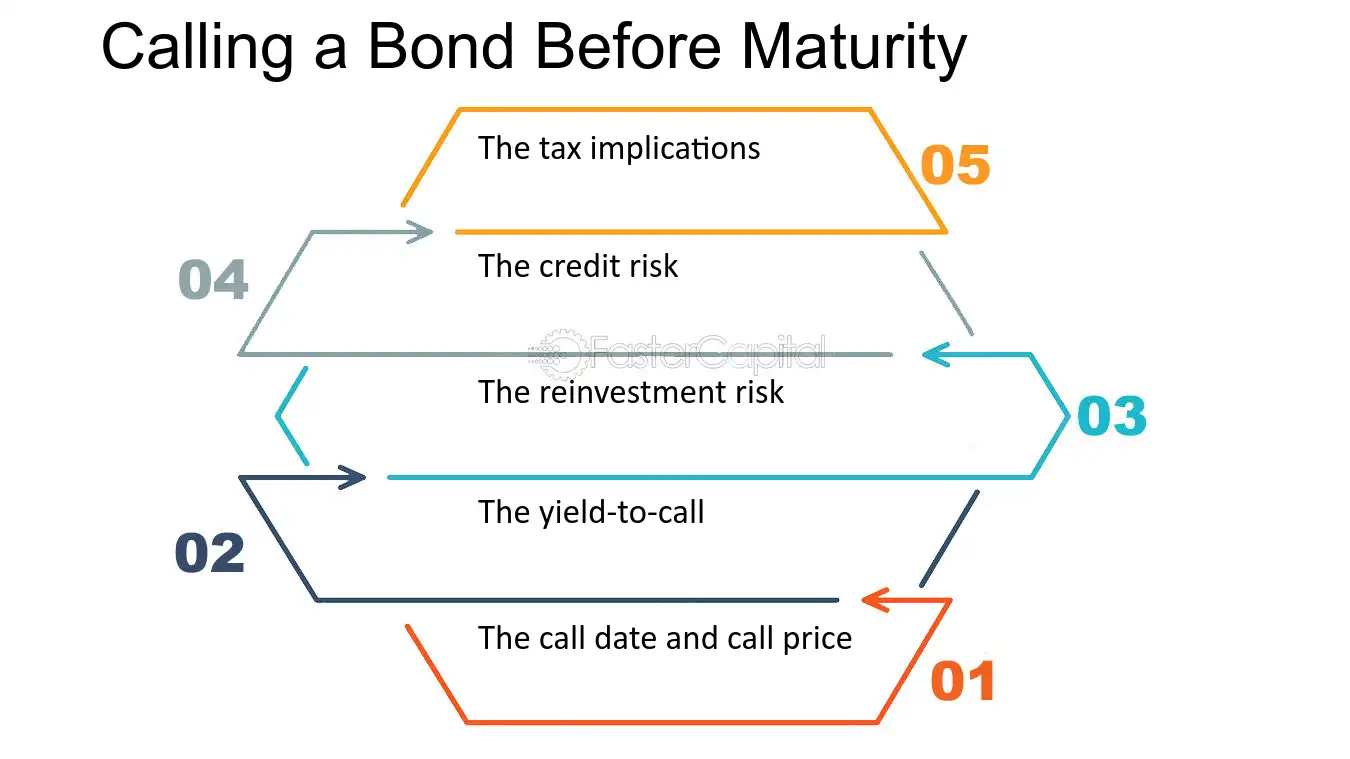
Calling a Bond Before Maturity - Accrued Interest and Callable Bonds: The Investor s Dilemma
2. Introduction to Bond Maturity Dates
When investing in bonds, it is crucial to understand the concept of maturity dates. A bond's maturity date refers to the date on which the issuer of the bond will repay the principal amount to the bondholder. This means that the bond will no longer be in effect after its maturity date, and the bondholder will receive the full face value of the bond.
2. Understanding Maturity Dates
Maturity dates are an essential aspect of bond investing as they determine the length of time an investor will hold the bond before receiving the principal amount. bonds can have various maturity dates, ranging from short-term to long-term. Short-term bonds typically have maturity dates within one to three years, while long-term bonds can have maturity dates that extend up to 30 years or more.
For instance, let's consider a hypothetical bond with a maturity date of 10 years. If an investor purchases this bond, they will hold it for the entire duration of the 10-year period. Once the maturity date is reached, the investor will receive the full face value of the bond. However, it is important to note that bond prices may fluctuate during the holding period, which can impact the overall return on investment.
3. Tips for Bond Maturity Dates
When considering bond maturity dates, here are a few tips to keep in mind:
- Match your investment goals: Choose bonds with maturity dates that align with your investment goals. If you have a short-term financial goal, opting for bonds with shorter maturity dates may be more suitable. On the other hand, if you have a long-term investment horizon, longer-term bonds may be a better fit.
- diversify your bond portfolio: Spread your investments across bonds with different maturity dates. This diversification strategy helps mitigate risk and ensures that you have a mix of short-term and long-term bonds in your portfolio.
- Consider reinvestment risk: When investing in bonds with shorter maturity dates, be aware of the reinvestment risk. Once the bond matures, you will need to reinvest the principal amount, and the prevailing interest rates at that time may be lower than what you initially earned. This can impact your overall return on investment.
4. Case Study: Bond Maturity Dates in Practice
To illustrate the importance of bond maturity dates, let's consider a case study. Imagine an investor who purchases two bonds: one with a maturity date of five years and another with a maturity date of 20 years. After five years, the bond with the shorter maturity date matures, and the investor receives the principal amount. However, the bond with the longer maturity date continues to accrue interest for another 15 years. This case study highlights how bond maturity dates impact the timing of receiving principal amounts and the duration of investment.
In conclusion, understanding bond maturity dates is crucial for bond investors. It helps determine the length of time an investor will hold a bond before receiving the principal amount. By aligning maturity dates with investment goals, diversifying bond portfolios, and considering reinvestment risks, investors can make informed decisions and maximize their returns in bond investing.
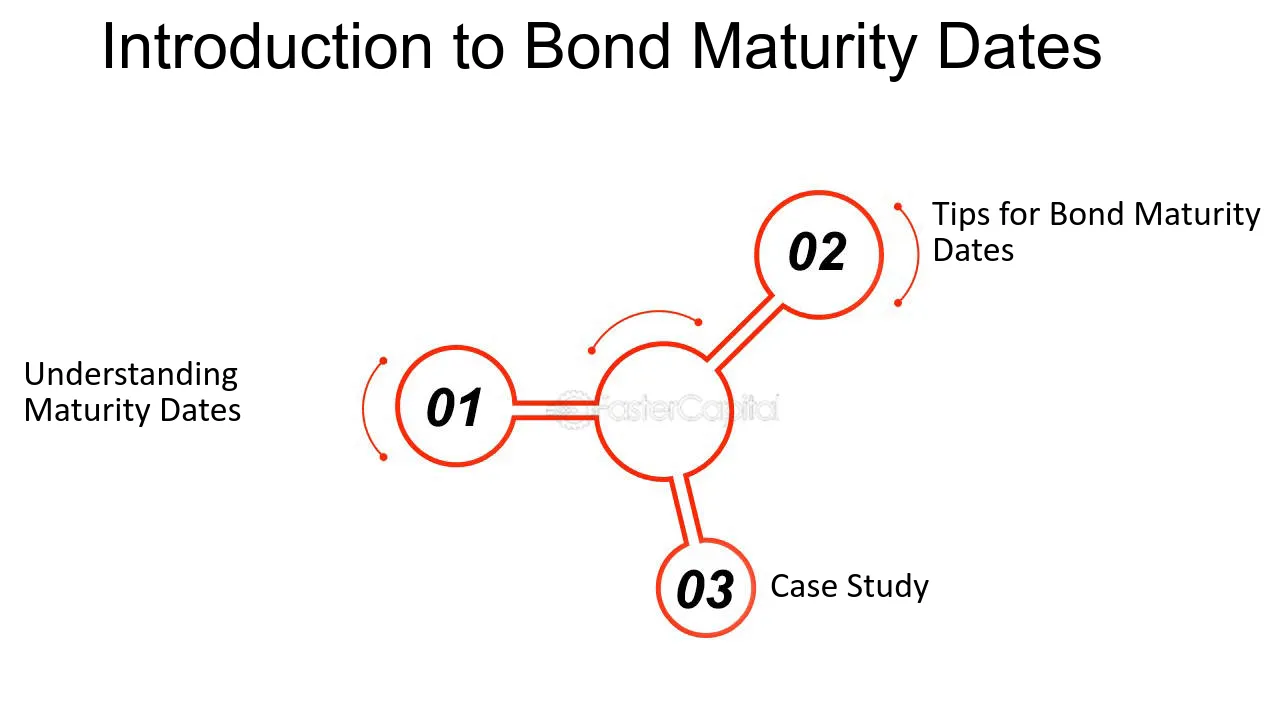
Introduction to Bond Maturity Dates - Bond: Understanding Maturity Date in Bond Investing
3. Types of Bond Maturity Dates
Short-term maturity dates refer to bonds that have a relatively short duration, typically ranging from a few months to a few years. These bonds are suitable for investors who prefer a quick return on their investment or have a shorter investment horizon. Short-term bonds are generally considered to be less risky compared to long-term bonds, as they are less susceptible to interest rate fluctuations and market volatility. For instance, Treasury bills (T-bills) are a popular example of short-term bonds, with maturities ranging from a few days to one year. These bonds are issued by the government and are considered to be one of the safest investment options available.
2. Medium-term Maturity Dates:
Medium-term maturity dates refer to bonds that have an intermediate duration, typically ranging from 5 to 10 years. These bonds are suitable for investors who are looking for a balance between risk and return. Medium-term bonds offer a higher yield compared to short-term bonds, as investors are committing their funds for a longer period. However, they also come with a degree of interest rate and inflation risk. Examples of medium-term bonds include corporate bonds and municipal bonds. Corporate bonds are issued by companies to raise capital, while municipal bonds are issued by state and local governments to fund public projects.
3. Long-term Maturity Dates:
Long-term maturity dates refer to bonds with longer durations, typically exceeding 10 years. These bonds are suitable for investors with a long-term investment horizon and a higher risk tolerance. Long-term bonds offer the potential for higher returns, but they also come with a higher level of risk. One of the key risks associated with long-term bonds is interest rate risk, as changes in interest rates can significantly impact the market value of these bonds. Examples of long-term bonds include government bonds, such as Treasury bonds and inflation-protected securities (TIPS).
Tips for Bond Investors:
- Diversify your portfolio: It is important to diversify your bond investments across different maturity dates. This helps to spread the risk and reduce the impact of interest rate fluctuations on your overall portfolio.
- Consider your investment goals: Before investing in bonds, consider your investment goals and time horizon. short-term bonds may be more suitable for investors with short-term goals, while long-term bonds may be better for those with long-term goals.
- Stay updated on market conditions: Keep an eye on interest rate movements and economic indicators that can impact bond prices. Understanding market conditions can help you make informed investment decisions.
Case Study:
Let's consider an example to illustrate the impact of bond maturity dates on investment returns. Suppose you have $10,000 to invest and are torn between investing it in a short-term bond with a maturity of one year and a long-term bond with a maturity of 20 years. The short-term bond offers an annual yield of 2%, while the long-term bond offers an annual yield of 4%.
If you invest in the short-term bond, you would earn $200 in interest over the course of one year. On the other hand, if you invest in the long-term bond, you would earn $400 in interest each year for 20 years, totaling $8,000 in interest over the bond's lifespan.
In this case, while the long-term bond carries more risk, it offers a significantly higher return compared to the short-term bond. However, it is important to consider your risk tolerance and investment goals before making a decision.
Remember, understanding the different types of bond maturity dates is crucial in bond investing. It allows you to align your investment strategy with your financial goals and risk tolerance.
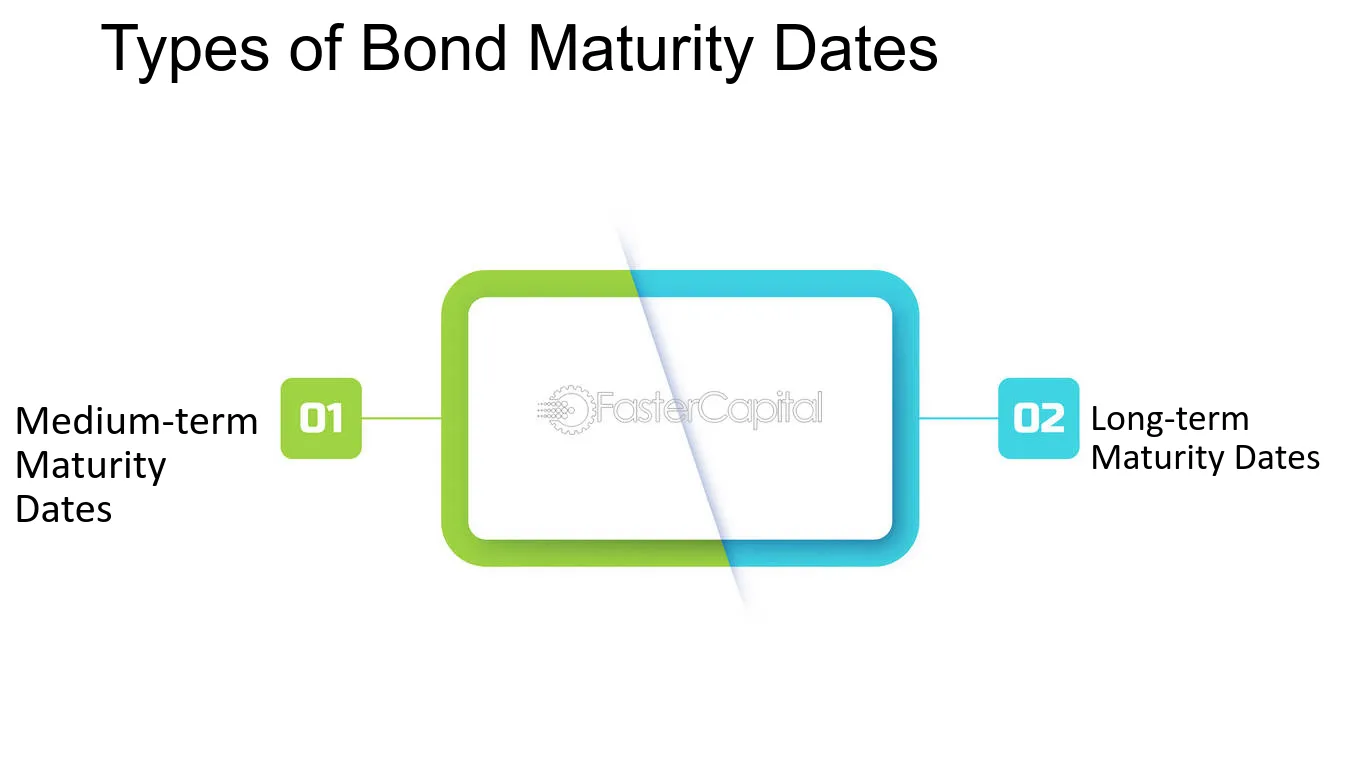
Types of Bond Maturity Dates - Bond: Understanding Maturity Date in Bond Investing
4. Understanding the concept of bond maturity and its importance in portfolio stability
Understanding the concept of bond maturity and its importance in portfolio stability:
When it comes to investing in bonds, one of the key factors to consider is the bond maturity. Bond maturity refers to the length of time until the bond issuer repays the principal amount to the bondholder. It is an essential aspect to understand as it greatly affects the stability and performance of a portfolio. By comprehending the concept of bond maturity, investors can make informed decisions and effectively manage their risk exposure.
1. Importance of Bond Maturity:
Bond maturity plays a crucial role in determining the stability of a portfolio. It allows investors to assess the time horizon of their investments and align them with their financial goals. Understanding the importance of bond maturity helps investors gauge the potential risks and rewards associated with different investment options.
2. Short-Term vs. long-Term bonds:
One of the primary considerations when it comes to bond maturity is the choice between short-term and long-term bonds. Short-term bonds typically have maturities ranging from one to five years, while long-term bonds can have maturities of ten years or more. Each option has its own advantages and disadvantages.
- Short-term bonds provide investors with more liquidity and flexibility. They offer relatively lower interest rate risk, as the principal is repaid sooner. This makes them suitable for investors who have near-term financial obligations or prefer a more conservative approach.
- On the other hand, long-term bonds generally offer higher interest rates, compensating investors for the extended maturity period. They can provide a steady stream of income over a longer period and may be suitable for investors with a longer time horizon and higher risk tolerance.
It is important to carefully consider one's financial goals and risk tolerance when deciding between short-term and long-term bonds.
Bond laddering is a strategy that involves diversifying bond investments across various maturities. This approach helps mitigate the impact of interest rate fluctuations and provides a consistent income stream. By spreading investments across different maturities, investors can reduce the risk of reinvesting all their funds at once when a bond matures.
For example, let's consider an investor who allocates a certain amount of funds to bonds with maturities of one year, three years, and five years. As each bond matures, the investor can reinvest the proceeds into a new bond with a longer maturity, maintaining a consistent income stream while minimizing the impact of interest rate changes.
Bond laddering offers the advantage of balancing the potential benefits of both short-term and long-term bonds. It provides stability through the consistent income generated by short-term bonds while taking advantage of the potentially higher yields offered by long-term bonds.
4. Consideration of interest Rate environment:
The prevailing interest rate environment is a crucial factor to consider when evaluating bond maturity options. In a rising interest rate environment, shorter-term bonds may be more favorable as they allow investors to reinvest at higher rates sooner. Conversely, in a declining interest rate environment, longer-term bonds may be more attractive as they lock in higher rates for an extended period.
It is important to monitor interest rate trends and adjust bond maturity allocations accordingly to optimize portfolio stability and returns.
Understanding the concept of bond maturity and its impact on portfolio stability is essential for investors seeking to build a well-diversified bond portfolio. By considering factors such as short-term vs. Long-term bonds, implementing a bond laddering strategy, and analyzing the interest rate environment, investors can make informed decisions that align with their financial goals and risk tolerance.
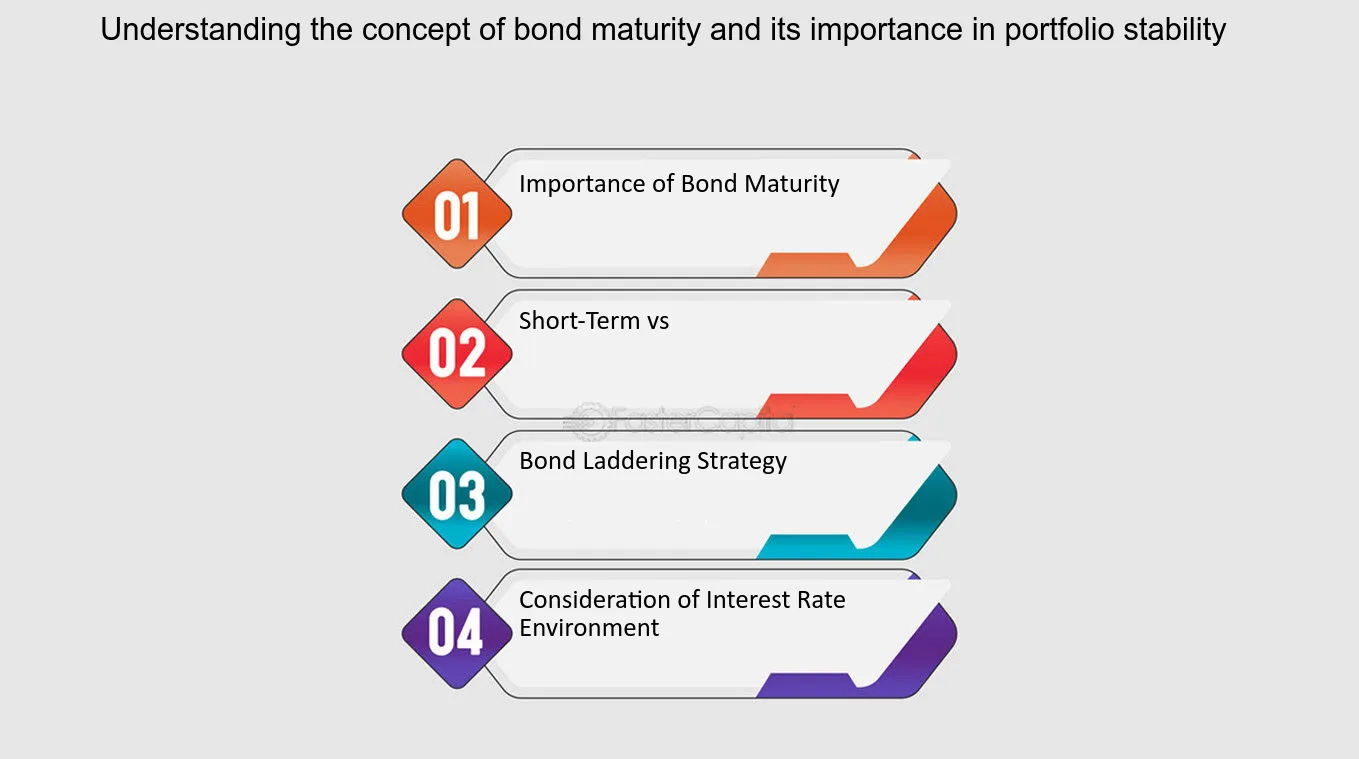
Understanding the concept of bond maturity and its importance in portfolio stability - Bond maturity: Enhancing Portfolio Stability through Bond Laddering
5. Introduction to Bond Maturity and Risks
Bond maturity is an essential concept when it comes to understanding the risks and returns of bond investments. It is the length of time until the bond issuer pays back the principal amount of the bond to the investor. Maturity can range from a few months to several decades and plays a crucial role in determining the bond's price and yield. Investors need to understand the concept of bond maturity to make informed decisions when investing in bonds. There are risks associated with investing in bonds, such as interest rate risk, credit risk, and liquidity risk. Understanding bond maturity helps investors manage these risks and maximize returns.
Here is an in-depth look at bond maturity and its associated risks:
1. Bond Maturity: It is the length of time until the issuer pays back the principal amount of the bond to the investor. The maturity date is specified in the bond's prospectus. Bonds with longer maturities are generally riskier than those with shorter maturities. This is because longer-term bonds are more exposed to the potential changes in interest rates that could affect their price and yield.
2. Interest Rate Risk: It is the risk that the bond's price will decrease when interest rates rise. When interest rates rise, bond prices generally fall, and when interest rates decline, bond prices generally rise. The longer the bond's maturity, the more significant the interest rate risk. For example, consider a 10-year bond with a 2% yield. If interest rates rise to 3%, new bonds will be issued with higher yields, making the 2% bond less attractive. As a result, the price of the bond will decrease.
3. credit risk: It is the risk that the bond issuer will default on its payments. This risk is higher for bonds issued by companies with low credit ratings or those in financial distress. When investing in bonds, investors need to consider the creditworthiness of the issuer to minimize credit risk. For example, a bond issued by a company with a high credit rating, such as Microsoft, is less likely to default than a bond issued by a company with a low credit rating.
4. Liquidity Risk: It is the risk that the investor will not be able to sell the bond when they want to or at a fair price. This risk is higher for bonds that are less actively traded or issued by companies with low credit ratings. The longer the bond's maturity, the higher the liquidity risk. For example, if an investor needs to sell a bond before its maturity date, they may have to sell it at a discount to attract buyers.
Understanding bond maturity and its associated risks is crucial for investors. While the bond market can be complex, investors can manage risks and maximize returns by investing in bonds with appropriate maturities and credit ratings. It is essential to conduct thorough research and analysis before investing in bonds to make informed decisions.
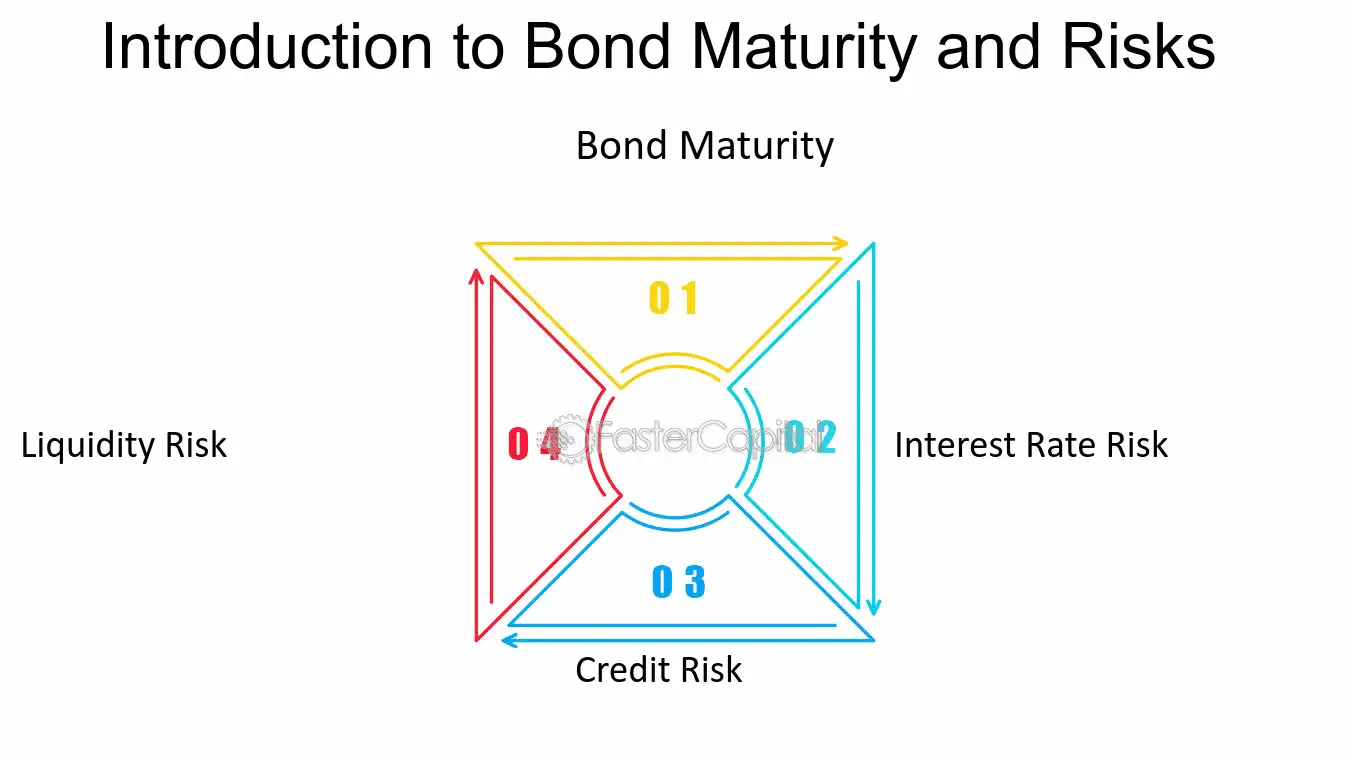
Introduction to Bond Maturity and Risks - Bond maturity: Managing Risk and Returns with Weighted Average Maturity
6. Understanding Bond Maturity
When it comes to investing in bonds, understanding bond maturity is essential. Bond maturity refers to the length of time from when the bond is issued to when it reaches its maturity date, at which point the issuer will pay back the principal amount to the bondholder. As an investor, it's important to understand how bond maturity works and how it affects your investment strategy. Different investors have different preferences for bond maturity, depending on their financial goals, risk tolerance, and investment horizon.
Here are some key points to consider when looking at bond maturity:
1. Short-term vs. long-term bonds: short-term bonds have a maturity of less than five years, while long-term bonds have a maturity of 10 years or more. Short-term bonds are generally considered less risky than long-term bonds because they are less exposed to interest rate fluctuations. However, long-term bonds offer higher yields and may be more appropriate for investors with a longer investment horizon.
2. yield curve: The yield curve is a graph that shows the relationship between bond yields and bond maturity. In a normal yield curve, longer-term bonds have higher yields than shorter-term bonds. However, when the yield curve is inverted, short-term bonds have higher yields than long-term bonds, which can be a sign of an impending recession. It's important to keep an eye on the yield curve when investing in bonds.
3. Reinvestment risk: Reinvestment risk refers to the risk that when a bond matures, the investor will not be able to reinvest the principal at the same rate of return. This risk is greater for short-term bonds because the investor has to constantly reinvest the principal, while long-term bonds have a fixed rate of return.
4. Call provisions: Some bonds have call provisions, which allow the issuer to call back the bond before maturity. This can be beneficial for the issuer if interest rates have fallen since the bond was issued, but it can be detrimental for the investor who loses out on future interest payments. It's important to check whether a bond has a call provision before investing.
In summary, understanding bond maturity is crucial for investors who want to make informed decisions about their bond investments. Short-term bonds are generally less risky, but long-term bonds can offer higher yields. The yield curve, reinvestment risk, and call provisions are all important factors to consider when investing in bonds. By taking these factors into account, investors can create a bond portfolio that aligns with their financial goals and risk tolerance.
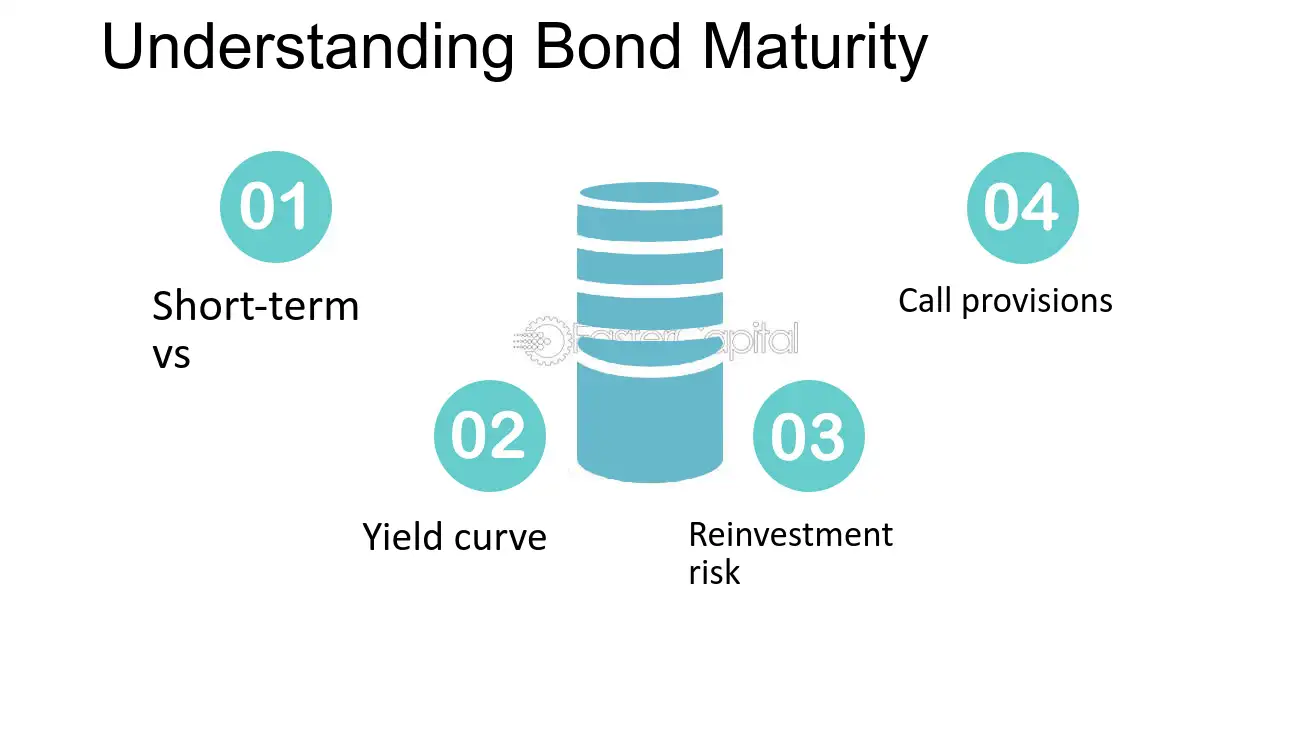
Understanding Bond Maturity - Bond Maturity: Navigating Treasury Bond Maturity Choices for Investors
7. Types of Treasury Bond Maturity
Investors who are looking to invest in bonds will inevitably encounter the concept of bond maturity. treasury bond maturity in particular is a crucial factor to consider when choosing which bonds to invest in. The maturity date of a bond refers to the date on which the bond issuer (in this case, the US government) will repay the bondholder the principal amount that was borrowed. The length of time between the issuance of the bond and its maturity date is called the bond's term. Treasury bonds come in a variety of maturities, ranging from short-term to long-term. Understanding the different types of Treasury bond maturity can help investors make an informed decision based on their investment goals, risk tolerance, and time horizon.
Here are some types of Treasury bond maturity:
1. Short-term Treasury bonds: These bonds have a maturity of one year or less. They are often referred to as Treasury bills (T-bills) and are considered to be the safest of all Treasury bonds. They have a lower yield compared to other Treasury bonds, but they are a good option for investors who want to park their money for a short period of time.
2. Intermediate-term Treasury bonds: These bonds have a maturity of one to ten years. They are also known as Treasury notes (T-notes). They offer a higher yield than T-bills but are not as risky as long-term bonds. They are suitable for investors who have a medium-term investment horizon.
3. Long-term Treasury bonds: These bonds have a maturity of more than ten years. They are also known as Treasury bonds (T-bonds). They offer the highest yield among all Treasury bonds but are the riskiest. They are suitable for investors who have a long-term investment horizon and are willing to take on more risk.
4. Inflation-protected Treasury bonds: These bonds, also known as Treasury Inflation-Protected Securities (TIPS), are designed to protect investors from inflation. They offer a fixed interest rate, but the principal amount is adjusted based on changes in the consumer Price index (CPI). They are suitable for investors who are concerned about inflation eroding the purchasing power of their investments.
5. Floating-rate Treasury bonds: These bonds have an interest rate that is tied to a benchmark rate, such as the London interbank Offered rate (LIBOR). The interest rate is adjusted periodically, which means that the yield on these bonds can fluctuate. They are suitable for investors who want to earn a variable interest rate and are comfortable with the associated risks.
Treasury bond maturity is an important factor to consider when investing in bonds. Understanding the different types of Treasury bond maturity can help investors choose the right bonds based on their investment goals, risk tolerance, and time horizon. By diversifying across different maturities, investors can create a balanced bond portfolio that suits their needs.
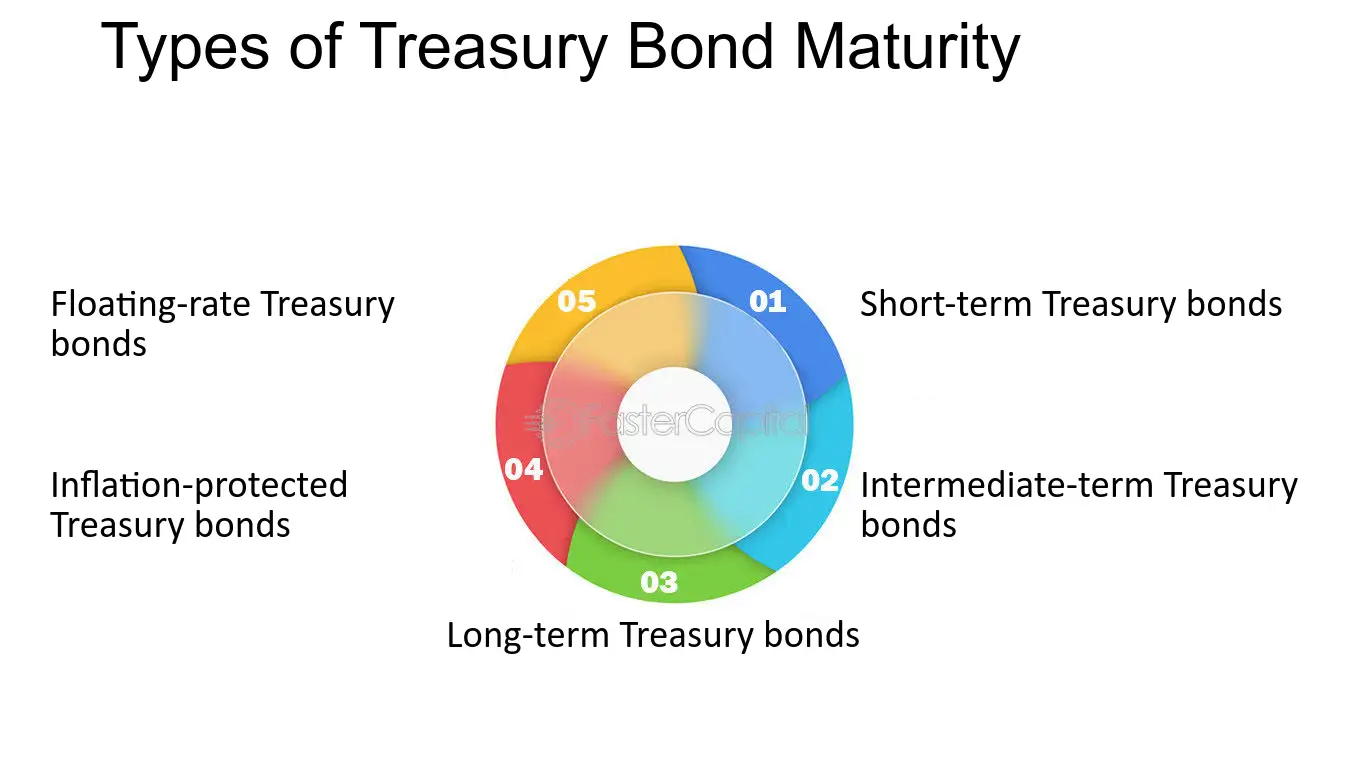
Types of Treasury Bond Maturity - Bond Maturity: Navigating Treasury Bond Maturity Choices for Investors
8. Introduction to Bond Maturity and Serial Bonds
Bond Maturity and Serial Bonds
Bond maturity refers to the length of time that a bond will exist before it is repaid to the bondholder. It is important to understand the concept of bond maturity because it helps an investor to make informed decisions about their investments. For instance, an investor can determine whether a bond is suitable for their investment portfolio based on the bond maturity date. One type of bond that is important to understand is a serial bond.
Serial bonds are a type of bond where the issuer repays a portion of the bond's principal each year. This means that the bond will have a series of maturity dates, with a portion of the bond being repaid each year until the final maturity date. Serial bonds are commonly used by municipalities and other government entities to finance large projects.
Here are some important things to know about bond maturity and serial bonds:
1. Bond Maturity Dates
Bond maturity dates can range from a few months to several decades. short-term bonds typically have a maturity date of less than five years, while long-term bonds can have a maturity date of 30 years or more. The longer the maturity date, the higher the risk associated with the bond. This is because there is a greater chance that the issuer will default on the bond before it reaches maturity.
2. Yield to Maturity
The yield to maturity (YTM) is an important concept to understand when investing in bonds. The YTM is the total return anticipated on a bond if it is held until it matures. It takes into account the bond's current market price, the coupon rate, and the time left until the bond matures. The YTM can help investors determine whether a bond is a good investment based on its potential return.
3. Advantages of Serial Bonds
Serial bonds have several advantages over other types of bonds. First, they allow issuers to spread out their debt payments over time, which can help to reduce the financial burden of a large project. Second, serial bonds can offer investors a predictable stream of income over the life of the bond. Finally, serial bonds can be easier to sell than other types of bonds because they have a series of maturity dates.
4. Disadvantages of Serial Bonds
While serial bonds have some advantages, they also have some disadvantages. One disadvantage is that they can be more complex than other types of bonds, which can make them harder for investors to understand. Additionally, serial bonds can have higher interest rates than other types of bonds because they are riskier. Finally, serial bonds can be more difficult to sell than other types of bonds because they have a series of maturity dates.
Understanding bond maturity and serial bonds is important for investors who are looking to diversify their investment portfolios. While serial bonds have some advantages, they also have some disadvantages. Investors should carefully consider their investment goals and risk tolerance before investing in serial bonds or any other type of bond.
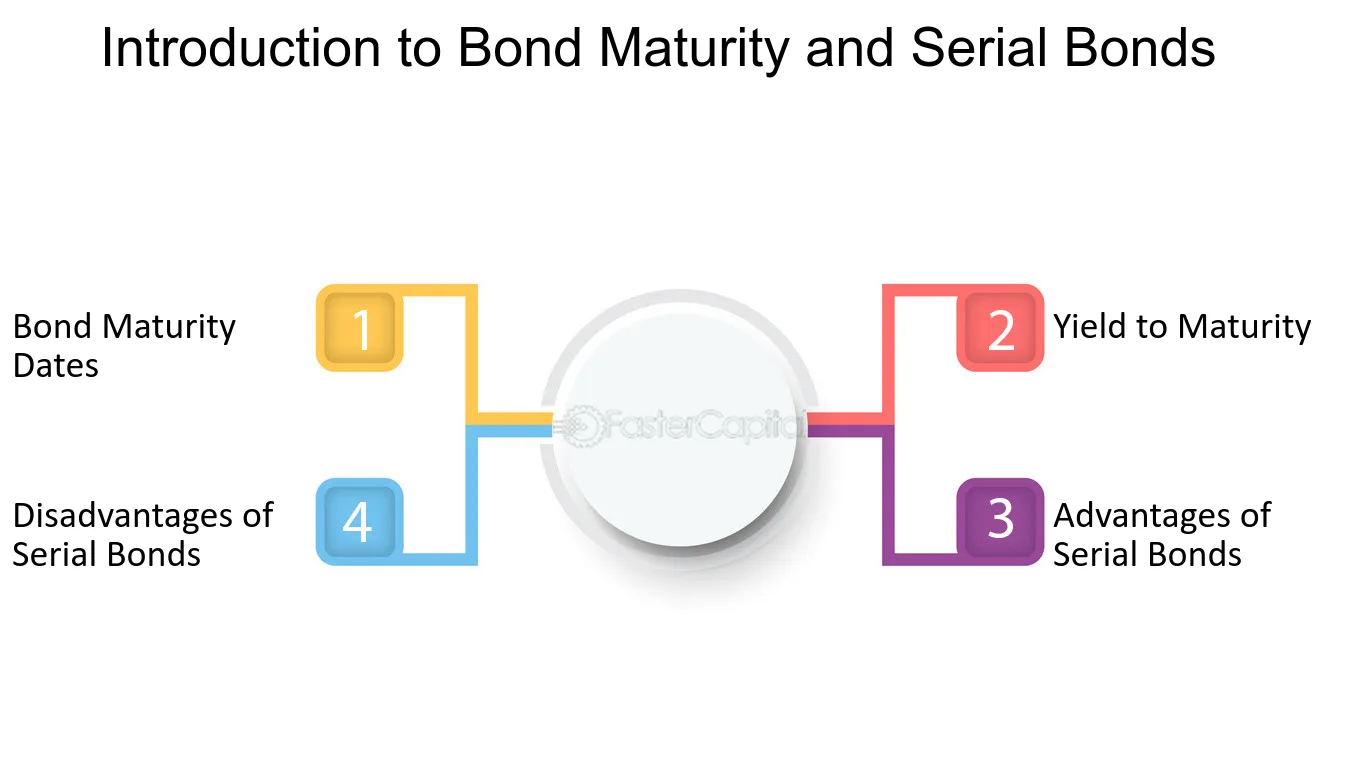
Introduction to Bond Maturity and Serial Bonds - Bond maturity: Serial Bonds and Maturity: A Closer Look at Bond Terms
9. Factors that Influence Bond Maturity and Serial Bond Structures
Factors that Influence Bond Maturity
When a bond is issued, the issuer specifies the maturity date, which is the date on which the principal amount of the bond must be repaid. The maturity date of a bond is influenced by several factors that the issuer must consider. These factors include:
1. interest rates: The interest rates prevailing in the market at the time of issuance of the bond play a significant role in determining its maturity. If interest rates are low, the issuer may want to issue a longer-term bond to take advantage of the low rates. Conversely, if rates are high, the issuer may issue a shorter-term bond to avoid paying high interest rates for a long period.
2. credit rating: The credit rating of the issuer also plays a role in determining the maturity of the bond. If the issuer has a good credit rating, it may be able to issue longer-term bonds at lower interest rates. This is because investors have more confidence in the issuer's ability to repay the bond. Conversely, if the issuer has a poor credit rating, it may have to issue shorter-term bonds at higher interest rates to attract investors.
3. Purpose of the Bond: The purpose of the bond also influences its maturity. If the bond is issued to fund a long-term project, such as the construction of a new facility, the issuer may want to issue a longer-term bond to match the project's duration. Conversely, if the bond is issued to fund a short-term project, such as the purchase of inventory, the issuer may issue a shorter-term bond.
Serial Bond Structures
Serial bonds are a type of bond structure where the principal amount of the bond is repaid in installments over a period of time. This structure is often used by issuers who have a large amount of debt to repay but do not want to issue a single, large bond. Serial bonds have several advantages, including:
1. Lower Interest Rates: Because serial bonds are repaid over a period of time, they are considered less risky by investors. This means that issuers can issue serial bonds at lower interest rates than they would be able to for a single, large bond.
2. Flexibility: Serial bonds offer greater flexibility to issuers than other bond structures. Issuers can tailor the repayment schedule to match their cash flow needs, which can help them manage their debt more effectively.
3. Diversification: Serial bonds allow investors to diversify their portfolios by investing in bonds with different maturities. This helps to spread the risk across different time periods and can lead to more stable returns.
Conclusion
Overall, the maturity of a bond and its structure are important considerations for both issuers and investors. By understanding the factors that influence bond maturity and the advantages of different bond structures, investors can make more informed investment decisions. Likewise, issuers can use this knowledge to structure their debt in a way that meets their financing needs while minimizing their cost of capital.
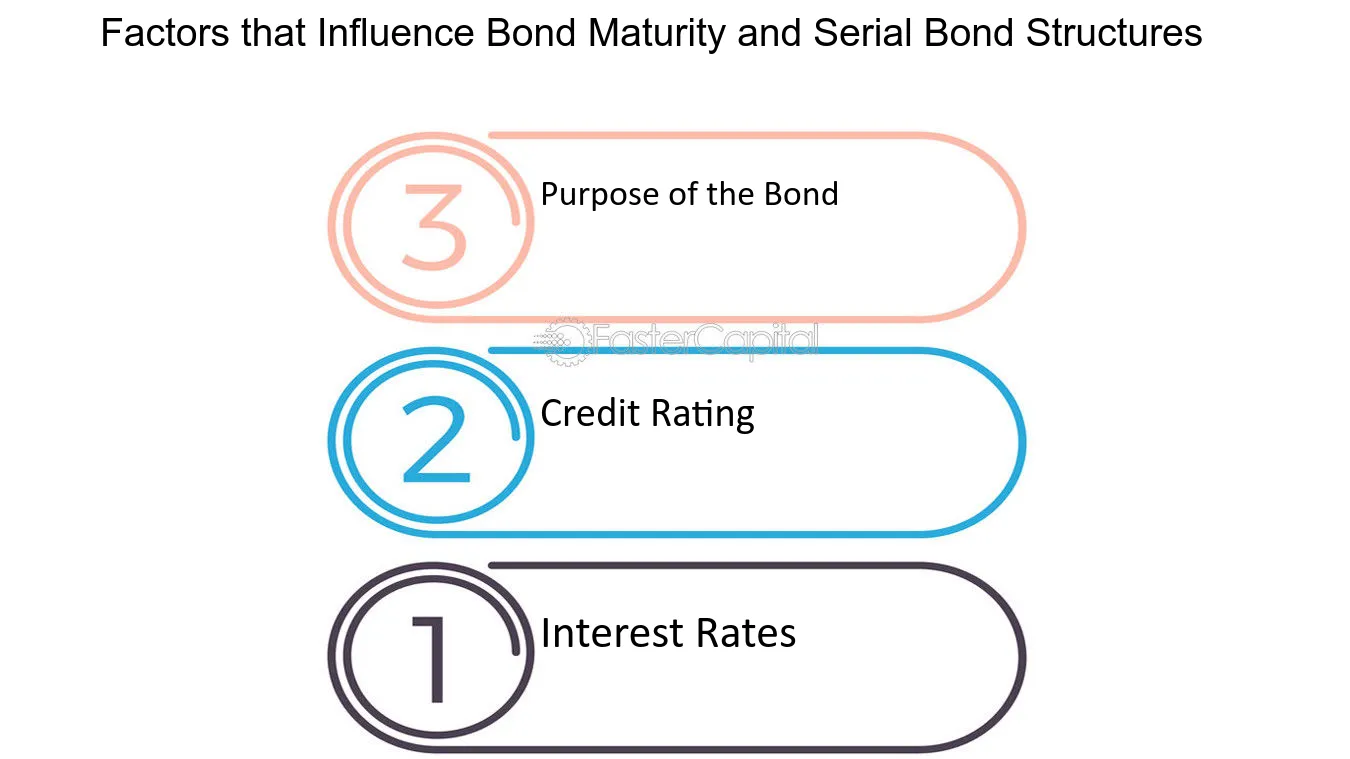
Factors that Influence Bond Maturity and Serial Bond Structures - Bond maturity: Serial Bonds and Maturity: A Closer Look at Bond Terms
10. Exploring the concept of bond maturity
Bond maturity refers to the length of time until the principal amount of a bond is repaid to the bondholder. It is an important concept to understand when investing in bonds, as it can have significant implications on the overall return and risk associated with the investment. In this section, we will explore the concept of bond maturity in detail, examining its various aspects and discussing the implications for investors.
1. Definition of Bond Maturity:
Bond maturity is typically expressed in terms of the number of years until the bond's principal is repaid. It represents the timeline for the bond's cash flows, including periodic interest payments and the final repayment of the principal. For example, a bond with a maturity of 10 years will make interest payments to the bondholder annually or semi-annually over the course of the 10-year period, with the principal amount being repaid at the end.
2. Impact on Yield and Price:
The maturity of a bond has a direct impact on its yield and price. Generally, longer-term bonds tend to offer higher yields compared to shorter-term bonds due to the increased risk associated with a longer time horizon. This is because longer-term bonds are exposed to a greater degree of interest rate risk, as changes in interest rates can significantly affect the present value of the bond's future cash flows. As a result, investors demanding higher yields for longer-term bonds drives the price down, making them more attractive.
3. Considerations for Investors:
When choosing a bond maturity, investors need to consider their investment objectives, risk tolerance, and market conditions. Shorter-term bonds, such as those with maturities of one to five years, are generally considered less risky and provide more liquidity. These bonds are suitable for investors with a shorter investment horizon or those seeking more stable income. On the other hand, longer-term bonds, with maturities of ten years or more, offer higher yields but are more exposed to interest rate fluctuations. They may be suitable for investors with a longer time horizon and a higher risk appetite.
4. Comparing Options:
To illustrate the impact of bond maturity, let's consider two hypothetical bonds issued by the same entity with different maturities. Bond A has a maturity of five years and offers a yield of 3%, while Bond B has a maturity of ten years and offers a yield of 4.5%.
- Bond A: With a shorter maturity, Bond A provides more certainty of cash flows over a shorter time period. This makes it an attractive option for conservative investors seeking stable income and greater liquidity.
- Bond B: On the other hand, Bond B offers a higher yield, compensating investors for the increased risk associated with the longer maturity. This option may be more suitable for investors with a longer investment horizon and a higher risk tolerance.
5. Best Option:
Determining the best option between Bond A and Bond B ultimately depends on the investor's individual circumstances and preferences. It is essential to carefully assess one's investment goals, risk tolerance, and market conditions before making a decision. While Bond A offers more stability, Bond B provides a higher yield potential. Investors should weigh these factors and consider diversifying their bond portfolio to include a mix of different maturities to manage risk effectively.
Understanding the concept of bond maturity is crucial for bond investors as it directly affects the return and risk associated with their investments. By considering various factors, such as investment objectives and market conditions, investors can make informed decisions about bond maturities that align with their financial goals.
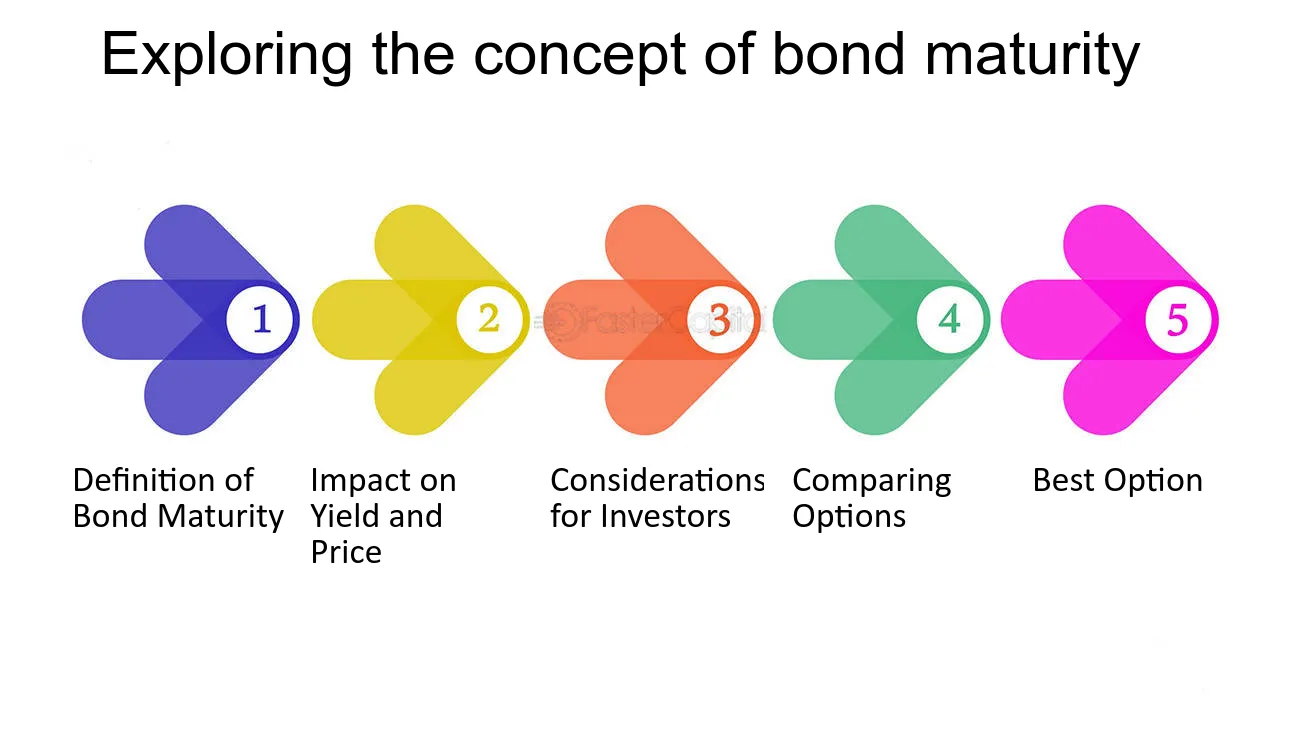
Exploring the concept of bond maturity - Bond maturity: Understanding Bond Lifecycles and Guaranteed Income Bonds
11. Introduction to Bond Maturity
When it comes to investing in bonds, one of the key factors to consider is bond maturity. Bond maturity refers to the length of time it takes for a bond to reach its full face value, at which point the bond issuer will repay the bondholder. understanding bond maturity is important because it can impact the value of your investment, as well as the amount of interest you earn. There are different types of bond maturity, including short-term, medium-term, and long-term.
To help you understand bond maturity and the factors that can impact it, we've put together a list of key insights:
1. Bond maturity is typically measured in years from the date of issue to the date of maturity. For example, if you buy a bond with a maturity date of 10 years from now, the bond will mature in 10 years.
2. short-term bonds typically have a maturity of one year or less, while medium-term bonds have a maturity of one to 10 years. long-term bonds have a maturity of more than 10 years.
3. The longer the bond maturity, the more sensitive the bond is to changes in interest rates. This means that if interest rates rise, the value of a long-term bond may decrease more than the value of a short-term bond.
4. The constant yield method is a way to calculate the value of a bond as it approaches maturity. This method takes into account the current market interest rates and the remaining time until maturity to determine the bond's present value.
5. Bond maturity can impact the amount of interest you earn. Generally speaking, longer-term bonds offer higher interest rates than shorter-term bonds. This is because longer-term bonds carry more risk, as the issuer could default on the bond over a longer period of time.
Overall, understanding bond maturity is an important part of investing in bonds. By considering factors such as the length of time until maturity, the type of bond, and the constant yield method, you can make informed decisions about your investments and potentially earn higher returns.
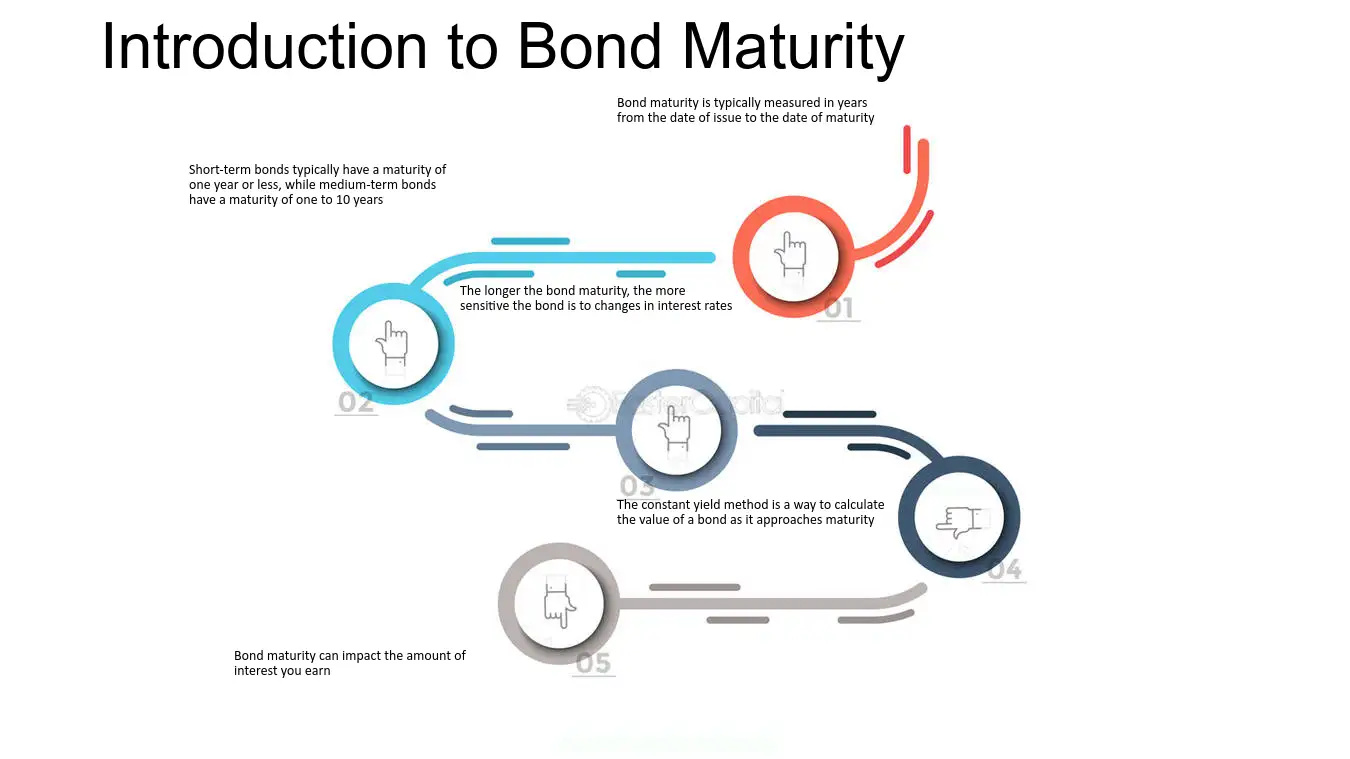
Introduction to Bond Maturity - Bond maturity: Understanding Bond Maturity and the Constant Yield Method
12. Factors that Affect Bond Maturity
When it comes to investing in bonds, one of the most important considerations is their maturity date. The maturity of a bond indicates the amount of time until the bond issuer repays the principal amount to the bondholder. The maturity date is an essential factor in determining the bond's value and the yield that the investor will earn. However, there are many factors that can affect bond maturity, and understanding these factors is crucial for any investor looking to make informed investment decisions.
Here are some of the factors that can affect bond maturity:
1. coupon rate: The coupon rate is the interest rate that the bond issuer pays to the bondholder. If a bond has a high coupon rate, it will generally mature quicker than a bond with a lower coupon rate. This is because the issuer will be paying more interest to the bondholder, which means that they will want to pay back the principal as soon as possible to avoid additional interest payments.
2. credit rating: The credit rating of the bond issuer can also affect bond maturity. If a bond issuer has a low credit rating, it may take longer for them to repay the principal amount, as they may have difficulty raising funds to repay the bondholders. This can result in longer maturity dates for bonds issued by companies with lower credit ratings.
3. Market Conditions: The overall market conditions can also affect bond maturity. For example, if interest rates are rising, it may take longer for bonds to mature, as the issuer will want to hold onto the funds for as long as possible to avoid having to issue new bonds at higher interest rates.
4. Call Provisions: Call provisions give the issuer the right to call the bond before the maturity date. If a bond has a call provision, it may mature earlier than expected if the issuer decides to call the bond.
5. Yield to Maturity: The yield to maturity is the total return anticipated on a bond if the bond is held until it matures. It takes into account the coupon rate, the price paid for the bond, and the time to maturity. Generally, bonds with higher yields to maturity will have longer maturity dates.
Understanding the factors that can affect bond maturity is essential for any investor looking to make informed investment decisions. By considering these factors, investors can better understand the risks and potential returns associated with investing in bonds.
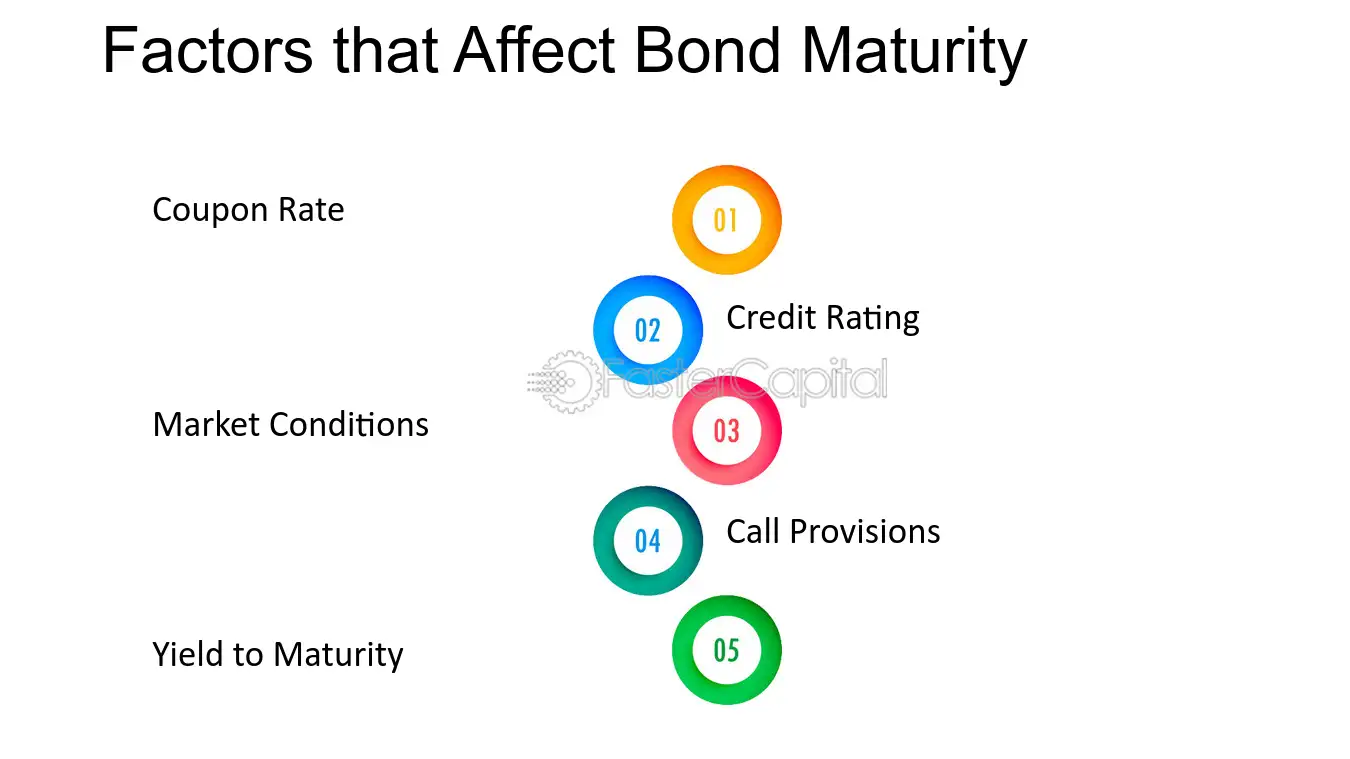
Factors that Affect Bond Maturity - Bond maturity: Understanding Bond Maturity and the Constant Yield Method
13. Bond Maturity vs Duration
Bond maturity and duration are two important concepts in the world of bond investments. While both terms are used to describe the length of time until a bond's payout, they represent different aspects of the bond's behavior. Bond maturity refers to the specific date when the bond issuer will repay the principal amount borrowed, while duration is a measure of how sensitive a bond's price is to changes in interest rates. Understanding the difference between these two concepts is critical to making informed investment decisions.
To start with, it is important to note that bond maturity and duration can be viewed from two different perspectives: that of the bond issuer and that of the bond investor. From the issuer's perspective, bond maturity is simply the length of time until they must repay the principal amount borrowed. For example, if a company issues a 10-year bond with a face value of $1,000, the bond matures in 10 years and the company will repay the $1,000 to the bondholder at that time.
From the investor's perspective, however, bond maturity is just one factor to consider when evaluating a bond investment. The other important factor is duration, which measures how much the bond's price is likely to change in response to changes in interest rates. A bond with a longer duration will be more sensitive to changes in interest rates than a bond with a shorter duration. This is because the longer the duration, the more time there is for interest rate changes to impact the bond's cash flows and, therefore, its value.
Here are some key points to keep in mind when considering bond maturity vs duration:
1. Bond maturity is an absolute value that represents the length of time until a bond's principal is repaid. Duration, on the other hand, is a measure of how sensitive a bond's price is to changes in interest rates.
2. Bonds with longer maturities tend to have higher yields, but they are also riskier investments because they are more sensitive to changes in interest rates.
3. The relationship between bond prices and interest rates is inverse. When interest rates rise, bond prices fall, and vice versa. The longer the duration of a bond, the greater its price sensitivity to changes in interest rates.
4. Short-term bonds tend to have lower yields than long-term bonds, but they are also less risky because they are less sensitive to changes in interest rates.
5. Bonds with shorter maturities and lower durations are often favored by investors who are looking for stable, predictable income streams without taking on too much risk.
Understanding the difference between bond maturity and duration is critical to making informed investment decisions. While bond maturity represents the absolute length of time until a bond's payout, duration is a measure of how sensitive the bond's price is to changes in interest rates. By considering both factors, investors can make more informed decisions about which bonds to invest in and how to manage their bond portfolios.
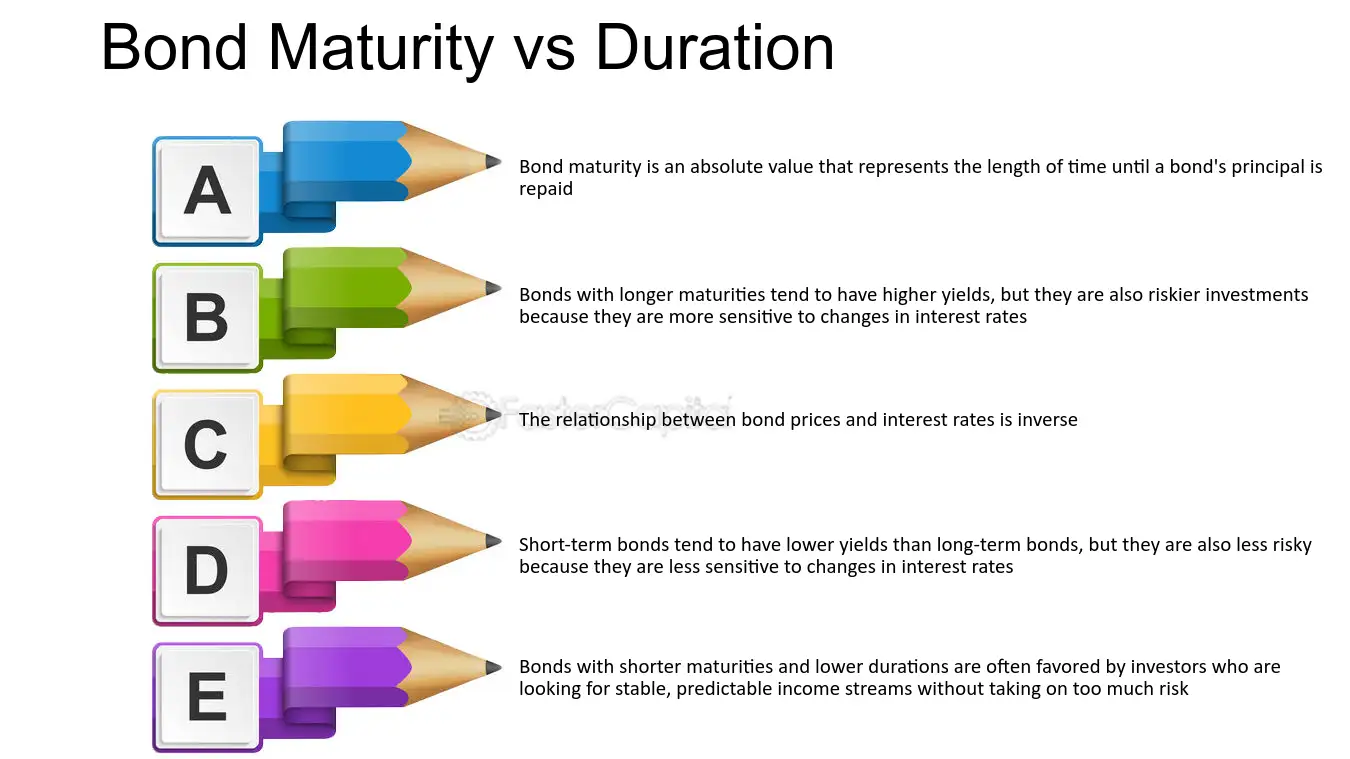
Bond Maturity vs Duration - Bond maturity: Understanding Bond Maturity and the Constant Yield Method
14. Types of Corporate Bond Maturity Dates
When investing in corporate bonds, one of the most important factors to consider is the maturity date. The maturity date refers to the date on which the bond issuer is required to pay back the principal amount to the bondholder. Depending on the maturity date of the bond, investors can evaluate the risk and yield associated with it. Different types of corporate bond maturity dates offer different advantages and disadvantages for investors. In this section, we will discuss the different types of corporate bond maturity dates.
1. Short-term Maturity Dates: These bonds have a maturity period of less than three years. They typically offer lower yields but are considered less risky than long-term bonds. Short-term bonds are suitable for investors who are looking for a low-risk investment option with a steady income stream. For example, a company may issue a short-term bond to finance a specific project or to meet its short-term cash flow requirements.
2. Intermediate-term Maturity Dates: These bonds have a maturity period of three to ten years. They offer a moderate yield and a moderate level of risk. Intermediate-term bonds are suitable for investors who are willing to take on a little more risk in exchange for a higher yield. For example, a company may issue an intermediate-term bond to finance a major expansion project.
3. Long-term Maturity Dates: These bonds have a maturity period of more than ten years. They offer a higher yield but may be riskier than short-term or intermediate-term bonds. Long-term bonds are suitable for investors who are willing to take on a higher level of risk for the potential of a higher return. For example, a company may issue a long-term bond to finance a major acquisition or to fund its research and development activities.
The maturity date of a corporate bond is an important factor to consider when evaluating the risk and yield associated with it. Investors should carefully consider their investment objectives and risk tolerance before investing in any type of corporate bond.
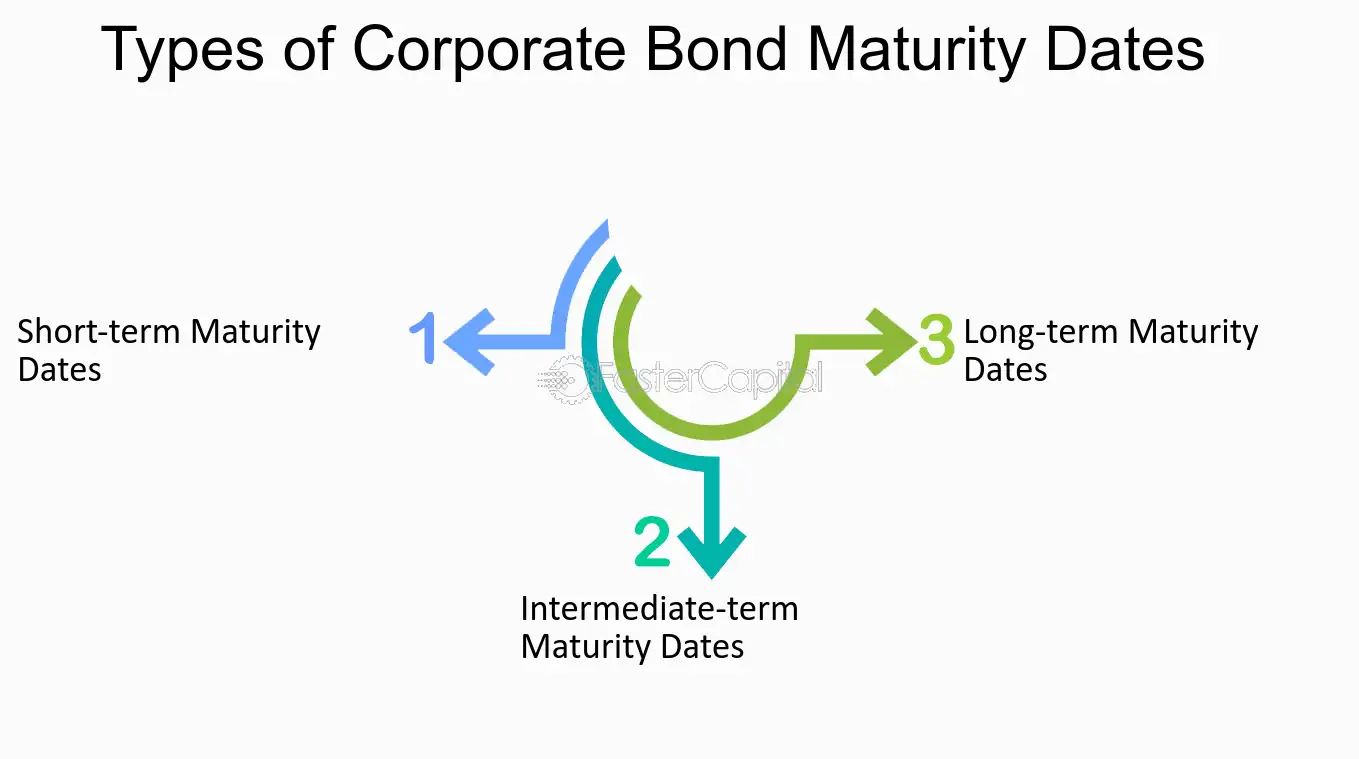
Types of Corporate Bond Maturity Dates - Corporate bond: Corporate Bond Maturity Dates: Evaluating Risk and Yield
15. Factors that Affect Corporate Bond Maturity Dates
Corporate bond maturity dates play a critical role in determining the risk and yield of a bond. The maturity date refers to the date when the bond issuer is required to pay back the principal amount to the bondholder. The maturity date can vary significantly depending on the type of bond, issuer, and market conditions. Typically, a longer maturity date implies a higher level of risk and a higher yield, while a shorter maturity date implies a lower level of risk and a lower yield.
There are several factors that affect corporate bond maturity dates, including:
1. Issuer credit risk: The creditworthiness of the bond issuer is a critical factor that can influence the maturity date of a corporate bond. Bond issuers with a higher credit rating are likely to have lower borrowing costs and can issue longer-term bonds. In contrast, bond issuers with a lower credit rating may face higher borrowing costs and may issue shorter-term bonds to reduce their risk exposure.
2. Market conditions: Market conditions such as interest rates, inflation, and economic growth can significantly impact the maturity date of a corporate bond. When interest rates are low, bond issuers may issue longer-term bonds at a lower cost. In contrast, when interest rates are high, bond issuers may issue shorter-term bonds to avoid the risk of rising interest rates.
3. Investor demand: Investor demand for a particular type of bond can impact its maturity date. If investors are willing to invest in longer-term bonds, bond issuers may issue longer-term bonds to meet this demand. Similarly, if investors prefer shorter-term bonds, bond issuers may issue shorter-term bonds to meet this demand.
4. Bond covenants: Bond covenants refer to the terms and conditions of a bond issue, including the maturity date. Bond covenants can vary significantly depending on the type of bond and issuer. For example, some bonds may have call provisions that allow the issuer to redeem the bond before the maturity date. In contrast, other bonds may have put provisions that allow the bondholder to sell the bond back to the issuer before the maturity date.
In summary, corporate bond maturity dates play a critical role in determining the risk and yield of a bond. Understanding the factors that affect maturity dates can help investors evaluate the risk and return of a bond investment and make informed investment decisions.
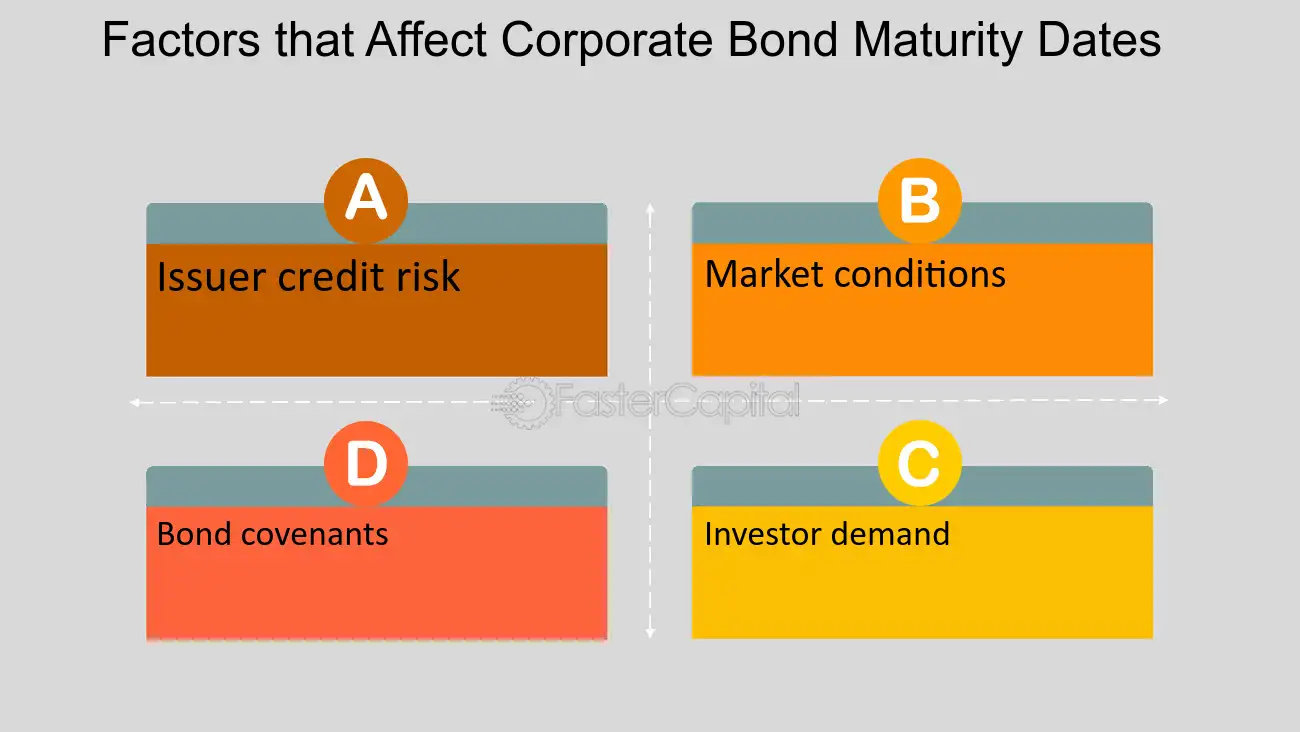
Factors that Affect Corporate Bond Maturity Dates - Corporate bond: Corporate Bond Maturity Dates: Evaluating Risk and Yield
16. Examples of Corporate Bond Maturity Dates and Yield Calculation
When investing in corporate bonds, one of the most important factors to consider is the maturity date. The maturity date is the date when the bond issuer will repay the bond's principal to the bondholder. It is important to evaluate the risk and yield associated with a bond based on its maturity date. Some investors prefer short-term bonds, while others prefer long-term bonds. It is important to know the different types of corporate bond maturity dates and how they are calculated to make informed investment decisions. In this section, we will discuss examples of corporate bond maturity dates and yield calculation.
1. Short-term bonds: These bonds have a maturity date of less than one year. They are considered less risky than long-term bonds as they are less susceptible to interest rate changes. However, they typically have lower yields than long-term bonds. For example, a bond with a maturity date of six months and a yield of 2% would provide a return of 1% over a three-month period.
2. Medium-term bonds: These bonds have a maturity date of one to ten years. They are considered to have moderate risk and moderate yield. The yield on these bonds is typically higher than short-term bonds but lower than long-term bonds. For example, a bond with a maturity date of five years and a yield of 4% would provide a return of 20% over the life of the bond.
3. Long-term bonds: These bonds have a maturity date of greater than ten years. They are considered to have the highest risk and the highest yield. The yield on these bonds is typically higher than short-term and medium-term bonds. However, they are more susceptible to interest rate changes and inflation. For example, a bond with a maturity date of twenty years and a yield of 6% would provide a return of 120% over the life of the bond.
4. Yield calculation: The yield on a bond is the return an investor will receive over the life of the bond. It is calculated by dividing the annual interest payment by the price of the bond. For example, if a bond has a face value of $1,000, a coupon rate of 5%, and is currently trading at $950, the yield would be 5.26%. This calculation assumes that the bond will be held until maturity and that all interest payments will be reinvested at the same rate.
Understanding the different types of corporate bond maturity dates and yield calculation is important for making informed investment decisions. It is important to consider the risk and yield associated with each type of bond and to have a diversified portfolio to mitigate risk.
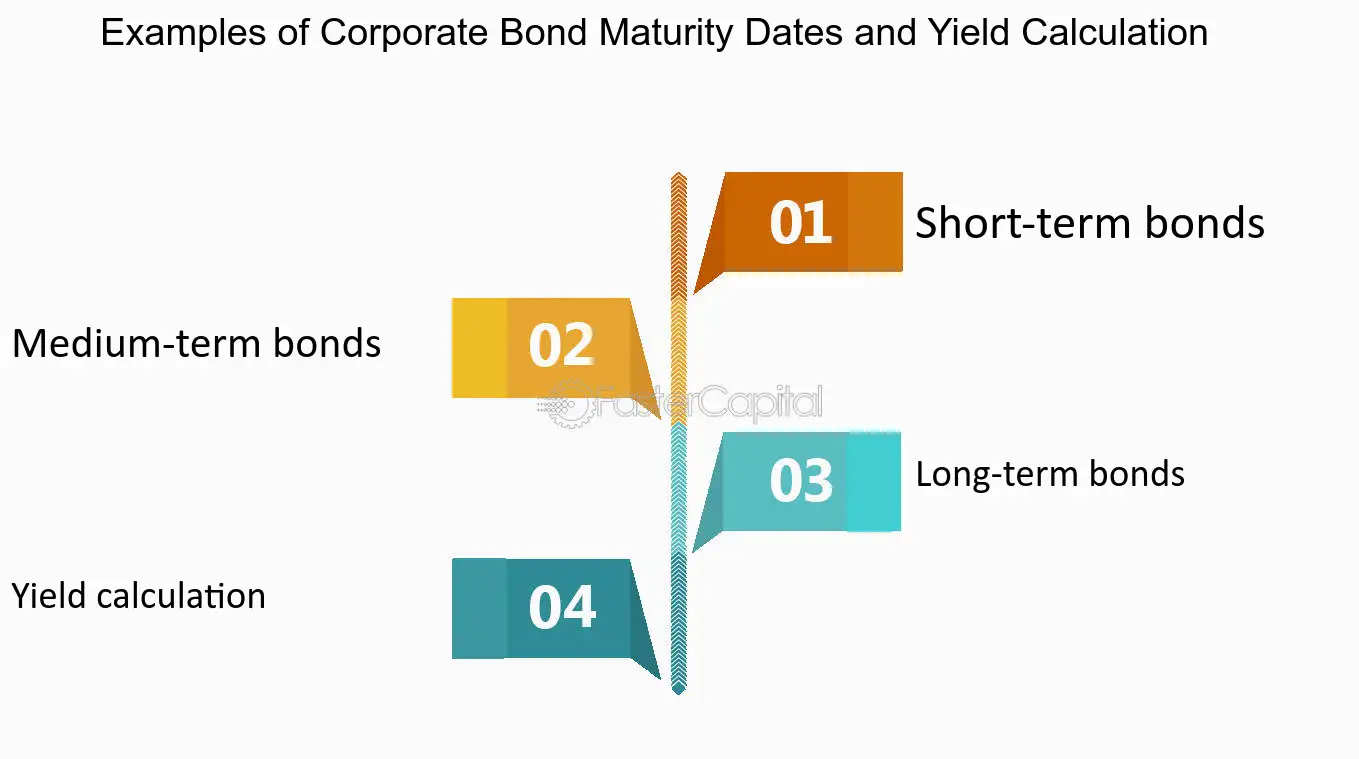
Examples of Corporate Bond Maturity Dates and Yield Calculation - Corporate bond: Corporate Bond Maturity Dates: Evaluating Risk and Yield
17. Examining the Timeline Leading to Bond Maturity
As bondholders eagerly anticipate the expiration of their investments, it is crucial to understand the timeline leading to bond maturity. This section delves into the various stages of a bond's lifecycle, shedding light on the significance of each step and the implications for both issuers and investors.
1. Issuance: The first step in the countdown to bond maturity is the issuance of the bond. This occurs when a company or government entity seeks to raise funds by issuing debt securities to investors. The terms of the bond, including the maturity date, coupon rate, and principal amount, are established during this stage. For example, a corporation may issue a 10-year bond with an annual coupon rate of 5% and a face value of $1,000.
2. trading and Secondary market: Once a bond is issued, it can be traded in the secondary market. Investors who wish to liquidate their positions or acquire additional bonds can do so through exchanges or over-the-counter transactions. The price of a bond in the secondary market fluctuates based on various factors such as interest rates, credit risk, and market conditions. For instance, if interest rates rise, the price of a bond with a fixed coupon rate may decline as new bonds with higher yields become available.
3. Coupon Payments: Throughout the life of a bond, periodic coupon payments are made to bondholders. These payments represent the interest owed to investors based on the coupon rate and the face value of the bond. For instance, if an investor holds a bond with a 5% coupon rate, they will receive $50 annually for every $1,000 face value of the bond. These coupon payments provide investors with a steady stream of income until the bond reaches maturity.
4. Call Provisions: Some bonds may include call provisions, which allow the issuer to redeem the bond before its maturity date. This gives issuers the flexibility to refinance their debt if interest rates decline or if they no longer require the funds raised. However, from an investor's perspective, call provisions can be a double-edged sword. On one hand, they provide the opportunity for early redemption and potentially higher returns if the bond is called at a premium. On the other hand, they introduce uncertainty and the risk of reinvesting the proceeds at a lower interest rate.
5. Default Risk: One crucial aspect of bond maturity is the risk of default. Default occurs when the issuer fails to meet its obligations, either by missing coupon payments or failing to repay the principal amount at maturity. Investors assess the default risk by considering factors such as the issuer's credit rating, financial health, and industry dynamics. Bonds with higher default risk typically offer higher yields to compensate investors for the added risk. For example, a corporate bond issued by a financially troubled company may have a higher yield compared to a government bond with a lower default risk.
6. Maturity: Finally, the countdown culminates in the maturity date, the point at which the bond expires, and the principal amount is repaid to bondholders. At this stage, investors have the option to reinvest the proceeds or pursue other investment opportunities. Maturity can be a significant event for both issuers and investors, as it marks the end of the contractual obligations and potential changes in financial strategies for both parties.
As the timeline leading to bond maturity unfolds, investors and issuers must navigate the various stages with careful consideration. Understanding each step allows investors to make informed decisions based on their risk appetite and investment objectives. On the other hand, issuers must manage their debt obligations effectively, considering factors such as refinancing opportunities, market conditions, and investor expectations. Ultimately, the countdown to bond maturity serves as a reminder of the dynamic nature of the bond market and the importance of diligent analysis and decision-making.
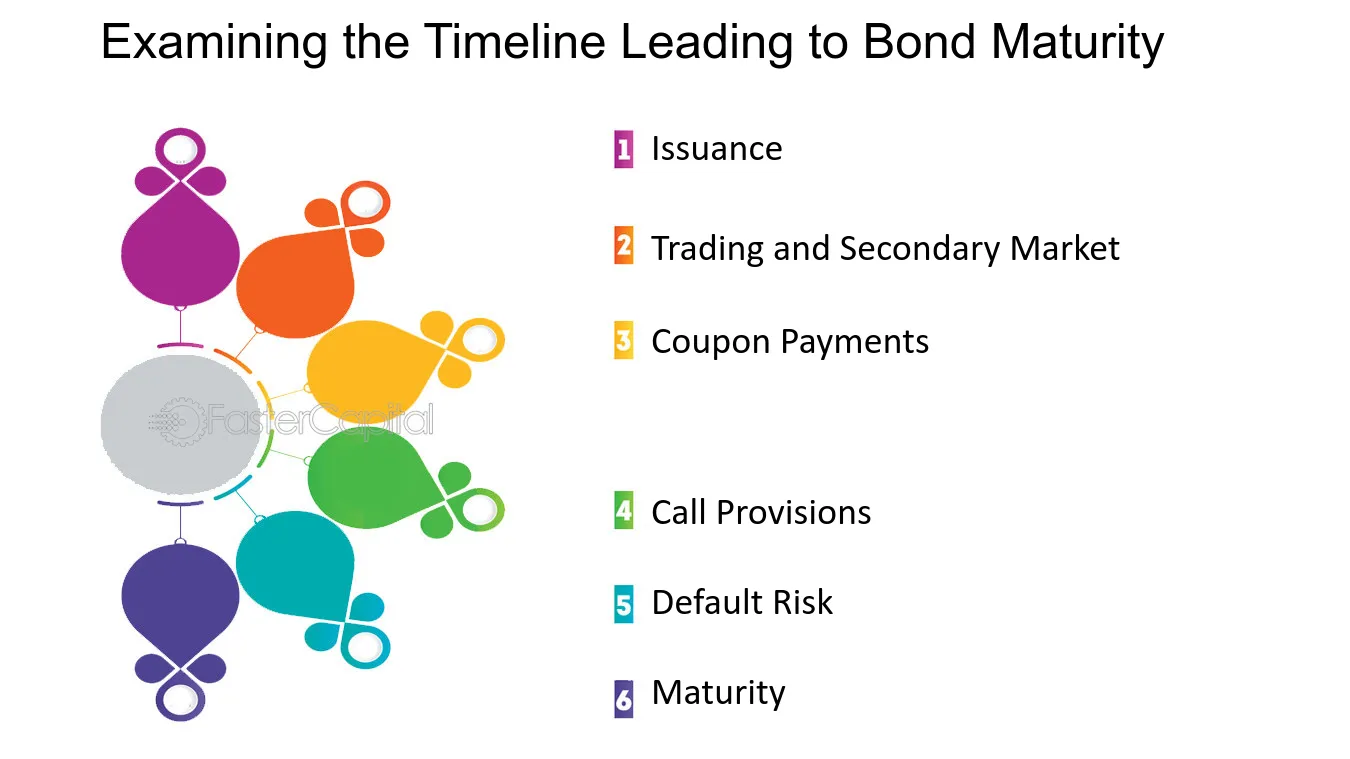
Examining the Timeline Leading to Bond Maturity - Countdown to Maturity: Trust Indenture s Impact on Bond Expiration
18. Understanding Bond Maturity
Bonds are a popular investment vehicle for investors, but understanding the different aspects of bonds can be confusing. One of the key components of a bond is its maturity. understanding bond maturity is crucial to making informed investment decisions.
1. What is bond maturity?
Bond maturity refers to the length of time until the bond reaches its full face value. When a bond is issued, it has a set maturity date. This date is the point at which the issuer of the bond will repay the bondholder the full face value of the bond.
2. How does bond maturity affect the bond’s price?
The longer the time until maturity, the more volatile the bond’s price will be. This is because the longer the bond’s maturity, the greater the risk of changes in interest rates affecting the bond’s price. As interest rates rise, the price of a bond with a longer maturity will decrease more than the price of a bond with a shorter maturity. This is because the bondholder will be locked into a lower interest rate for a longer period of time.
3. What are the different types of bond maturity?
Bonds can have different types of maturity dates, including short-term, medium-term, and long-term. short-term bonds have a maturity of one to three years, medium-term bonds have a maturity of four to ten years, and long-term bonds have a maturity of ten years or more.
4. What are the advantages and disadvantages of investing in bonds with different maturities?
Short-term bonds are less volatile than long-term bonds, making them a good option for investors who want stability and predictability. However, short-term bonds typically offer lower yields than long-term bonds. Long-term bonds offer higher yields, but they are more volatile and carry a greater risk of interest rate changes affecting the bond’s price.
5. What are some strategies for managing bond maturity risk?
One strategy for managing bond maturity risk is to create a bond ladder. This involves buying bonds with different maturities and staggering their maturity dates. This helps to spread out the risk of interest rate changes affecting the bond’s price. Another strategy is to invest in bond funds, which hold a diversified portfolio of bonds with different maturities.
6. What is the best option for investing in bonds?
The best option for investing in bonds depends on the investor’s individual goals and risk tolerance. For investors who want stability and predictability, short-term bonds may be the best option. For investors who want higher yields and are willing to take on more risk, long-term bonds may be a better option. Ultimately, it is important to do research and consult with a financial advisor to determine the best bond investment strategy for individual needs.
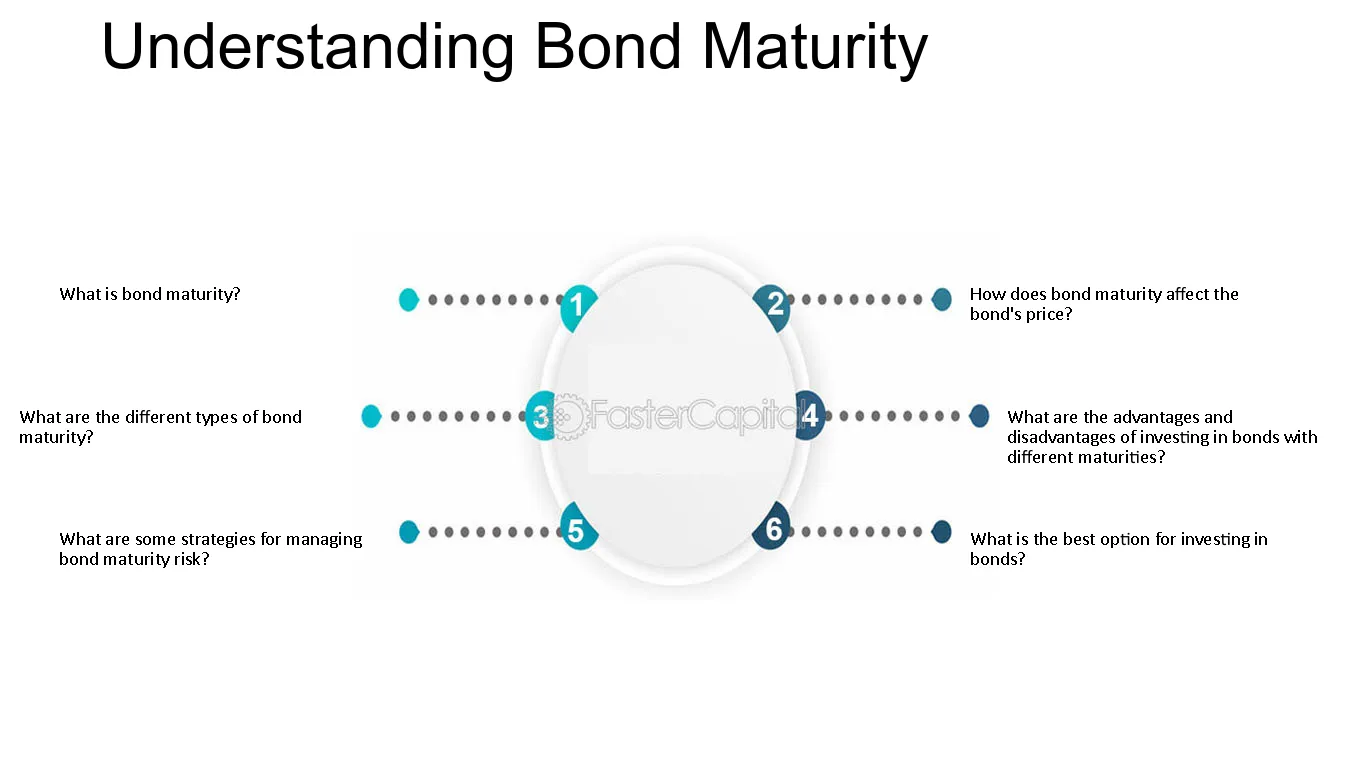
Understanding Bond Maturity - Ex Coupon Bonds: Understanding Maturity and Its Implications
19. Impact of Interest Rates on Ex Coupon Bond Maturity
Interest rates have a significant impact on ex coupon bond maturity. As interest rates rise, the value of a bond decreases, and its maturity date becomes longer. On the other hand, when interest rates fall, the bond's value rises, and its maturity date shortens. This inverse relationship between interest rates and bond maturity is crucial for investors to understand when considering ex coupon bonds.
1. understanding Interest rates:
Interest rates are the cost of borrowing money. When interest rates are high, it means that the cost of borrowing money is high, and when they are low, the cost of borrowing is low. The central bank of a country sets interest rates. It is responsible for managing the economy, and one of its tools is to adjust interest rates to control inflation and stimulate economic growth.
2. impact of Interest rates on Bond Prices:
Bond prices and interest rates have an inverse relationship. When interest rates rise, bond prices fall, and when interest rates fall, bond prices rise. This relationship is because investors will always seek the highest return on their investment. If interest rates rise, new bonds will offer a higher return, and older bonds with lower returns will decrease in value.
3. Impact of interest Rates on bond Maturity:
The maturity of a bond is the length of time until the bond reaches its final payment. When interest rates rise, the bond's maturity date becomes longer because the bond is less valuable. This means that the bond will take longer to reach its final payment. Conversely, when interest rates fall, the bond's maturity date shortens, and the bond will reach its final payment sooner.
4. Examples:
Suppose an investor purchases an ex coupon bond with a maturity date of ten years and an interest rate of 5%. If interest rates rise to 6%, the bond's value will decrease, and its maturity date will become longer. The investor will have to wait longer to receive their final payment. If interest rates fall to 4%, the bond's value will increase, and its maturity date will shorten, and the investor will receive their final payment sooner.
5. Best Option:
Investors should consider interest rates when purchasing ex coupon bonds. If interest rates are high, it may be better to wait for them to fall before investing in bonds. Conversely, if interest rates are low, it may be a good time to invest in bonds. It is also important to consider the bond's maturity date and whether it fits into the investor's long-term investment strategy.
Interest rates have a significant impact on ex coupon bond maturity. Investors should understand the inverse relationship between interest rates and bond prices and use this knowledge to make informed investment decisions. By considering interest rates and bond maturity, investors can choose the best investment strategy for their needs.
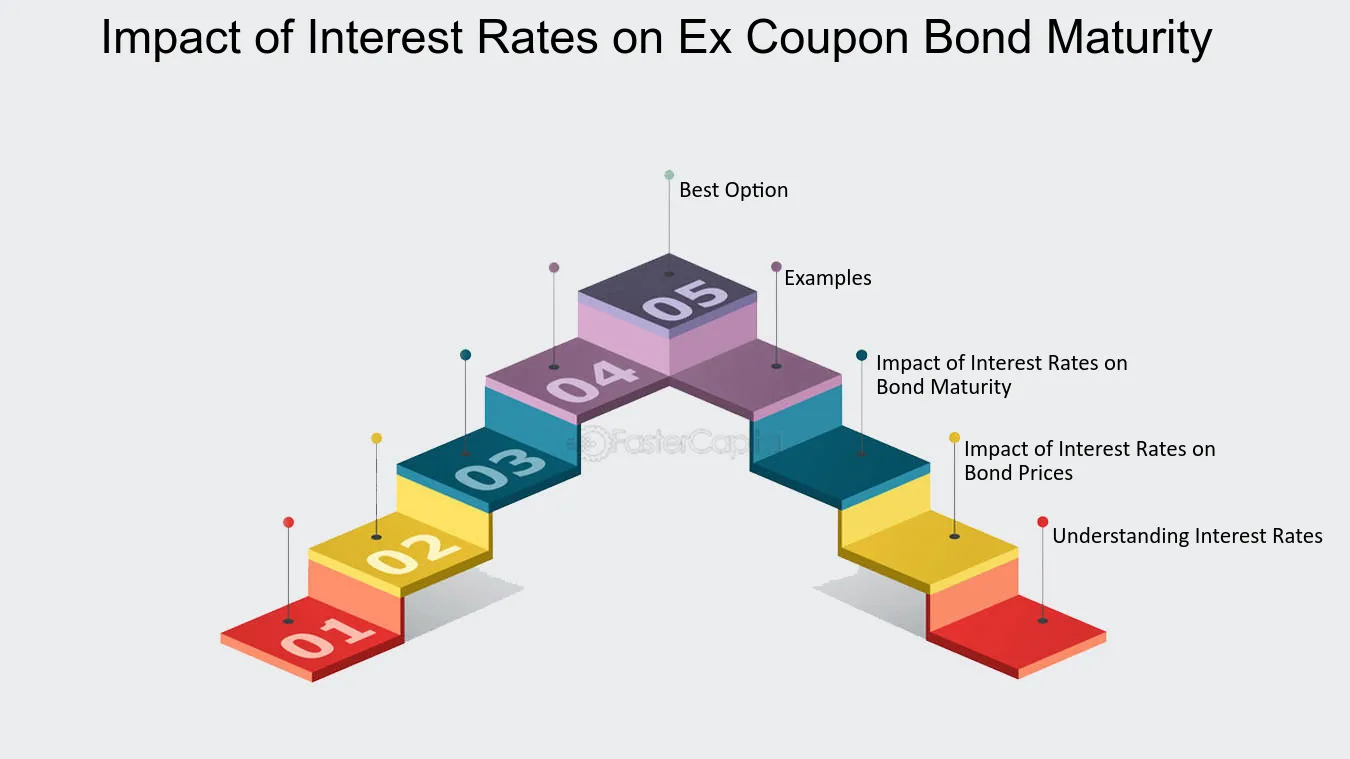
Impact of Interest Rates on Ex Coupon Bond Maturity - Ex Coupon Bonds: Understanding Maturity and Its Implications
20. Strategies for Managing Ex Coupon Bond Maturity
Ex coupon bonds have a unique characteristic that requires special attention when managing their maturity. Unlike regular bonds, the ex coupon bond's price does not include the interest payment that has already been paid to the previous holder. This means that the price of the bond drops once the interest payment has been made, and the bond becomes ex coupon. Managing the maturity of ex coupon bonds requires a strategic approach that takes into account the bond's unique characteristics and the investor's goals.
1. Hold until maturity
One option for managing ex coupon bond maturity is to hold the bond until maturity. This strategy is suitable for investors who do not need immediate cash flow and can wait until the bond reaches its maturity date. By holding the bond until maturity, investors can benefit from the full interest payment and the final principal payment. This strategy is less risky because it avoids the fluctuations in the bond's price and ensures that the investor receives the full value of the bond.
2. Sell before ex coupon date
Another option for managing ex coupon bond maturity is to sell the bond before the ex coupon date. This strategy is suitable for investors who want to realize their investment before the bond becomes ex coupon. By selling the bond before the ex coupon date, investors can avoid the drop in the bond's price and receive the full value of the bond. This strategy is more risky because it requires the investor to predict the market's behavior and the bond's price movements.
3. Buy after ex coupon date
A third option for managing ex coupon bond maturity is to buy the bond after the ex coupon date. This strategy is suitable for investors who are looking for a bargain and can wait until the bond's price drops after the ex coupon date. By buying the bond after the ex coupon date, investors can benefit from the lower price of the bond and the full interest payment. This strategy is more risky because it requires the investor to predict the market's behavior and the bond's price movements.
4. Reinvest the interest payment
Investors can also reinvest the interest payment received from the ex coupon bond. This strategy is suitable for investors who want to maximize their return on investment and can afford to reinvest the interest payment. By reinvesting the interest payment, investors can benefit from the compounding effect and increase their investment's value over time.
5. Diversify the portfolio
Investors can also manage the maturity of ex coupon bonds by diversifying their portfolio. This strategy is suitable for investors who want to reduce their risk exposure and increase their return on investment. By diversifying the portfolio, investors can spread their investment across different asset classes and reduce the impact of any single investment's performance on their overall portfolio.
Managing the maturity of ex coupon bonds requires a strategic approach that takes into account the bond's unique characteristics and the investor's goals. Investors can choose to hold the bond until maturity, sell before the ex coupon date, buy after the ex coupon date, reinvest the interest payment, or diversify their portfolio. Each strategy has its advantages and disadvantages, and investors should carefully consider their options before making a decision.
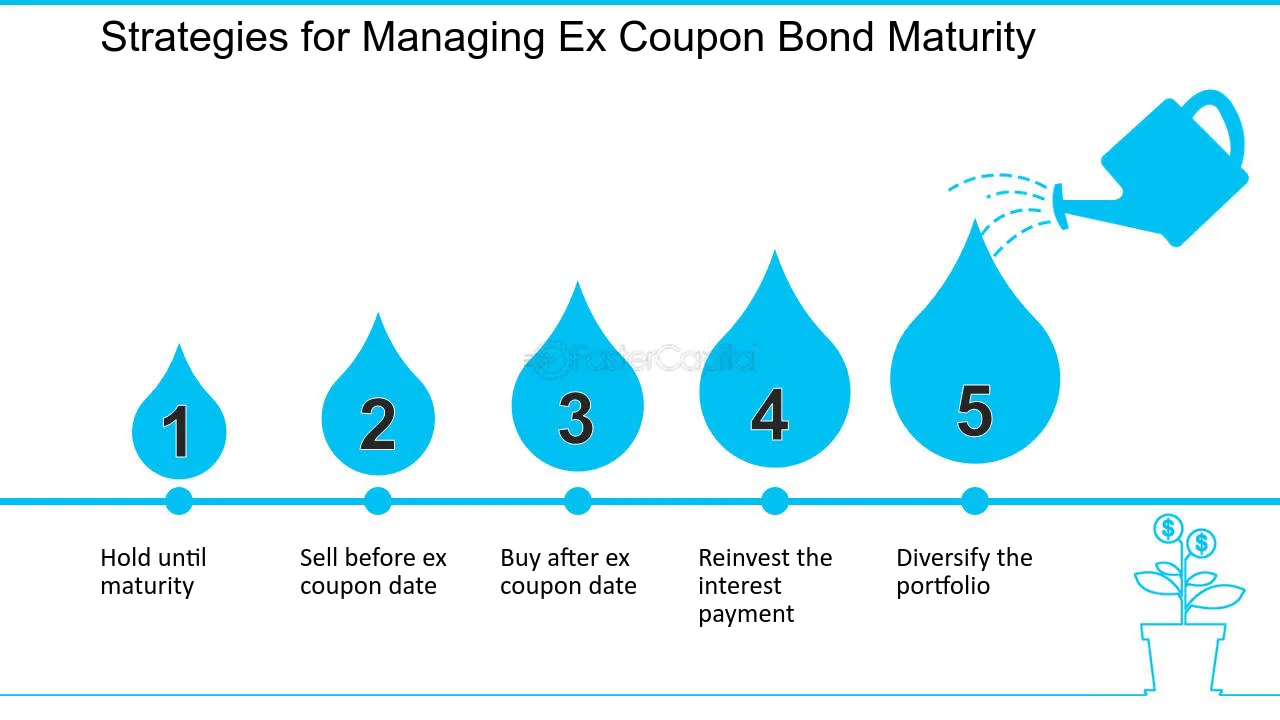
Strategies for Managing Ex Coupon Bond Maturity - Ex Coupon Bonds: Understanding Maturity and Its Implications
21. Risks Associated with Ex Coupon Bond Maturity
Ex coupon bonds are popular among investors who want to receive interest payments upfront. However, these bonds also come with risks, particularly when they reach maturity. The risks associated with ex coupon bond maturity are crucial to understand for investors who want to make informed decisions about their investments. In this section, we will discuss these risks in detail.
1. Interest Rate Risk: One of the primary risks associated with ex coupon bond maturity is interest rate risk. When interest rates rise, the value of bonds decreases, and investors may face a loss if they sell their bonds before maturity. This risk is particularly significant for ex coupon bonds because they do not pay interest throughout their term. Therefore, if interest rates rise before maturity, investors may not be able to sell their bonds at a profit.
2. Reinvestment Risk: Another risk associated with ex coupon bond maturity is reinvestment risk. This risk arises when investors reinvest their principal after the bond matures. Since ex coupon bonds do not pay interest throughout their term, investors may not have a steady stream of income to reinvest. Therefore, when the bond matures, investors may have to reinvest their entire principal in a new bond, which may have a lower interest rate.
3. Default Risk: Ex coupon bonds are issued by companies and governments, and there is always a risk that they may default on their obligations. If a company or government defaults on an ex coupon bond, investors may lose their entire investment. Therefore, investors must carefully evaluate the creditworthiness of the issuer before investing in ex coupon bonds.
4. Market Risk: Market risk is another risk associated with ex coupon bond maturity. This risk arises when there is a change in market conditions that affects the value of the bond. For example, if there is a sudden increase in supply or a decrease in demand for ex coupon bonds, the price of the bond may fall. Therefore, investors must stay updated on market conditions and be prepared to adjust their investment strategy accordingly.
5. Liquidity Risk: Ex coupon bonds may also face liquidity risk, which arises when investors are unable to sell their bonds quickly and at a fair price. This risk is particularly significant for ex coupon bonds because they do not pay interest throughout their term. Therefore, if investors need to sell their bonds before maturity, they may not be able to find a buyer or may have to sell at a lower price.
Ex coupon bond maturity comes with several risks that investors must be aware of. These risks include interest rate risk, reinvestment risk, default risk, market risk, and liquidity risk. Investors must carefully evaluate these risks before investing in ex coupon bonds and consider diversifying their portfolio to mitigate these risks.
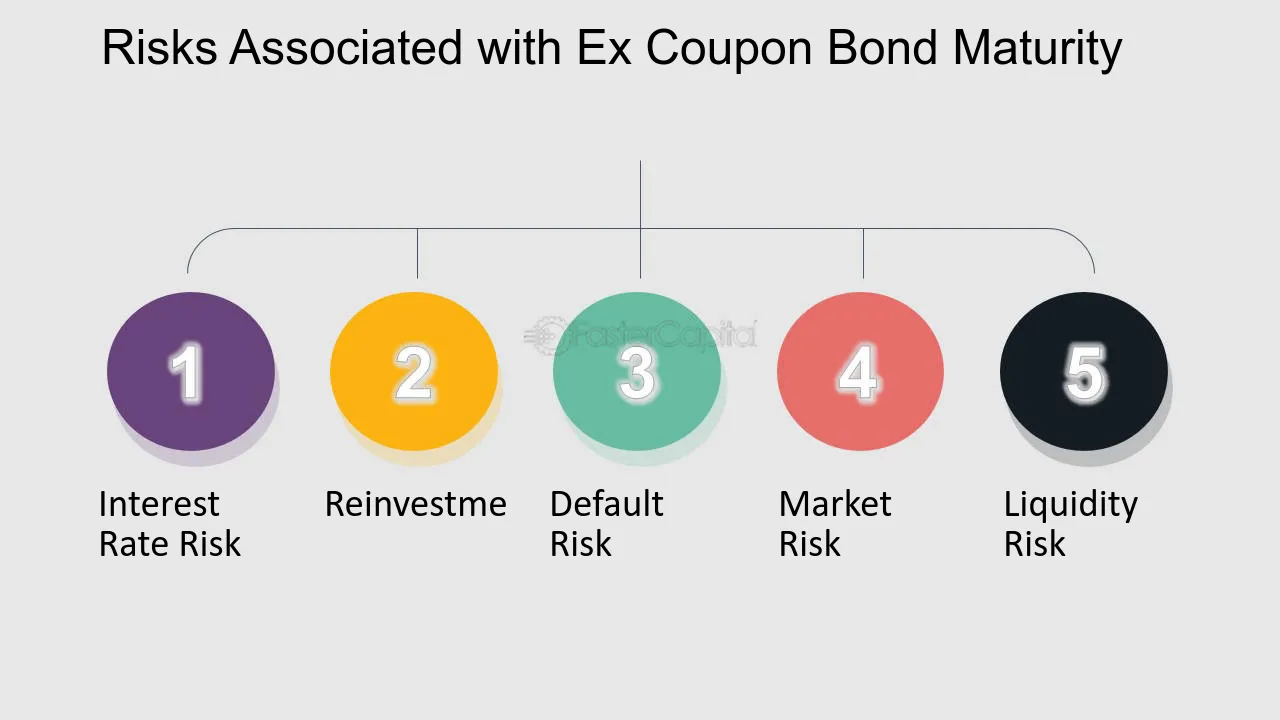
Risks Associated with Ex Coupon Bond Maturity - Ex Coupon Bonds: Understanding Maturity and Its Implications
22. Introduction to G7 Bond Maturity
1. Understanding G7 Bond Maturity
When it comes to investing in fixed-income securities, it is crucial for investors to have a comprehensive understanding of various factors that can impact their investment decisions. One such factor is bond maturity, which plays a significant role in determining the risk and return profile of a bond. In this section, we will delve into the concept of G7 bond maturity, exploring its significance for fixed-income investors.
2. Defining G7 Bond Maturity
G7 bond maturity refers to the length of time until a bond reaches its final payment date, at which point the principal amount is repaid to the bondholder. It represents the period over which an investor can expect to receive periodic interest payments and the return of their initial investment. Maturity is typically expressed in years and can range from short-term (less than 1 year) to long-term (over 10 years) in the case of G7 bonds.
3. Impact on Risk and Return
The maturity of a bond has a direct impact on its risk and return characteristics. Generally, longer maturity bonds tend to offer higher yields to compensate investors for the increased risk associated with a longer time horizon. This is because longer-term bonds are exposed to a greater degree of interest rate risk, as changes in interest rates can significantly affect their value. On the other hand, shorter-term bonds typically have lower yields but are considered less risky due to their shorter duration.
For example, consider two G7 bonds with similar credit quality and coupon rates, but different maturities. Bond A has a maturity of 5 years, while Bond B has a maturity of 20 years. Bond B, with its longer maturity, is likely to offer a higher yield to attract investors who are willing to take on the additional risk associated with a longer time horizon.
4. Evaluating Investor Objectives
Investors should carefully evaluate their investment objectives and risk tolerance when considering G7 bond maturity. Those with a shorter time horizon or a lower risk tolerance may prefer shorter-term bonds, as they offer more stability and liquidity. Shorter-term bonds also provide investors with the flexibility to reinvest their funds at higher interest rates if rates rise.
Conversely, investors with a longer time horizon or a higher risk tolerance may opt for longer-term bonds, which offer the potential for higher yields. These investors are typically focused on generating income over an extended period and are willing to accept the inherent interest rate risk associated with longer maturities.
5. Case Study: Impact of Maturity on Bond Performance
To illustrate the impact of maturity on bond performance, let's consider a hypothetical case study. Suppose an investor purchases two G7 bonds with identical coupon rates but different maturities. Bond X has a maturity of 2 years, while Bond Y has a maturity of 10 years.
If interest rates remain unchanged, both bonds will provide the investor with the same yield. However, if interest rates increase, Bond Y will experience a greater decline in value compared to Bond X due to its longer duration. On the other hand, if interest rates decrease, Bond Y will appreciate more than Bond X.
This case study highlights the importance of considering bond maturity in relation to interest rate expectations and the investor's risk profile.
6. Tips for Evaluating G7 Bond Maturity
- Conduct thorough research on the current interest rate environment and future rate projections to gauge the potential impact on bond prices.
- Assess your investment objectives and risk tolerance to determine the appropriate maturity profile for your fixed-income portfolio.
- Diversify your bond holdings across various maturities to balance risk and potential returns.
- Regularly review and reassess your bond investments to ensure they align with your evolving investment goals and market conditions.
Understanding G7 bond maturity is crucial for fixed-income investors as it directly influences the risk and return characteristics of their investments. By considering the impact of maturity on bond performance and evaluating their investment objectives and risk tolerance, investors can make informed decisions when constructing their fixed-income portfolios.
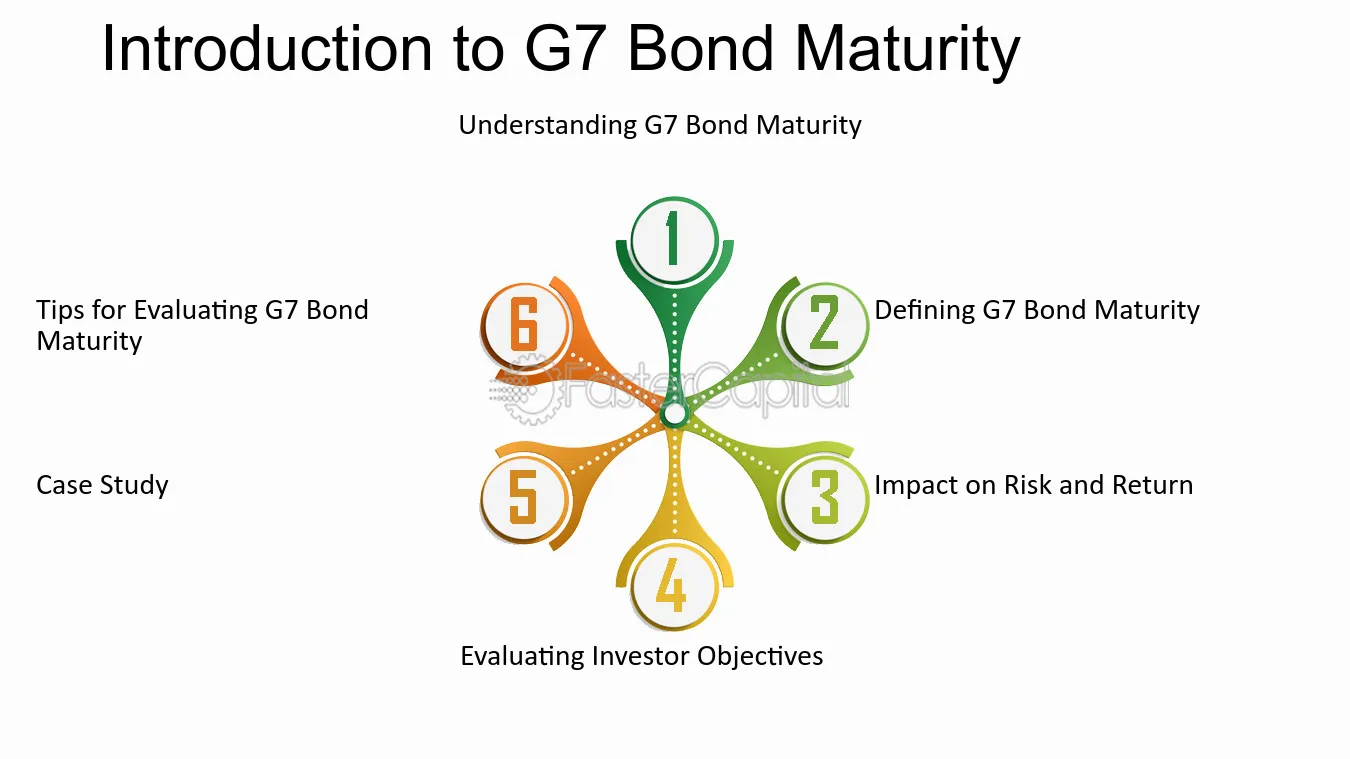
Introduction to G7 Bond Maturity - G7 Bond Maturity: Evaluating the Significance for Fixed Income Investors
23. Understanding Bond Maturity and Its Importance
1. Bond maturity is a crucial concept that fixed-income investors must understand in order to make informed investment decisions. It refers to the length of time until a bond's principal amount is repaid to the investor. Bond maturity plays a significant role in determining the risk and potential return associated with a bond investment. In this section, we will delve deeper into the importance of bond maturity and explore its implications for fixed-income investors.
2. Understanding bond maturity is essential because it directly affects the timing of cash flows received from a bond investment. Bonds can have various maturity periods, ranging from short-term (less than one year) to long-term (up to 30 years or more). The maturity period influences the stability and predictability of cash flows, which is a crucial consideration for investors with specific financial goals or income needs.
3. One important aspect to consider when evaluating bond maturity is the relationship between maturity and interest rates. Generally, longer-term bonds tend to offer higher interest rates compared to shorter-term bonds. This is because longer-term bonds expose investors to greater interest rate risk, as market conditions and inflation can significantly impact bond prices and yields over an extended period. Investors seeking higher yields may be willing to accept this increased risk by investing in longer-term bonds.
4. On the other hand, shorter-term bonds typically have lower interest rates but offer more stability in terms of their price and yield. These bonds are less affected by interest rate fluctuations and are considered less risky. Shorter-term bonds are often favored by conservative investors or those with shorter investment horizons who prioritize capital preservation over higher returns.
5. Let's consider an example to illustrate the importance of bond maturity. Suppose an investor has a specific financial goal of purchasing a house in five years. In this case, investing in a five-year bond would align with their investment horizon and cash flow needs. By selecting a bond with a maturity that matches their goal, the investor can reasonably expect to receive the principal amount at the desired time, facilitating the house purchase.
6. It's worth noting that bond maturity also affects a bond's liquidity. Generally, shorter-term bonds are more liquid than longer-term bonds. Liquidity refers to the ease with which a bond can be bought or sold in the market without significantly impacting its price. Investors who prioritize liquidity may prefer shorter-term bonds as they offer more flexibility to sell the investment before maturity if needed.
7. Lastly, investors should be aware of the concept of average bond maturity in bond funds or ETFs. Bond funds typically hold a portfolio of bonds with varying maturities. The average bond maturity of a fund provides an indication of the overall interest rate risk and potential volatility of the fund. Investors with a low-risk tolerance may opt for bond funds with shorter average maturities to mitigate interest rate risk.
Understanding bond maturity is essential for fixed-income investors to align their investment goals, risk tolerance, and cash flow needs. The maturity of a bond affects the timing and stability of cash flows, the relationship with interest rates, and the liquidity of the investment. By carefully considering bond maturity, investors can make informed investment decisions that align with their financial objectives.
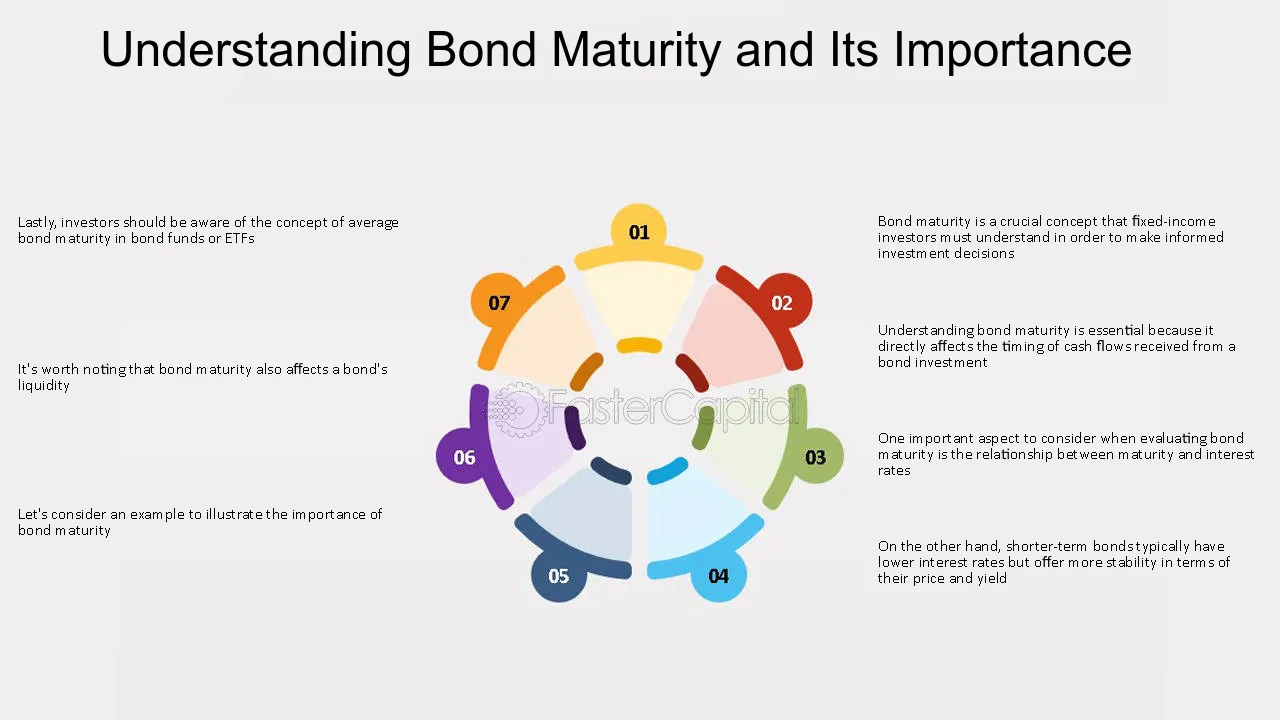
Understanding Bond Maturity and Its Importance - G7 Bond Maturity: Evaluating the Significance for Fixed Income Investors
24. Evaluating the Impact of G7 Bond Maturity on Fixed-Income Investors
1. evaluating the Impact of G7 bond Maturity on Fixed-Income Investors
When it comes to investing in fixed-income securities, one key factor that investors need to consider is the maturity of the bonds they are investing in. The maturity of a bond refers to the length of time until the bond's principal is repaid in full. In the case of G7 bonds, which are issued by the governments of the seven largest advanced economies in the world, evaluating the impact of bond maturity becomes even more crucial for fixed-income investors.
2. Understanding the Relationship between Bond Maturity and Interest Rates
One of the primary ways in which bond maturity impacts fixed-income investors is through its relationship with interest rates. Generally, longer-maturity bonds tend to be more sensitive to changes in interest rates compared to shorter-maturity bonds. This is because the longer the bond's maturity, the more time there is for interest rates to fluctuate. As a result, when interest rates rise, the value of longer-maturity bonds tends to decline more significantly than shorter-maturity bonds. Conversely, when interest rates fall, longer-maturity bonds tend to experience greater price appreciation.
For example, let's consider a fixed-income investor who holds a 10-year G7 bond with a fixed interest rate of 3%. If interest rates rise by 1%, the value of the bond is likely to decline as new bonds with higher yields become available in the market. On the other hand, if interest rates decrease by 1%, the value of the bond is likely to increase as the fixed interest rate becomes more attractive relative to the prevailing rates.
3. balancing Risk and Return with bond Maturity
When evaluating the impact of G7 bond maturity on fixed-income investors, it's important to strike a balance between risk and return. Generally, longer-maturity bonds offer higher yields to compensate investors for the additional risk they assume due to interest rate fluctuations. However, this also means that longer-maturity bonds carry a higher degree of interest rate risk compared to shorter-maturity bonds.
Fixed-income investors with a lower risk tolerance may opt for shorter-maturity G7 bonds, as they offer more stability and protection against interest rate volatility. On the other hand, investors seeking higher yields and are willing to tolerate greater fluctuations in bond prices may choose longer-maturity bonds.
4. Case Study: Evaluating the Impact of G7 Bond Maturity
To illustrate the significance of bond maturity for fixed-income investors, let's consider a case study. Imagine an investor who purchased a 30-year G7 bond with a 4% fixed interest rate. Over the course of 10 years, interest rates in the market have declined significantly, resulting in new bonds with lower yields. As a result, the value of the investor's bond has increased due to its attractive fixed interest rate compared to prevailing rates.
In this case, the longer bond maturity allowed the investor to benefit from the declining interest rate environment, resulting in capital appreciation. However, it's important to note that had interest rates risen, the investor would have experienced a decline in the bond's value.
5. Tips for Evaluating G7 Bond Maturity
When evaluating the impact of G7 bond maturity on fixed-income investors, here are some tips to consider:
- Understand your risk tolerance: Assess your risk tolerance and investment objectives to determine whether shorter-maturity or longer-maturity bonds align better with your financial goals.
- Monitor interest rate trends: Stay informed about changes in interest rates and their potential impact on the value of your bonds. This will help you make informed decisions about bond maturities.
- diversify your bond portfolio: Consider diversifying your bond portfolio by investing in a mix of shorter and longer-maturity G7 bonds. This can help mitigate the impact of interest rate fluctuations on your overall fixed-income investments.
Evaluating the impact of G7 bond maturity is crucial for fixed-income investors. Understanding the relationship between bond maturity and interest rates, balancing risk and return, and considering real-life case studies can help investors make informed decisions about their fixed-income portfolios. By following these tips, investors can navigate the bond market with greater confidence and potentially enhance their investment returns.
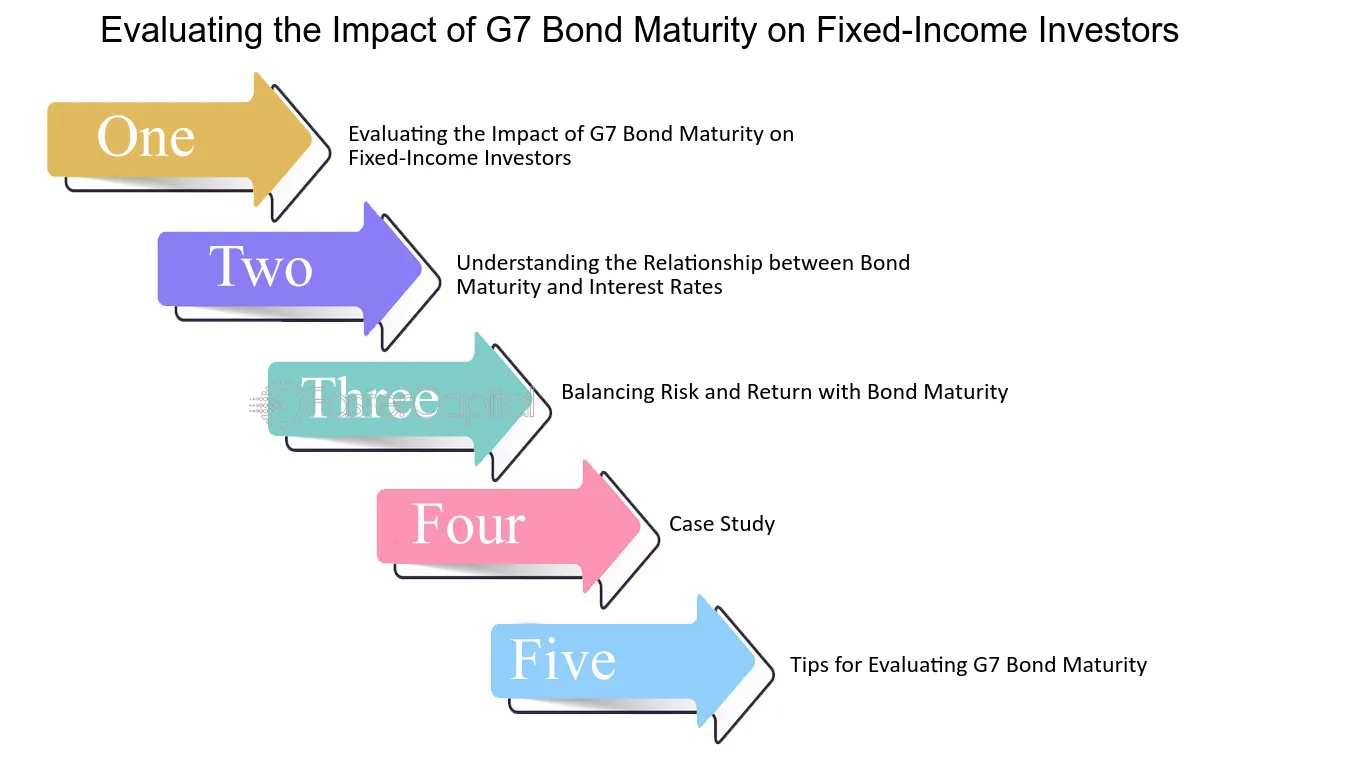
Evaluating the Impact of G7 Bond Maturity on Fixed Income Investors - G7 Bond Maturity: Evaluating the Significance for Fixed Income Investors
25. Factors Affecting G7 Bond Maturity and Their Implications
1. Bond maturity is a crucial factor for fixed-income investors, as it determines the length of time until they receive their principal back. In the case of G7 bonds, which are issued by the seven largest advanced economies in the world, the maturity of these bonds is influenced by several key factors. Understanding these factors and their implications is essential for investors looking to make informed decisions in the fixed-income market.
2. economic conditions: The overall economic conditions of a country play a significant role in determining the maturity of G7 bonds. In times of economic stability and growth, governments may issue bonds with longer maturities to take advantage of lower interest rates and lock in funding for an extended period. Conversely, during economic downturns or periods of uncertainty, governments may opt for shorter-term bonds to minimize the potential risks associated with long-term borrowing.
3. Monetary Policy: Central banks' monetary policies can also impact G7 bond maturity. When central banks implement expansionary monetary policies, such as lowering interest rates or engaging in quantitative easing, longer-term bonds become more attractive for investors seeking higher yields. In contrast, when central banks adopt contractionary policies, shorter-term bonds may be preferred as they offer more flexibility in adjusting to changing interest rate environments.
4. Investor Demand: The level of demand from investors for G7 bonds at different maturities can influence the issuance of bonds with specific maturity lengths. For instance, if there is strong investor demand for longer-term bonds due to a desire for stable income streams, governments may be more inclined to issue bonds with longer maturities. Conversely, if there is a preference for shorter-term bonds due to market volatility or uncertainty, governments may adjust their issuance accordingly.
5. Fiscal Policy and Debt Management: government fiscal policies and debt management strategies also impact G7 bond maturity. Governments with higher levels of debt may choose to issue longer-term bonds to spread out their debt repayments and reduce refinancing risks. On the other hand, governments with lower debt levels may issue shorter-term bonds to take advantage of favorable interest rate conditions or to maintain flexibility in managing their debt portfolio.
6. Case Study: To illustrate the significance of these factors, let's consider the case of Japan. Due to its high debt-to-GDP ratio and efforts to manage its debt burden, the Japanese government has been issuing long-term bonds with maturities exceeding 10 years. This strategy allows them to lock in low interest rates and ensure stable funding for an extended period. However, it also exposes the government to interest rate risk and potential refinancing challenges in the future.
7. Tips for Investors: When evaluating G7 bond maturity, investors should consider their investment objectives, risk tolerance, and market conditions. Diversifying across different bond maturities can help mitigate risk and optimize returns. Additionally, staying informed about economic indicators, central bank policies, and government debt management strategies can provide valuable insights into potential shifts in bond maturity patterns.
Understanding the factors influencing G7 bond maturity is crucial for fixed-income investors. Economic conditions, monetary policy, investor demand, fiscal policy, and debt management all play a role in determining the maturity of G7 bonds. By considering these factors and staying informed, investors can make more informed decisions and effectively navigate the fixed-income market.
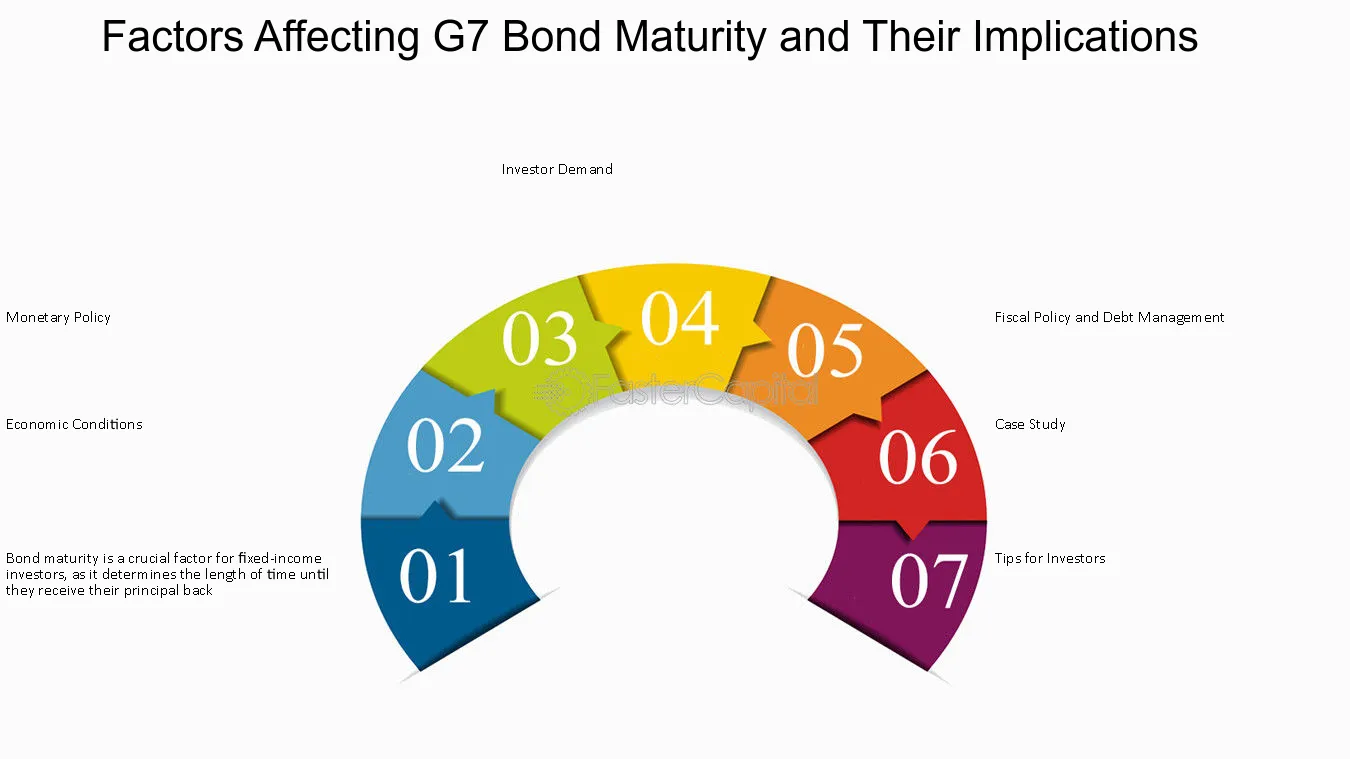
Factors Affecting G7 Bond Maturity and Their Implications - G7 Bond Maturity: Evaluating the Significance for Fixed Income Investors
26. Strategies for Managing G7 Bond Maturity Risk in Fixed-Income Portfolios
1. Diversification: One of the key strategies for managing G7 bond maturity risk in fixed-income portfolios is diversification. By spreading investments across different maturities, investors can mitigate the impact of interest rate fluctuations on their portfolios. For example, an investor may allocate a certain percentage of their portfolio to short-term bonds, which have lower maturity risk, while also investing in longer-term bonds to potentially benefit from higher yields. This approach helps to balance the risk and return profile of the portfolio.
2. Yield Curve Positioning: Another strategy is to carefully position the portfolio along the yield curve. The yield curve represents the relationship between bond yields and their respective maturities. By analyzing the yield curve, investors can identify opportunities to optimize their portfolio's risk and return characteristics. For instance, if the yield curve is steep, indicating higher yields for longer maturities, investors may consider extending the duration of their bond holdings to capture higher returns. Conversely, if the yield curve is flat, investors may opt for shorter maturities to reduce exposure to potential interest rate fluctuations.
3. active management: Active management plays a crucial role in managing G7 bond maturity risk. Active managers continuously monitor market conditions and adjust portfolio allocations accordingly. They have the flexibility to make tactical changes, such as adjusting bond maturities, based on their outlook for interest rates and market trends. By actively managing bond maturities, investors can potentially enhance their risk-adjusted returns. For example, an active manager might reduce exposure to longer-term bonds if they anticipate rising interest rates, thereby reducing the portfolio's sensitivity to changes in rates.
4. Case Study: Let's consider a hypothetical case study to illustrate the importance of managing G7 bond maturity risk. Investor A has a fixed-income portfolio primarily invested in long-term bonds. However, due to an unexpected increase in interest rates, the value of the long-term bonds declines significantly. As a result, Investor A suffers a substantial loss. On the other hand, Investor B has a well-diversified portfolio with a mix of short-term and long-term bonds. When interest rates rise, the short-term bonds in Investor B's portfolio provide a cushion against the decline in value of the long-term bonds. As a result, Investor B's overall portfolio experiences a smaller loss compared to Investor A.
5. Tips for Managing G7 Bond Maturity Risk:
- Stay informed about macroeconomic factors and central bank policies that can influence interest rates.
- Regularly review and rebalance your portfolio to ensure it aligns with your risk tolerance and investment goals.
- Consider the use of bond laddering, which involves investing in bonds with staggered maturities to spread out reinvestment risk.
- Seek professional advice from financial advisors or portfolio managers with expertise in fixed-income investing.
- Continuously monitor and adjust your portfolio's maturity profile based on changing market conditions.
Managing G7 bond maturity risk in fixed-income portfolios requires a thoughtful approach that involves diversification, yield curve positioning, active management, and staying informed about market dynamics. By implementing these strategies and following best practices, investors can potentially enhance their risk-adjusted returns and mitigate the impact of interest rate fluctuations on their portfolios.
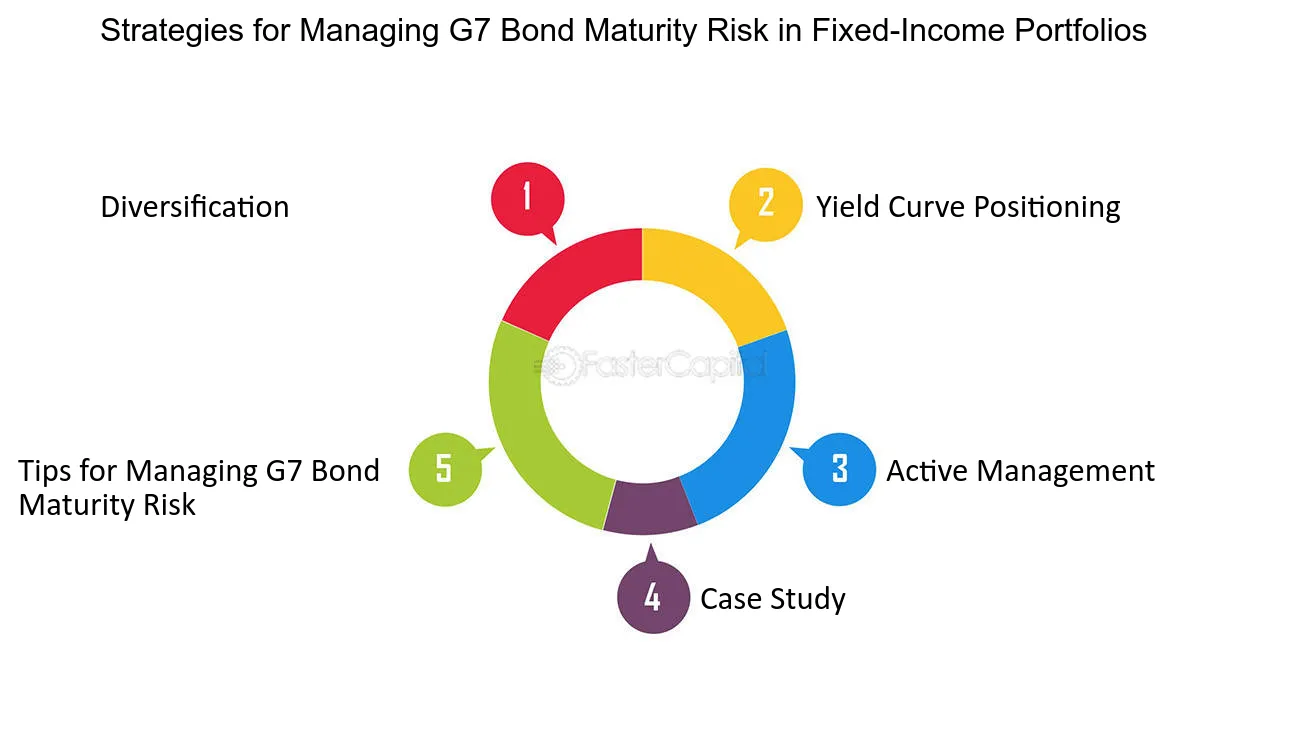
Strategies for Managing G7 Bond Maturity Risk in Fixed Income Portfolios - G7 Bond Maturity: Evaluating the Significance for Fixed Income Investors
27. Understanding the Significance of Bond Maturity Dates
Understanding the Significance of Bond Maturity Dates
When investing in bonds, one of the crucial factors to consider is the bond maturity date. The maturity date refers to the date on which the principal amount of the bond is due to be repaid to the bondholder. This date holds significant importance for investors as it directly impacts their investment strategy, risk tolerance, and potential returns. In this section, we will delve into the significance of bond maturity dates, exploring insights from various perspectives and providing a comprehensive understanding of this essential aspect of bond investing.
1. Risk vs. Return:
One of the primary considerations when analyzing bond maturity dates is the trade-off between risk and return. Generally, longer maturity bonds tend to offer higher yields to compensate investors for the increased risk associated with a longer investment horizon. This is because longer-term bonds are exposed to a higher degree of interest rate risk, as changes in interest rates can significantly impact the value of the bond over time. On the other hand, shorter-term bonds typically offer lower yields but are considered less risky due to their shorter duration. As an investor, it is crucial to assess your risk tolerance and investment goals to determine which option aligns with your financial objectives.
2. Income Stream:
Another aspect to consider is the income stream provided by bonds with varying maturity dates. Shorter-term bonds generally provide more frequent interest payments, which can be beneficial for investors seeking a steady income stream. Conversely, longer-term bonds often have less frequent interest payments, making them more suitable for those with a longer investment horizon and a focus on capital appreciation rather than immediate income needs. By assessing your current financial situation and cash flow requirements, you can decide which bond maturity dates align with your income needs.
3. Reinvestment Risk:
Reinvestment risk refers to the concern that when a bond matures, the investor may not be able to reinvest the proceeds at the same interest rate. This risk is more prominent in a declining interest rate environment. For instance, if an investor holds a long-term bond with a high coupon rate and interest rates subsequently decrease, the investor may face challenges in finding a similarly attractive investment opportunity. On the other hand, if an investor holds a short-term bond and interest rates rise, they can reinvest the proceeds at a higher interest rate, potentially increasing their overall return. It is vital to assess the prevailing interest rate environment and your expectations regarding future interest rate movements when selecting bond maturity dates to mitigate reinvestment risk.
4. Diversification:
Diversification is a cornerstone of successful investment strategies, and bond maturity dates offer an avenue for achieving diversification within a bond portfolio. By investing in bonds with different maturity dates, investors can spread their risk across various time horizons. This diversification strategy can help mitigate the impact of interest rate fluctuations and provide a more stable overall portfolio performance. For example, including a mix of short, intermediate, and long-term bonds can balance the income needs, risk tolerance, and potential returns within a portfolio. Evaluating your investment objectives and risk tolerance can help determine the optimal mix of bond maturity dates for a well-diversified portfolio.
Understanding the significance of bond maturity dates is crucial for investors seeking to adjust their investment strategy. By considering the risk-return trade-off, income stream, reinvestment risk, and diversification opportunities, investors can make informed decisions when selecting bond maturity dates. Ultimately, the best option depends on an individual's financial goals, risk tolerance, and market expectations.
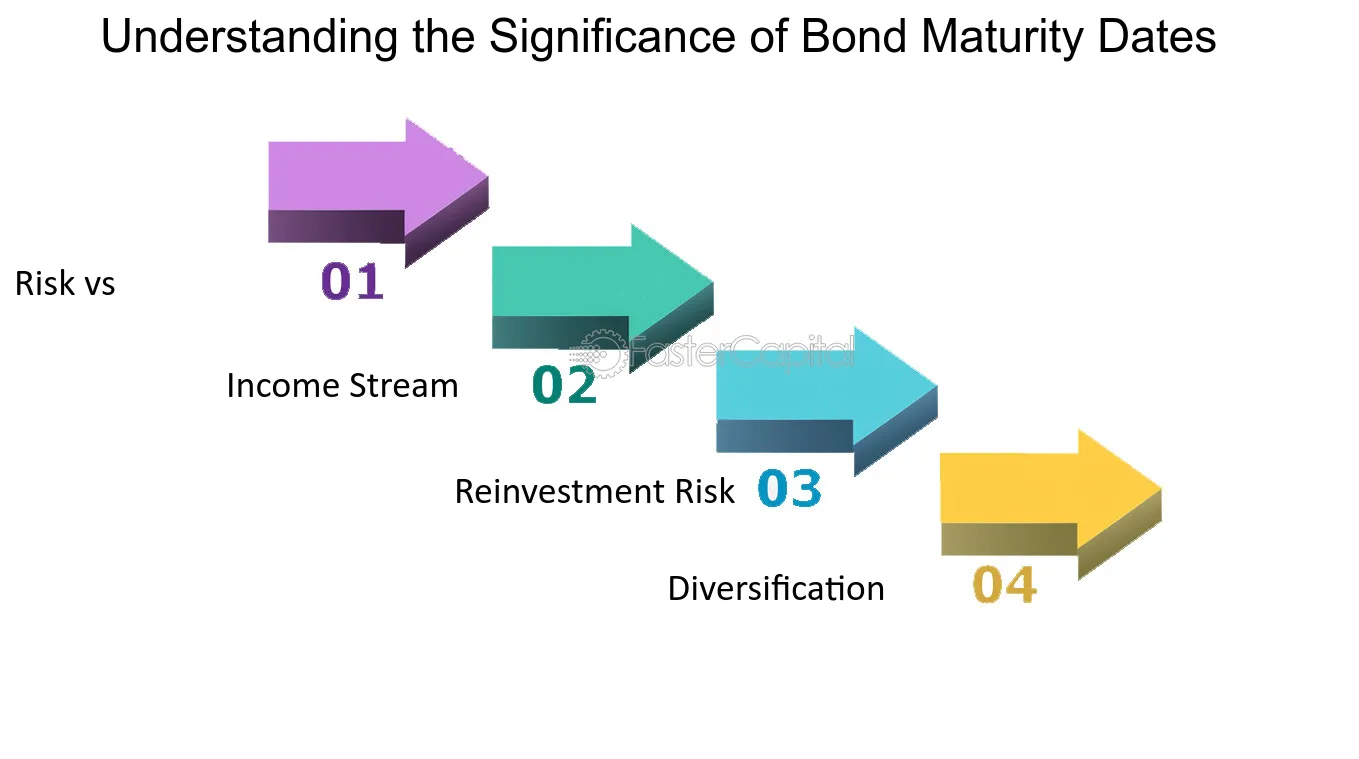
Understanding the Significance of Bond Maturity Dates - Maturity date: Adjusting Your Investment Strategy with Bond Maturity Dates
28. The Impact of Bond Maturity Dates on Investment Risk
The Impact of Bond maturity Dates on investment Risk
When it comes to investing in bonds, one important factor to consider is the maturity date. The maturity date refers to the date on which the bond issuer will repay the principal amount to the bondholder. This date plays a significant role in determining the investment risk associated with a bond. In this section, we will explore the impact of bond maturity dates on investment risk, considering insights from different points of view.
1. Interest Rate Risk: Bond prices are inversely related to interest rates. When interest rates rise, bond prices fall, and vice versa. The longer the maturity date of a bond, the more sensitive it is to changes in interest rates. This is because the longer the time until maturity, the more opportunities there are for interest rates to change. Therefore, bonds with longer maturity dates generally have higher interest rate risk compared to bonds with shorter maturity dates.
2. Reinvestment Risk: Reinvestment risk refers to the risk of not being able to reinvest the proceeds from a bond at the same interest rate when it matures. Bonds with longer maturity dates have a higher reinvestment risk because the investor is locked into a fixed interest rate for a longer period. If interest rates decline when the bond matures, the investor may have to reinvest the proceeds at a lower rate. On the other hand, bonds with shorter maturity dates offer the opportunity to reinvest the proceeds at higher rates if interest rates rise.
3. Liquidity Risk: Liquidity risk refers to the risk of not being able to sell a bond quickly and at a fair price. Bonds with longer maturity dates tend to have lower liquidity compared to bonds with shorter maturity dates. This is because there is generally less demand for longer-term bonds, and investors may find it challenging to find buyers for their bonds if they need to sell them before maturity. Shorter-term bonds, on the other hand, are more liquid as they have a shorter time until maturity and are in higher demand.
4. risk Tolerance and Investment horizon: An investor's risk tolerance and investment horizon play a crucial role in determining the impact of bond maturity dates on investment risk. If an investor has a low risk tolerance and a short investment horizon, they may prefer bonds with shorter maturity dates to minimize the risk of interest rate fluctuations and ensure liquidity. Conversely, investors with a higher risk tolerance and a longer investment horizon may be willing to accept the higher interest rate risk associated with longer-term bonds in exchange for potentially higher returns.
Comparing the options, it is evident that the best option depends on the investor's risk profile and investment goals. For conservative investors seeking stability and liquidity, bonds with shorter maturity dates may be the best choice. These bonds offer lower interest rate risk and higher liquidity, allowing investors to easily access their funds when needed. On the other hand, investors with a higher risk tolerance and a longer investment horizon may opt for longer-term bonds to potentially benefit from higher returns. However, they must be prepared to withstand the fluctuations in interest rates and potential reinvestment risks.
Bond maturity dates have a significant impact on investment risk. Longer maturity dates generally increase interest rate risk and reinvestment risk while decreasing liquidity. On the other hand, shorter maturity dates offer lower interest rate risk and higher liquidity. It is essential for investors to carefully consider their risk tolerance and investment goals when choosing bonds with specific maturity dates to align their investment strategy with their financial objectives.
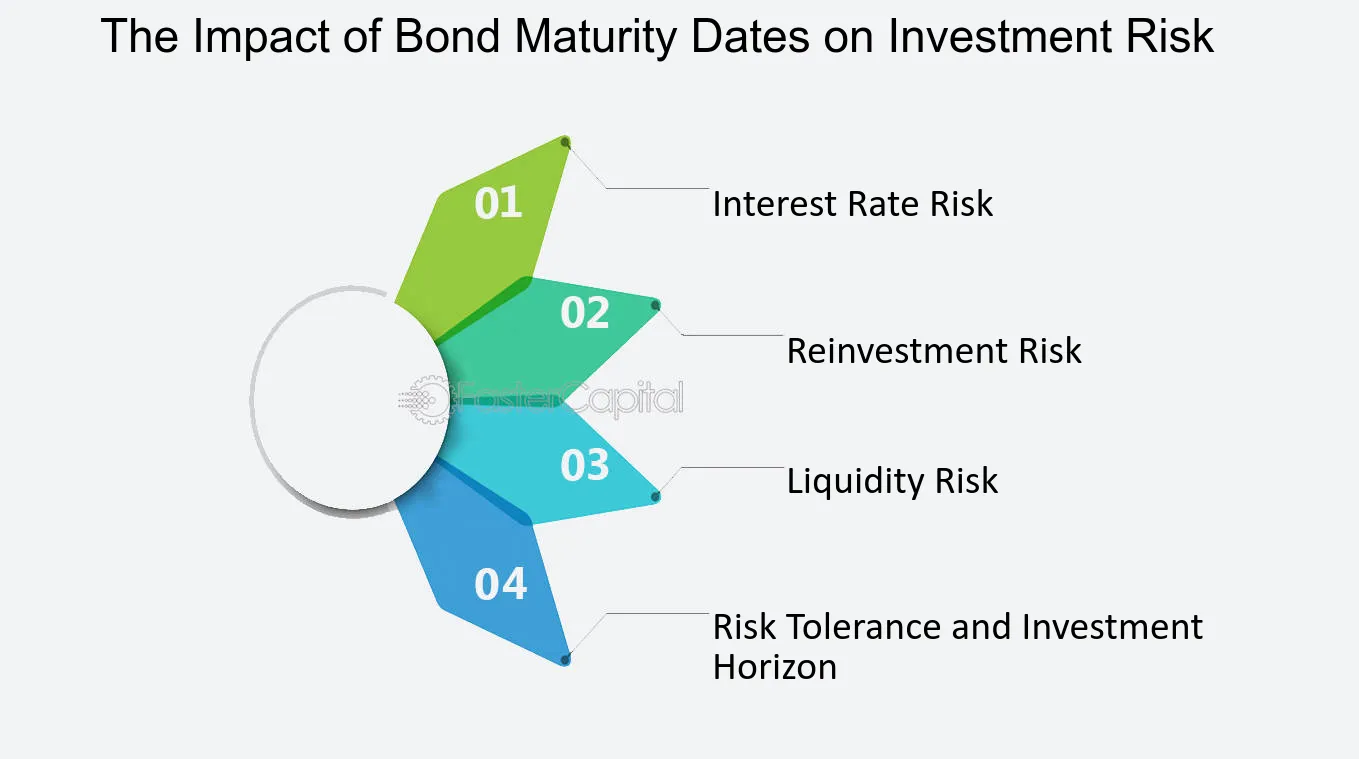
The Impact of Bond Maturity Dates on Investment Risk - Maturity date: Adjusting Your Investment Strategy with Bond Maturity Dates
29. Adjusting Your Investment Strategy Based on Bond Maturity Dates
Adjusting Your Investment Strategy Based on Bond Maturity Dates
When it comes to investing in bonds, one crucial aspect to consider is the bond maturity date. The maturity date refers to the date on which the issuer of the bond is obligated to repay the principal amount to the bondholder. As an investor, understanding the implications of bond maturity dates can help you adjust your investment strategy to maximize your returns and minimize risk.
1. Understanding the concept of bond maturity dates:
Bond maturity dates indicate the length of time until the bond reaches its full repayment. Short-term bonds typically have maturity dates within one to three years, while medium-term bonds range from three to ten years. Long-term bonds have maturity dates beyond ten years. The type of bond you choose will depend on your investment goals, risk tolerance, and market conditions.
2. The impact of bond maturity on investment returns:
Bond maturity dates play a significant role in determining the potential returns on your investment. Generally, longer-term bonds offer higher interest rates to compensate for the increased risk of inflation and interest rate fluctuations over an extended period. On the other hand, short-term bonds usually offer lower interest rates but provide more stability and liquidity. It is crucial to assess your risk appetite and investment horizon before deciding on the maturity date of your bond investment.
3. Strategies for adjusting your investment portfolio based on bond maturity dates:
A) Laddering: Laddering involves diversifying your bond portfolio by investing in bonds with different maturity dates. This strategy helps mitigate the impact of interest rate fluctuations and allows you to take advantage of higher interest rates when they occur. For instance, if you have a $10,000 investment, you could allocate $2,000 each to five bonds with maturities of one, three, five, seven, and ten years. As each bond matures, you can reinvest the proceeds into new bonds with longer maturities.
B) Barbell strategy: The barbell strategy involves investing in both short-term and long-term bonds while avoiding medium-term bonds. This approach allows you to benefit from the stability and liquidity of short-term bonds while taking advantage of the higher interest rates offered by long-term bonds. For example, you could allocate 30% of your bond portfolio to short-term bonds and 70% to long-term bonds. This strategy balances risk and return, offering a more diverse investment approach.
C) Bullet strategy: The bullet strategy focuses on investing in bonds with a specific maturity date that aligns with your investment goals. By selecting bonds with the desired maturity, you can tailor your investment to meet specific cash flow requirements. For instance, if you plan to use the bond proceeds to fund a future expense, such as college tuition, you can invest in a bond that matures around the same time you will need the funds.
4. Considering market conditions and interest rate expectations:
It is crucial to assess market conditions and interest rate expectations when adjusting your investment strategy based on bond maturity dates. If interest rates are expected to rise, investing in shorter-term bonds may be prudent to avoid being locked into lower rates for an extended period. Conversely, if interest rates are expected to decline, longer-term bonds may offer higher yields. Staying informed about economic indicators and consulting with financial advisors can help you make more informed decisions.
Adjusting your investment strategy based on bond maturity dates is a vital consideration for bond investors. By understanding the concept of bond maturity dates and evaluating different strategies, such as laddering, the barbell strategy, and the bullet strategy, you can tailor your investments to align with your goals and risk tolerance. Additionally, staying abreast of market conditions and interest rate expectations will enhance your ability to make informed investment decisions.
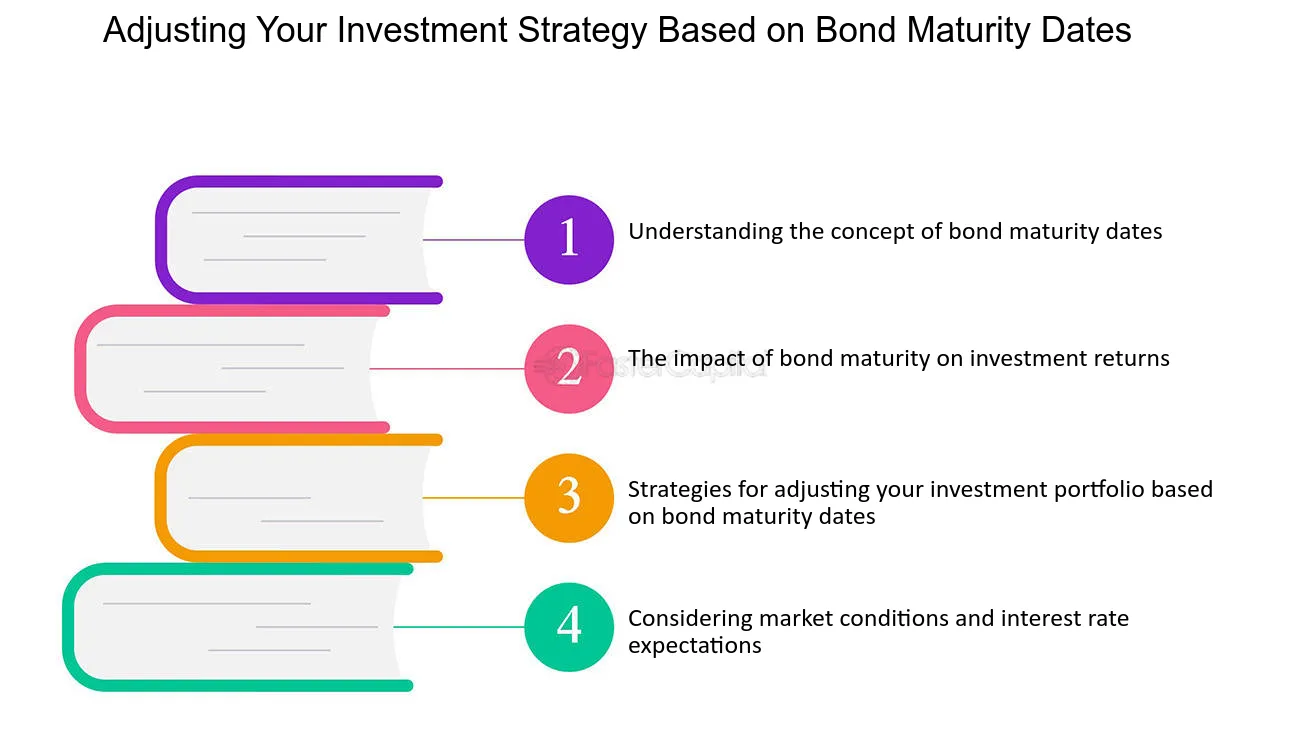
Adjusting Your Investment Strategy Based on Bond Maturity Dates - Maturity date: Adjusting Your Investment Strategy with Bond Maturity Dates
30. Benefits of Investing in Short-Term Bond Maturity Dates
When it comes to investing in bonds, one crucial factor to consider is the maturity date. The maturity date refers to the date on which the principal amount of a bond is due to be repaid to the investor. Bond maturity dates vary widely, ranging from short-term to long-term options. In this section, we will explore the benefits of investing in short-term bond maturity dates and why it may be a favorable strategy for investors.
1. Reduced Interest Rate Risk: Short-term bond maturity dates typically have lower interest rate risk compared to long-term bonds. Interest rates have a significant impact on bond prices, and when rates rise, bond prices tend to fall. By investing in short-term bonds, investors can mitigate this risk as the bonds mature relatively quickly, allowing them to reinvest their funds at potentially higher interest rates.
For example, suppose an investor purchases a 10-year bond with a fixed interest rate. If interest rates rise after the purchase, the value of the bond in the secondary market will decrease. However, if the investor had chosen a short-term bond with a maturity date of 2 years, they would have the opportunity to reinvest their funds in a higher interest rate environment after the bond matures.
2. Increased Liquidity: Short-term bonds offer greater liquidity compared to their long-term counterparts. Liquidity refers to the ease with which an investment can be bought or sold without causing a significant impact on its price. Short-term bonds typically have more active secondary markets, allowing investors to buy or sell their bonds quickly and at a fair price.
For instance, if an investor needs access to their funds urgently, holding short-term bonds provides the flexibility to sell them without facing significant liquidity challenges. On the other hand, selling long-term bonds prematurely may result in a lower price due to limited buyer interest or higher transaction costs.
3. Lower Default Risk: Short-term bonds generally carry lower default risk compared to long-term bonds. Default risk refers to the likelihood that the issuer of the bond will be unable to make timely interest or principal payments. By investing in bonds with shorter maturity dates, investors are exposed to the credit risk of the issuer for a shorter duration.
Consider a scenario where an investor holds a bond issued by a company that experiences financial difficulties. If the bond has a short-term maturity date, the investor will be exposed to the default risk for a shorter period. In contrast, if the bond has a long-term maturity date, the investor would bear the risk for a more extended period, increasing the likelihood of potential default.
4. Capital Preservation: Short-term bonds can be an attractive option for investors seeking capital preservation. The shorter duration of these bonds reduces the impact of market fluctuations on their value. Consequently, investors can have a higher level of confidence that their principal will be repaid upon maturity.
For example, let's say an investor is nearing retirement and wants to protect their investment capital from potential market volatility. By investing in short-term bonds, they can minimize the risk of significant capital loss and ensure the availability of funds when needed.
Investing in short-term bond maturity dates offers several benefits, including reduced interest rate risk, increased liquidity, lower default risk, and capital preservation. While long-term bonds may offer higher yields, they come with greater risks and a longer time commitment. Therefore, it is essential for investors to carefully consider their investment goals and risk tolerance to determine the best option for their portfolio.
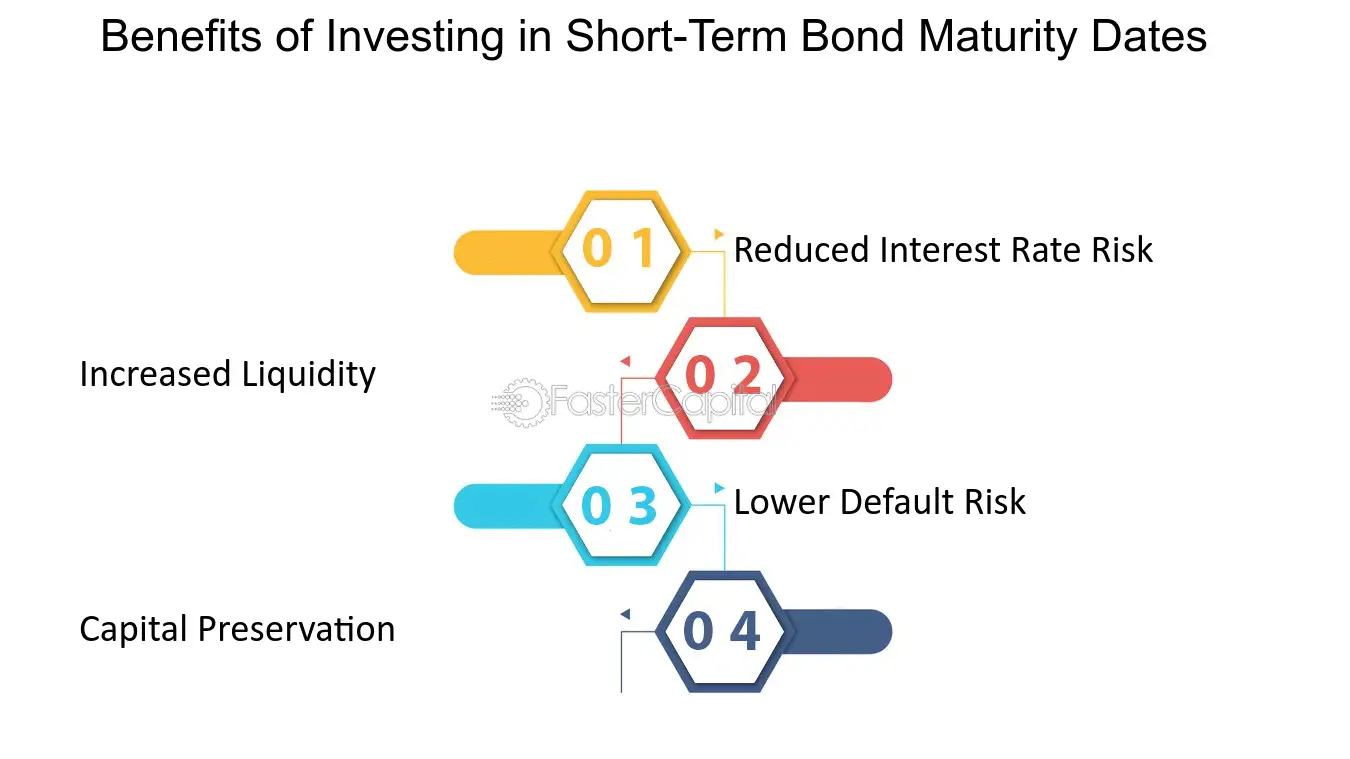
Benefits of Investing in Short Term Bond Maturity Dates - Maturity date: Adjusting Your Investment Strategy with Bond Maturity Dates
31. Opportunities and Considerations for Medium-Term Bond Maturity Dates
1. Understanding Medium-Term Bond Maturity Dates
When it comes to investing in bonds, one crucial aspect to consider is the maturity date. The maturity date represents the point in time when the issuer of the bond is obligated to repay the principal amount to the bondholder. While short-term bonds typically have maturity dates of one to three years, and long-term bonds extend beyond ten years, medium-term bonds fall somewhere in between, with maturity dates typically ranging from three to ten years.
From an investor's perspective, medium-term bond maturity dates offer a balance between the stability of longer-term bonds and the potential for higher returns associated with shorter-term bonds. However, it is essential to carefully evaluate the opportunities and considerations associated with investing in medium-term bonds.
2. Opportunities of Medium-Term Bond Maturity Dates
A) Flexibility: Medium-term bonds provide investors with a degree of flexibility that is often absent in longer-term bonds. With shorter maturity dates, investors have the opportunity to reassess their investment strategy at regular intervals and adjust their portfolio accordingly. This flexibility can be particularly valuable in a changing market environment where interest rates, economic conditions, and investment objectives may evolve over time.
B) Higher yields compared to short-term bonds: Medium-term bonds typically offer higher yields than their short-term counterparts. This increased yield potential can be attractive for investors seeking a balance between income generation and capital preservation. By locking in a medium-term bond with a higher yield, investors can potentially enhance their overall portfolio returns.
C) Lower interest rate risk compared to long-term bonds: Medium-term bonds also offer a level of protection against interest rate risk compared to long-term bonds. While long-term bonds are more sensitive to fluctuations in interest rates, medium-term bonds strike a balance between stability and the potential for higher returns. This makes them a suitable choice for investors seeking to mitigate interest rate risk while still aiming for moderate growth.
3. Considerations for Medium-Term Bond Maturity Dates
A) Reinvestment risk: One consideration when investing in medium-term bonds is the risk associated with reinvesting the principal amount once the bond matures. As medium-term bonds have shorter maturity dates, investors must carefully evaluate the prevailing interest rate environment at the time of reinvestment. If interest rates have significantly declined, the reinvestment of the principal may result in lower yields than initially anticipated.
B) Limited capital appreciation potential: Unlike longer-term bonds, medium-term bonds have limited capital appreciation potential. Investors looking for significant capital gains may find that longer-term bonds are better suited to their investment objectives. However, it is important to remember that the primary focus of medium-term bonds is income generation and capital preservation, making them an attractive option for conservative investors.
C) evaluating credit risk: As with any bond investment, investors must assess the creditworthiness of the issuer when considering medium-term bonds. Higher-yielding medium-term bonds may have a higher level of credit risk, which can impact the overall return potential and safety of the investment. Conducting thorough research and considering credit ratings can help investors make informed decisions and mitigate credit risk.
4. Comparing Options: Best Option for Medium-Term Bond Maturity Dates
When it comes to selecting the best option for medium-term bond maturity dates, it ultimately depends on an investor's risk tolerance, investment objectives, and time horizon. However, a balanced approach that considers both investment opportunities and potential risks is often recommended.
Investors seeking stability, flexibility, and higher yields may find medium-term bonds an attractive choice. By carefully evaluating the prevailing interest rate environment, reinvestment risk can be mitigated, ensuring that the potential for income generation remains intact. Additionally, considering credit ratings and diversifying across issuers can help minimize credit risk.
Medium-term bond maturity dates offer investors a balanced investment option, combining stability and potential for moderate growth. By understanding the opportunities and considerations associated with these bonds, investors can make informed decisions that align with their financial goals and risk appetite.
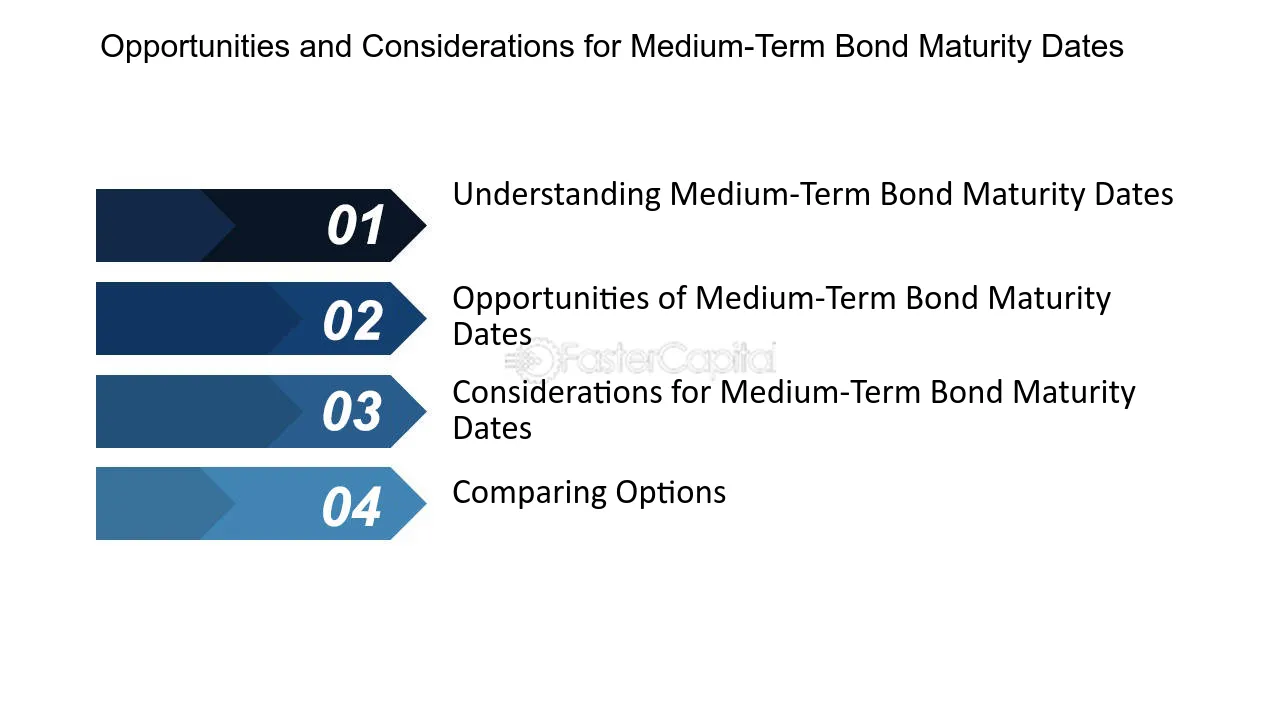
Opportunities and Considerations for Medium Term Bond Maturity Dates - Maturity date: Adjusting Your Investment Strategy with Bond Maturity Dates
32. Spreading Risk Across Different Bond Maturity Dates
Diversification is a key strategy in any investment portfolio. By spreading risk across different assets, investors can mitigate the impact of a single investment's performance on their overall returns. When it comes to bond investments, diversification can be achieved not only through investing in different bond issuers or sectors but also by spreading the investment across different bond maturity dates. This approach can help investors manage interest rate risk and potentially enhance their overall portfolio returns.
1. understanding bond maturity dates: bond maturity refers to the length of time until the bond issuer repays the principal amount to the bondholder. Bonds can have various maturity dates, ranging from short-term (less than a year) to long-term (over 10 years). Each maturity date carries its own set of risks and potential rewards.
2. Spreading risk with different maturity dates: By investing in bonds with various maturity dates, investors can reduce their exposure to interest rate risk. When interest rates rise, the value of existing bonds tends to decline. However, by holding bonds with different maturity dates, investors can benefit from reinvesting the principal and interest payments at higher rates as bonds mature.
For example, suppose an investor holds a portfolio consisting of both short-term and long-term bonds. If interest rates rise, the short-term bonds will mature sooner, allowing the investor to reinvest the proceeds at the higher rates. On the other hand, the long-term bonds may experience a temporary decline in value but will still provide steady interest income until they mature.
3. balancing risk and return: Different maturity dates offer varying levels of risk and return potential. Short-term bonds are generally considered less risky than long-term bonds since they are less sensitive to changes in interest rates. However, they also tend to offer lower yields compared to long-term bonds. On the other hand, long-term bonds may provide higher yields but are more susceptible to interest rate fluctuations.
Investors should consider their risk tolerance, investment goals, and market conditions when deciding how to allocate their investment across different bond maturity dates. A well-diversified portfolio may include a mix of short-term, intermediate-term, and long-term bonds to balance risk and optimize returns.
4. assessing market conditions: It is crucial to evaluate the prevailing interest rate environment when deciding on bond maturity dates. If interest rates are expected to rise, investors may lean towards shorter-term bonds to minimize potential losses. Conversely, if interest rates are expected to decline or remain low, longer-term bonds may be more attractive for their higher yields.
5. Consider bond ladder strategy: One popular approach to diversify bond maturity dates is by implementing a bond ladder strategy. This strategy involves investing in bonds with staggered maturity dates, creating a continuous stream of income and reinvestment opportunities.
For instance, an investor can construct a bond ladder by purchasing bonds with maturities of one, three, five, and ten years. As each bond matures, the proceeds can be reinvested in new bonds at the longest maturity in the ladder. This strategy provides a balance between regular income and the potential for higher returns from longer-term bonds.
Diversification is a fundamental principle in investment strategy, and spreading risk across different bond maturity dates is an effective way to achieve it. By investing in bonds with various maturity dates, investors can manage interest rate risk and potentially enhance their overall portfolio returns. Balancing risk and return, assessing market conditions, and considering strategies like bond laddering can help investors optimize their bond maturity date allocations.
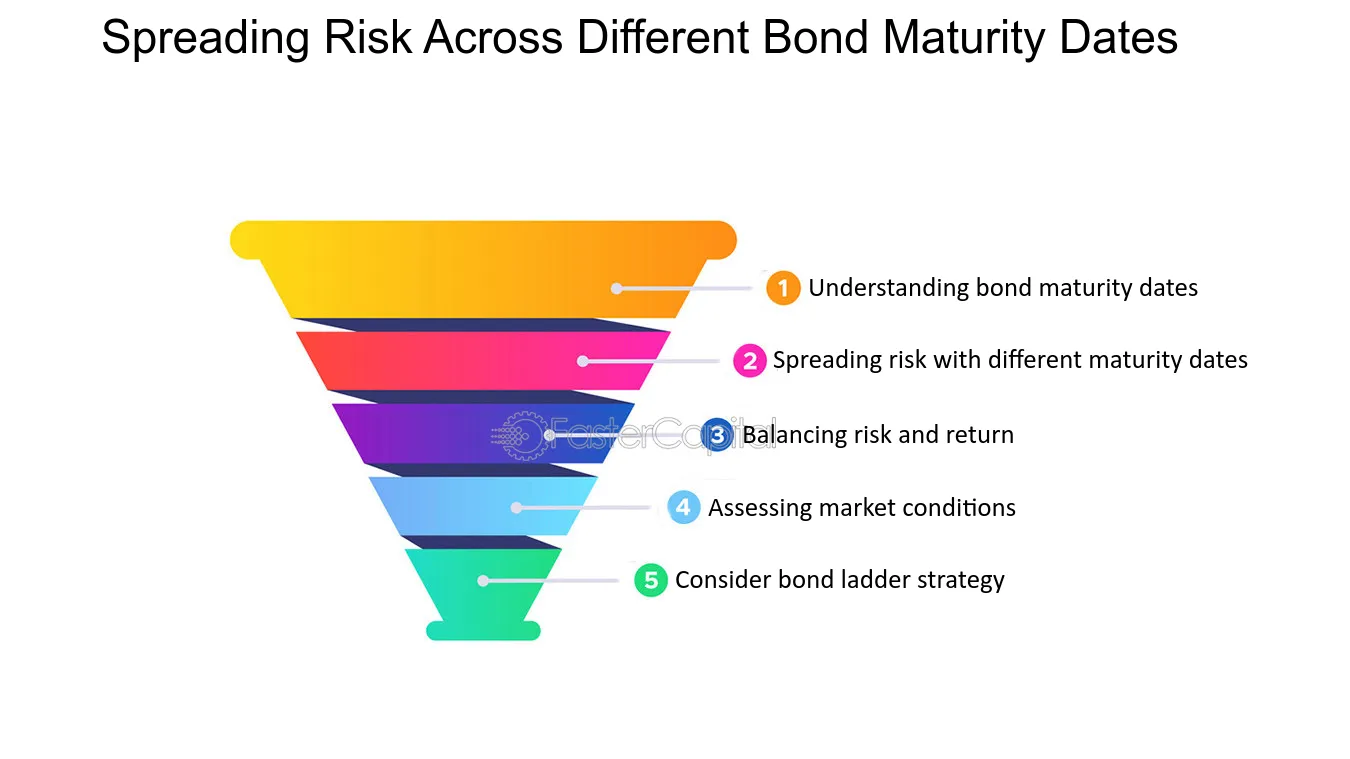
Spreading Risk Across Different Bond Maturity Dates - Maturity date: Adjusting Your Investment Strategy with Bond Maturity Dates
33. Understanding Short Coupon Bond Maturity Risk
1. short coupon bonds are a type of fixed-income security that have gained popularity among investors due to their relatively low risk and attractive returns. However, like any investment, short coupon bonds come with their own set of risks that investors need to be aware of. One such risk is the maturity risk associated with these bonds. In this section, we will delve into the concept of short coupon bond maturity risk and discuss how investors can manage and mitigate this risk effectively.
2. Maturity risk refers to the potential loss or decrease in value that investors may face if they hold a short coupon bond until its maturity date. Unlike regular coupon bonds, which typically have longer maturity periods, short coupon bonds have a shorter time frame until maturity, usually ranging from one to five years. This condensed time period exposes investors to a higher level of risk, as market fluctuations and changes in interest rates can have a more significant impact on the bond's value.
3. To better understand short coupon bond maturity risk, let's consider an example. Suppose an investor purchases a short coupon bond with a face value of $10,000 and an annual coupon rate of 4%. The bond has a maturity period of three years. In the first year, the bondholder receives a coupon payment of $400 (4% of $10,000). However, if interest rates rise in the second year, new bonds with higher coupon rates may become available in the market. As a result, the value of the investor's bond, which has a lower coupon rate, may decrease. If the investor decides to sell the bond before maturity, they may incur a loss.
4. To manage short coupon bond maturity risk, investors can employ several strategies. Firstly, diversification is key. Spreading investments across different short coupon bonds with varying maturities and issuers can help mitigate the risk associated with a single bond. By diversifying their portfolio, investors can reduce the impact of any individual bond's performance on their overall investment.
5. Secondly, staying updated on market conditions and interest rate movements is crucial. Monitoring economic indicators, such as inflation rates and central bank policies, can provide valuable insights into potential changes in interest rates. By staying informed, investors can make informed decisions regarding their short coupon bond investments, such as deciding whether to hold or sell a bond based on prevailing market conditions.
6. Lastly, it is essential to consider the creditworthiness of the bond issuer. Short coupon bonds are typically issued by corporations or governments, and their creditworthiness can vary. Investing in bonds issued by entities with strong credit ratings can help reduce the risk of default and increase the likelihood of receiving coupon payments until maturity.
7. In conclusion, understanding and managing short coupon bond maturity risk is crucial for investors looking to maximize their returns while minimizing potential losses. By diversifying their portfolio, staying informed about market conditions, and assessing the creditworthiness of bond issuers, investors can effectively mitigate the risks associated with short coupon bond investments. Stay tuned for the next section, where we will explore another aspect of managing short coupon bond maturity risk.
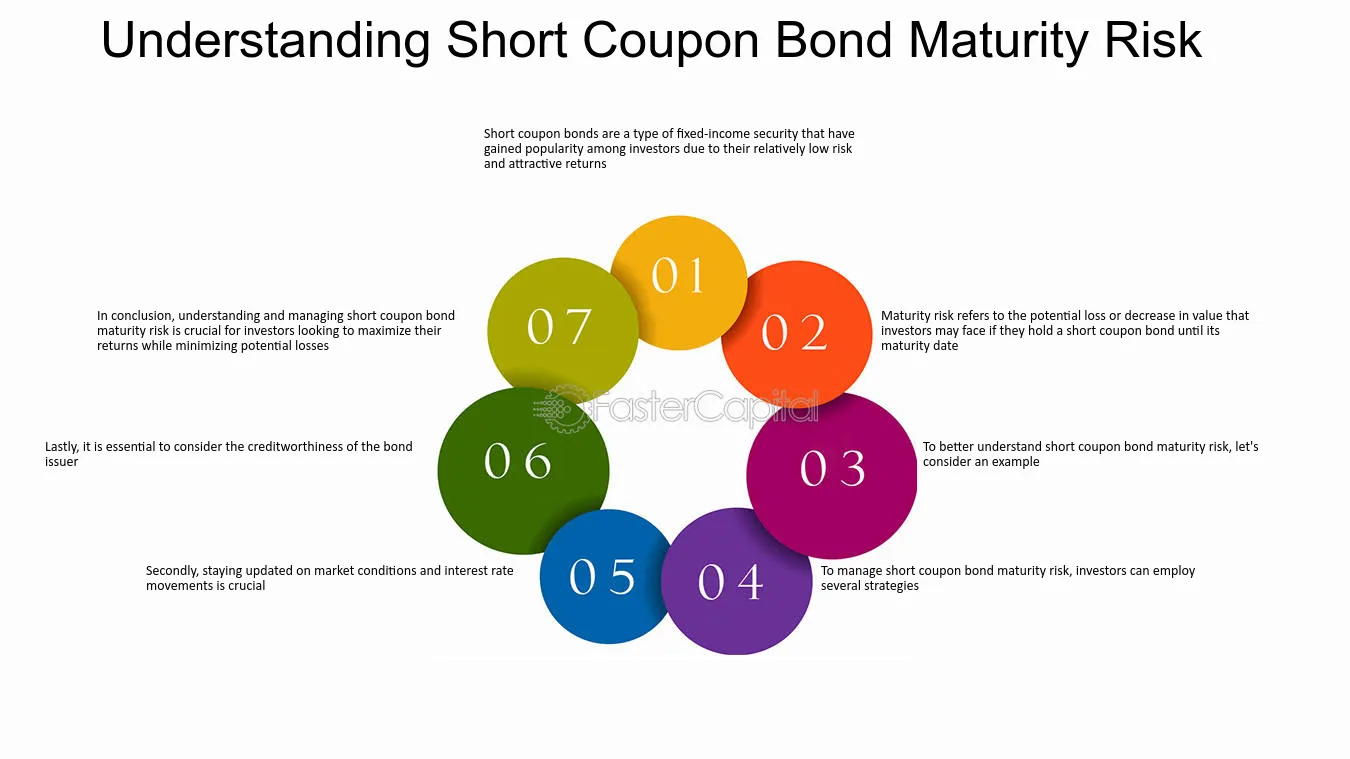
Understanding Short Coupon Bond Maturity Risk - Maturity Date: Managing Short Coupon Bond Maturity Risk
34. Strategies for Managing Short Coupon Bond Maturity Risk
1. Diversify your portfolio: One of the most effective strategies for managing short coupon bond maturity risk is to diversify your bond portfolio. By investing in bonds with varying maturity dates, you can spread out the risk and reduce the impact of any individual bond's maturity. For example, instead of investing all your funds in bonds with the same maturity date, consider investing in bonds with staggered maturities, such as bonds that mature in 1, 3, and 5 years. This way, even if one bond matures and you need to reinvest the proceeds, you will still have other bonds in your portfolio that continue to provide income.
2. Monitor interest rate movements: Short coupon bonds are particularly sensitive to changes in interest rates. When interest rates rise, the value of existing bonds tends to decline, and vice versa. Therefore, it is crucial to closely monitor interest rate movements and adjust your portfolio accordingly. For instance, if you anticipate a rise in interest rates, you may want to consider selling short coupon bonds that are close to maturity and reinvest in longer-term bonds with higher coupon rates. This strategy can help mitigate the risk of reinvesting at lower rates when your short coupon bond matures.
3. Consider callable bonds: Callable bonds give the issuer the option to redeem the bond before its maturity date. While this may seem disadvantageous, callable bonds often offer higher coupon rates to compensate for the risk of early redemption. By carefully selecting callable bonds with attractive yields and evaluating the issuer's likelihood of exercising the call option, you can potentially benefit from higher yields while managing the risk of early redemption.
4. Take advantage of laddering: laddering is a strategy that involves investing in bonds with staggered maturities, similar to diversifying your portfolio. However, the key difference is that laddering involves reinvesting the proceeds from maturing bonds into new bonds with a similar maturity date. This strategy helps maintain a consistent income stream while reducing the impact of interest rate fluctuations. For example, if you have a ladder of short coupon bonds with maturities ranging from 1 to 5 years, you will have bonds maturing and reinvesting every year, providing a steady stream of income and reducing the risk of reinvesting all your funds at once.
5. seek professional advice: Managing short coupon bond maturity risk can be complex, especially for individual investors. Seeking advice from a financial advisor or bond specialist can provide valuable insights and guidance tailored to your specific investment goals and risk tolerance. They can help you analyze market trends, identify suitable bonds, and develop a comprehensive strategy to manage the risk effectively.
Overall, managing short coupon bond maturity risk requires careful planning and a proactive approach. By diversifying your portfolio, monitoring interest rate movements, considering callable bonds, utilizing laddering, and seeking professional advice, you can effectively navigate the challenges posed by short coupon bond maturities and optimize your investment returns.
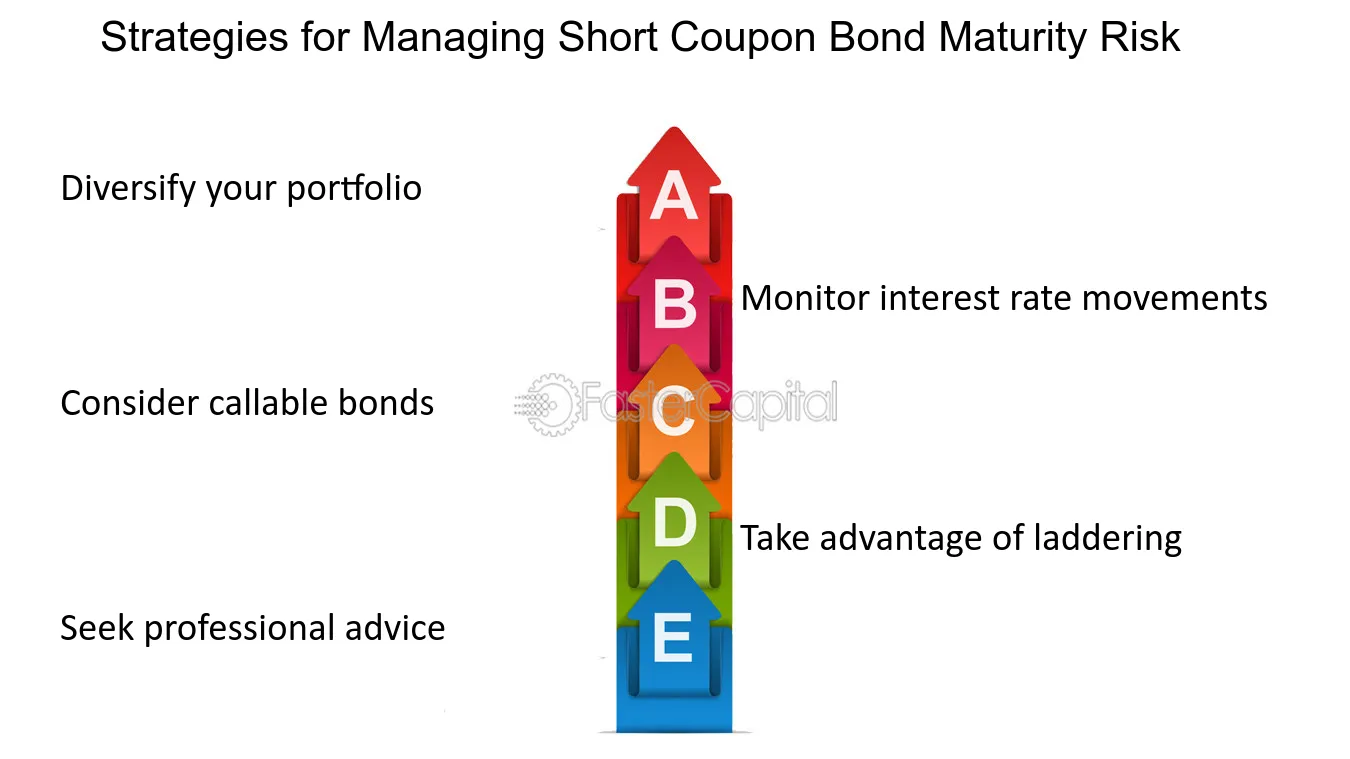
Strategies for Managing Short Coupon Bond Maturity Risk - Maturity Date: Managing Short Coupon Bond Maturity Risk
35. The Role of Interest Rates in Short Coupon Bond Maturity Risk
1. The role of Interest rates in Short Coupon Bond Maturity Risk
When it comes to managing short coupon bond maturity risk, one of the key factors to consider is the role of interest rates. Interest rates play a crucial role in determining the value and risk associated with these bonds. In this section, we will delve into the various aspects of interest rates and how they impact the maturity risk of short coupon bonds.
2. Impact of Interest Rate Changes
Interest rate changes have a direct impact on the value of short coupon bonds. When interest rates rise, the value of existing bonds decreases, as new bonds with higher coupon rates become more attractive to investors. Conversely, when interest rates fall, the value of existing bonds increases, as they offer higher coupon rates compared to newly issued bonds.
For example, let's consider a scenario where an investor purchases a short coupon bond with a fixed interest rate of 4%. If interest rates rise to 5% after the purchase, the value of the bond will decrease, as investors can now purchase new bonds with higher coupon rates. This decrease in value exposes the investor to maturity risk if they decide to sell the bond before its maturity date.
3. Reinvestment Risk
Another aspect of interest rates that affects short coupon bond maturity risk is reinvestment risk. Reinvestment risk refers to the uncertainty associated with reinvesting coupon payments at prevailing interest rates. When interest rates are low, reinvesting coupon payments becomes challenging, as the investor may struggle to find attractive investment opportunities that offer comparable returns. This can lead to a reduction in overall returns and potentially impact the bond's maturity risk.
For instance, let's assume an investor receives semi-annual coupon payments from a short coupon bond. If interest rates decline over time, the investor may face difficulties reinvesting these payments at the same rate as the initial bond purchase. Consequently, the investor may have to settle for lower returns, increasing the maturity risk of the bond.
4. Case Study: The impact of Changing Interest rates on Short Coupon Bond Maturity Risk
To illustrate the role of interest rates in short coupon bond maturity risk, let's consider a case study. Suppose an investor purchases a short coupon bond with a fixed interest rate of 3% for a period of five years. After two years, interest rates in the market rise to 4%.
In this scenario, the value of the bond will decrease, as new bonds with higher coupon rates become more attractive to investors. If the investor decides to sell the bond before its maturity date, they may face a loss due to the decreased value. This highlights the importance of considering interest rate movements when managing short coupon bond maturity risk.
5. Tips for Managing Short Coupon Bond Maturity Risk
To effectively manage short coupon bond maturity risk in relation to interest rates, here are a few tips:
- Stay informed about changes in interest rates: Regularly monitor interest rate movements to assess potential impacts on the value and risk of short coupon bonds.
- Diversify your bond portfolio: By diversifying your bond holdings, you can mitigate the impact of interest rate changes on individual bonds.
- Consider bond duration: Shorter duration bonds tend to be less sensitive to interest rate changes, reducing the maturity risk associated with fluctuations in interest rates.
- Evaluate reinvestment options: assess the available investment opportunities to reinvest coupon payments at prevailing interest rates, considering the potential impact on overall returns and maturity risk.
Interest rates play a significant role in short coupon bond maturity risk. Changes in interest rates can impact the value of these bonds and introduce reinvestment risk. By understanding and considering the role of interest rates, investors can effectively manage and mitigate the maturity risk associated with short coupon bonds.
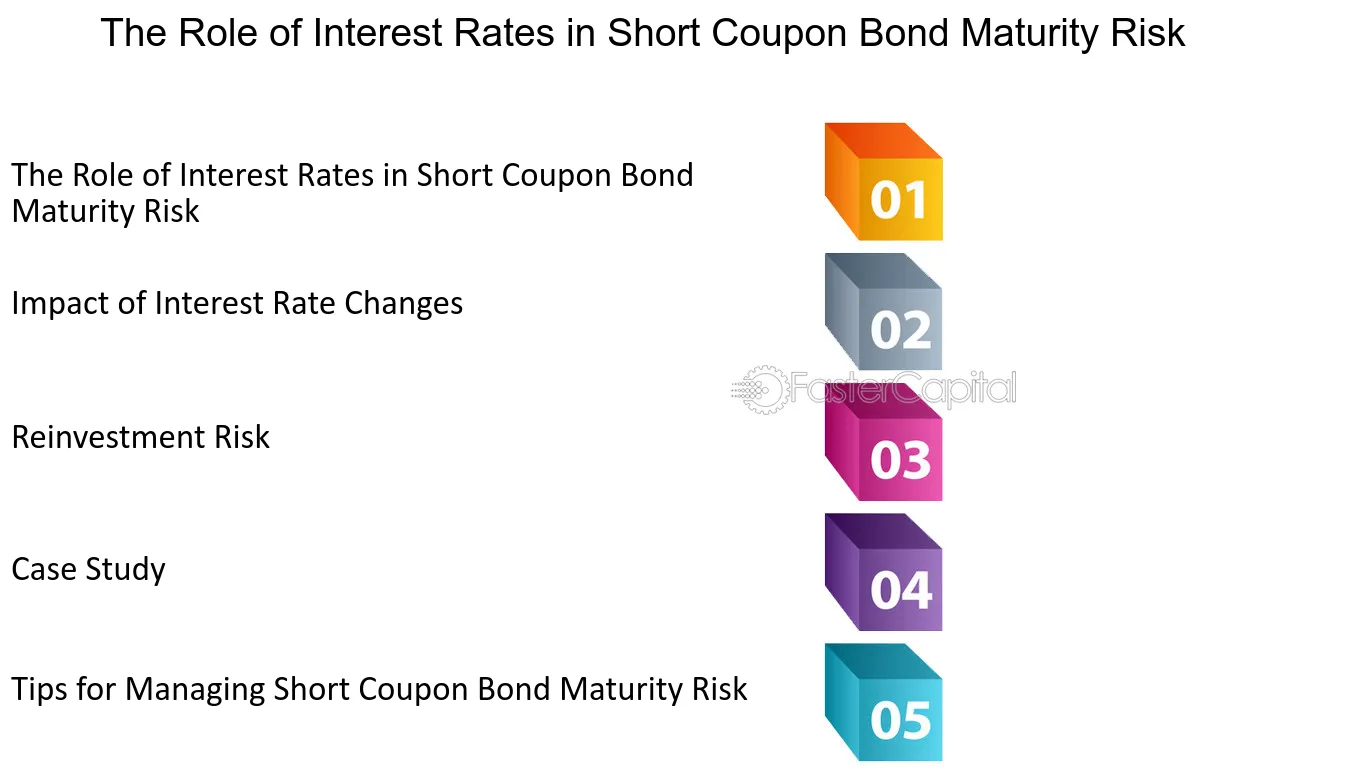
The Role of Interest Rates in Short Coupon Bond Maturity Risk - Maturity Date: Managing Short Coupon Bond Maturity Risk
36. Understanding Bond Maturity Dates
When investing in bonds, it's important to understand the concept of bond maturity dates. The maturity date is the date on which the bond issuer is obligated to repay the principal amount of the bond to the bondholder. This is a crucial aspect of bond investing as it determines the length of time that the investor's money will be tied up in the investment.
1. Short-term vs. Long-term maturity dates
Bonds can have varying maturity dates, ranging from short-term to long-term. Short-term bonds have maturity dates of one to three years, while long-term bonds can have maturity dates of 10, 20, or even 30 years. Short-term bonds are generally considered less risky than long-term bonds as they are less susceptible to interest rate fluctuations. However, long-term bonds tend to offer higher yields, making them more attractive to investors seeking higher returns.
2. Callable bonds
Some bonds have a callable feature, which means that the issuer has the right to call back the bond before its maturity date. This can be beneficial for the issuer if interest rates have fallen since the bond was issued, as they can refinance at a lower rate. However, it can be detrimental to the investor if they were counting on a certain yield for a specific period of time, as the bond may be called back before that time.
3. Zero-coupon bonds
Zero-coupon bonds are bonds that do not pay interest but are sold at a discount to their face value. The investor receives the face value of the bond at maturity, effectively earning interest on the difference between the purchase price and the face value. Zero-coupon bonds typically have long-term maturity dates, making them a good option for investors who are willing to tie up their money for an extended period of time.
4. Bond ladders
One strategy for managing bond maturity dates is to create a bond ladder. This involves purchasing bonds with staggered maturity dates, such as one-year, three-year, and five-year bonds. This allows the investor to have a steady stream of cash flow as the bonds mature and are reinvested. Bond ladders can also help to mitigate interest rate risk, as the investor is not tied to a single maturity date.
5. Rolling over bonds
Another option for managing bond maturity dates is to roll over bonds as they mature. This involves reinvesting the principal amount of the bond into a new bond with a similar maturity date. Rolling over bonds can be a good strategy for investors who want to maintain a consistent level of investment in bonds, but it does require careful monitoring of interest rates and bond yields.
Understanding bond maturity dates is an important aspect of bond investing. Short-term and long-term maturity dates, callable bonds, zero-coupon bonds, bond ladders, and rolling over bonds are all options for managing bond maturity dates. Each option has its own advantages and disadvantages, and the best strategy will depend on the investor's individual goals and risk tolerance.
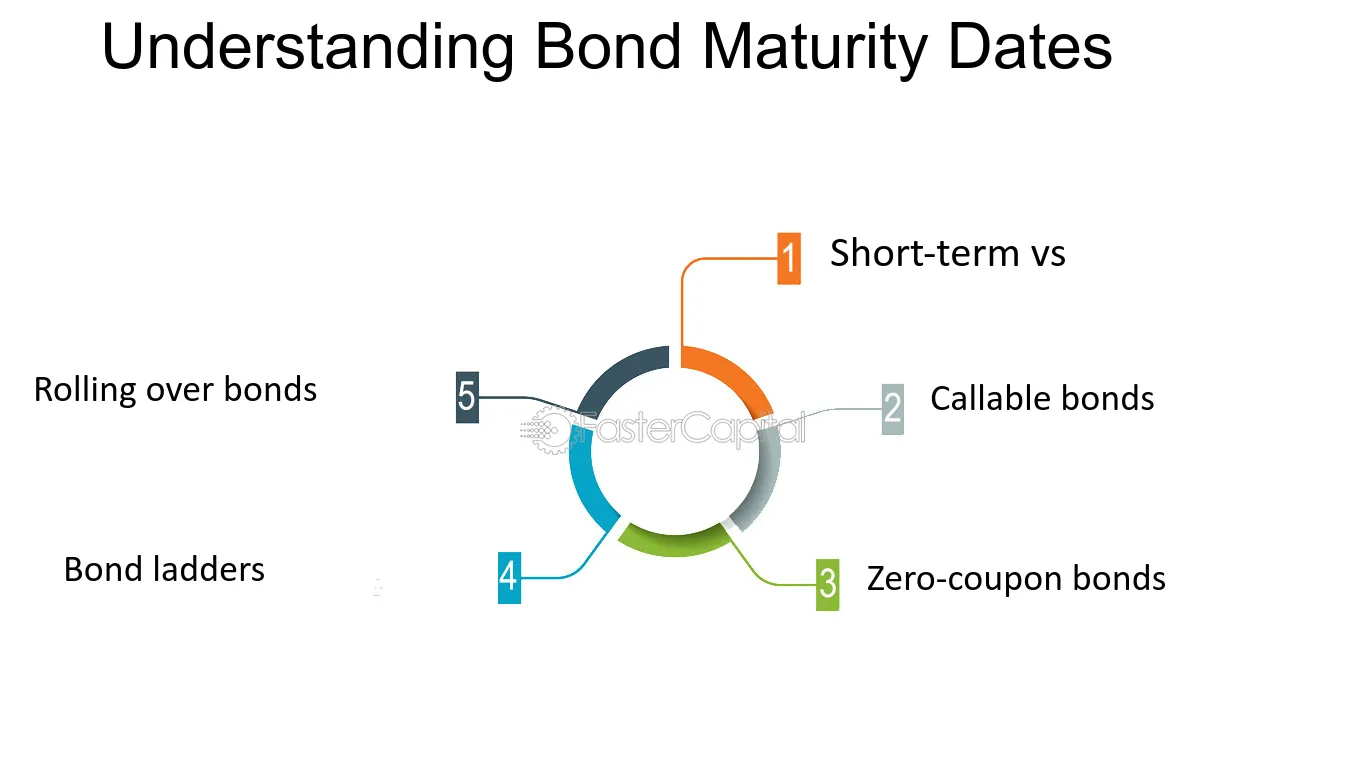
Understanding Bond Maturity Dates - Maturity Date: Navigating Maturity Dates in Bond Investments
37. Factors Affecting Bond Maturity Dates
When investing in bonds, it is important to understand the factors that can affect the maturity date of your investment. The maturity date is the date on which the principal amount of the bond is due to be repaid to the investor. While some bonds have a fixed maturity date, others may have a range of possible maturity dates, which can be influenced by a variety of factors.
1. Type of Bond
The type of bond you invest in can have a significant impact on its maturity date. For example, a Treasury bond typically has a fixed maturity date, while a municipal bond may have a range of possible maturity dates. Corporate bonds can also have a range of possible maturity dates, depending on the specific terms of the bond.
2. Interest Rates
Interest rates can also affect the maturity date of a bond. If interest rates rise, the bond's maturity date may be extended to compensate for the increased interest rate. Conversely, if interest rates fall, the bond's maturity date may be shortened to reflect the lower interest rate.
3. Credit Quality
The credit quality of the issuer can also affect the maturity date of a bond. If the issuer's credit rating deteriorates, the bond's maturity date may be extended to reflect the increased risk to investors. Conversely, if the issuer's credit rating improves, the bond's maturity date may be shortened to reflect the reduced risk to investors.
4. Call Provisions
Some bonds may have call provisions that allow the issuer to call or redeem the bond before its maturity date. This can result in the bond having a shorter maturity date than initially anticipated. For example, if interest rates fall after a bond is issued, the issuer may call the bond and issue a new bond at a lower interest rate.
5. Yield-to-Maturity
Yield-to-maturity is the total return anticipated on a bond if it is held until its maturity date. The yield-to-maturity can be affected by a variety of factors, including interest rates, credit quality, and call provisions. Investors should carefully consider the yield-to-maturity when investing in bonds, as it can have a significant impact on their overall return.
Understanding the factors that can affect the maturity date of a bond is essential for investors. By considering the type of bond, interest rates, credit quality, call provisions, and yield-to-maturity, investors can make informed decisions about their bond investments. It is important to remember that each bond is unique and may be affected by different factors, so investors should carefully review the terms of each bond before investing.
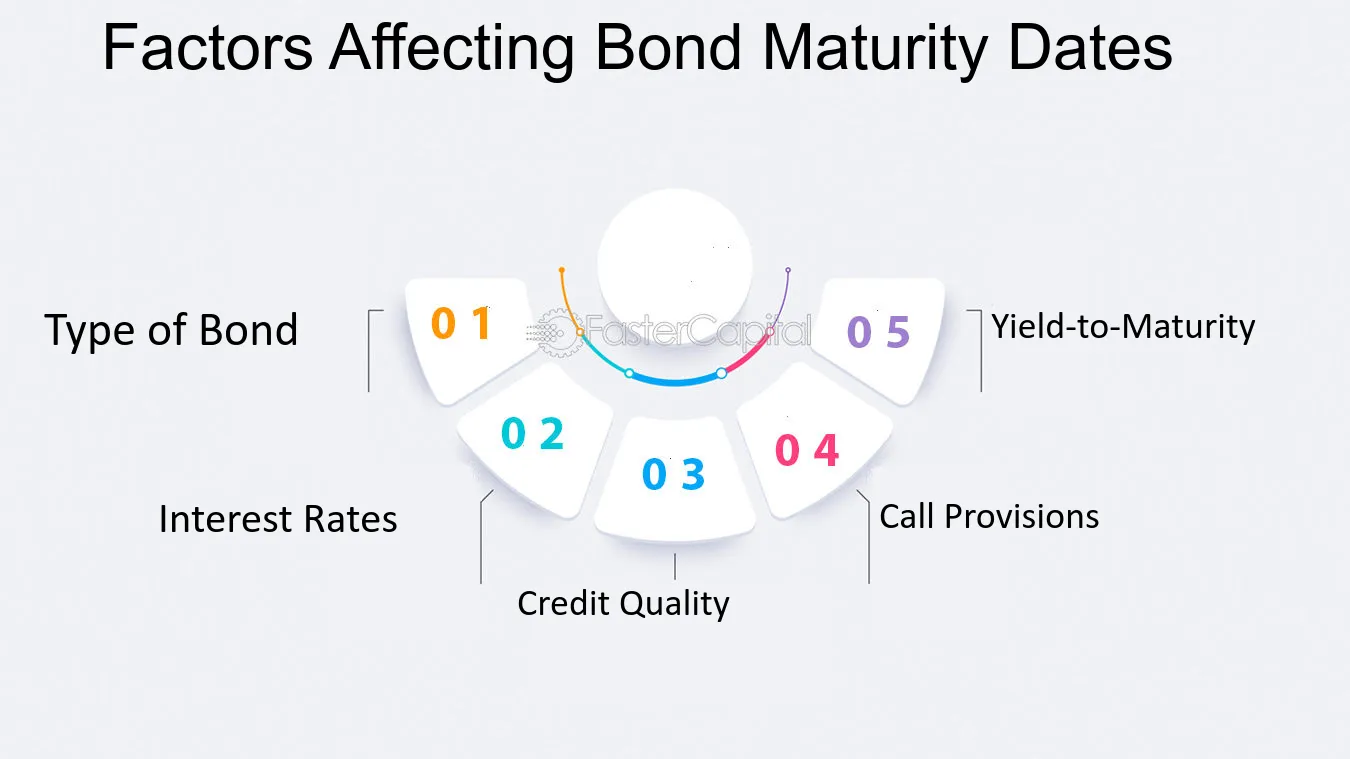
Factors Affecting Bond Maturity Dates - Maturity Date: Navigating Maturity Dates in Bond Investments
38. Introduction to Treasury Bond Maturity
Maturity date is an important aspect of any investment, and Treasury bonds are no exception. The maturity date is the date when the principal amount of a Treasury bond is due to be paid back to the investor. understanding Treasury bond maturity is essential for any investor looking to invest in bonds, as it can affect the return on investment and the risks involved. Different investors have different views on maturity date, some prefer short-term bonds, while others prefer long-term bonds. In this section, we will discuss Treasury bond maturity in detail, including its types, characteristics, and how it can affect your investment.
Here are some important points to consider when it comes to Treasury bond maturity:
1. Types of Treasury Bonds: Treasury bonds come in different types, such as Treasury bills, Treasury notes, and Treasury bonds. Each type has a different maturity date, ranging from a few days to several years. Treasury bills have the shortest maturity date, usually ranging from a few days to a year. Treasury notes have a medium-term maturity, usually ranging from 1 to 10 years, while Treasury bonds have a long-term maturity, usually ranging from 10 to 30 years.
2. yield curve: The yield curve is a graph that shows the relationship between the yield of Treasury bonds and their maturity date. The yield curve can provide valuable insights into the bond market's expectations for inflation, economic growth, and interest rates. A steep yield curve indicates that investors expect higher inflation and interest rates in the future, while a flat yield curve indicates that investors expect lower inflation and interest rates in the future.
3. Interest Rates: Maturity date can affect the interest rates on Treasury bonds. Generally, longer-term bonds have a higher interest rate than shorter-term bonds, as investors demand a higher return for the increased risk of holding a longer-term bond. This is known as the term premium, and it can affect your investment returns.
4. Risks: Longer-term bonds can be riskier than shorter-term bonds, as they are subject to more fluctuations in interest rates and inflation. If interest rates rise, the value of a longer-term bond may decline, and investors may lose money if they sell the bond before maturity. However, longer-term bonds can provide a higher return if interest rates remain stable or decline.
5. Examples: Let's say you invest $10,000 in a 10-year Treasury bond with a 2% interest rate. You will receive $200 per year in interest payments, and your principal amount of $10,000 will be returned to you at maturity. On the other hand, if you invest $10,000 in a 30-year Treasury bond with a 3% interest rate, you will receive $300 per year in interest payments, but your money will be tied up for a longer period, and you will be subject to more risks.
Treasury bond maturity is an essential aspect of any investment strategy, and it can affect your return on investment and risks involved. Understanding the different types of Treasury bonds, the yield curve, interest rates, and risks can help you make informed investment decisions that align with your financial goals.
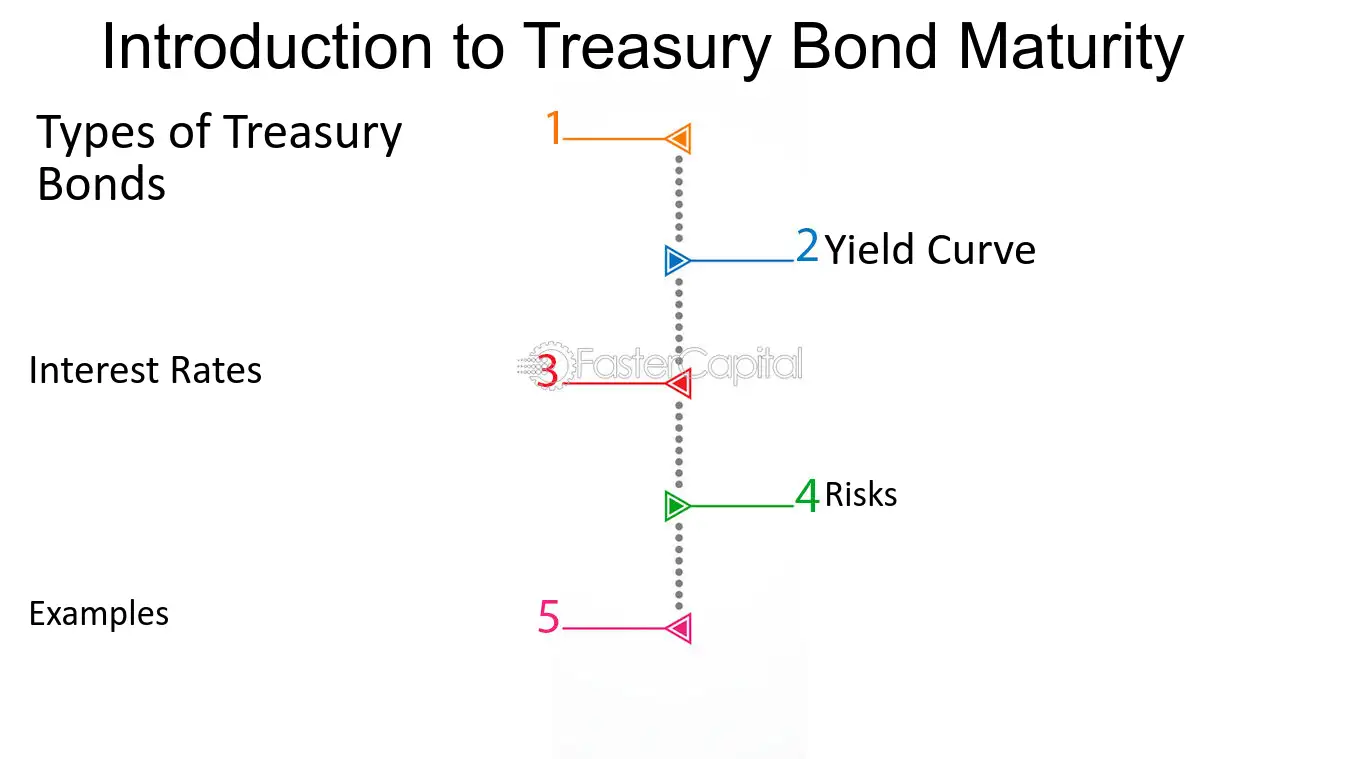
Introduction to Treasury Bond Maturity - Maturity Date: Planning Your Financial Future with Treasury Bond Maturity
39. Factors Affecting Treasury Bond Maturity
When it comes to treasury bond maturity, there are several factors that can impact the length of time it takes for a bond to reach maturity. While some of these factors may be outside of an investor's control, understanding them can be crucial in helping to plan for the future. From the perspective of the issuer, factors such as prevailing interest rates, economic conditions, and the level of demand for the bond can all impact the maturity date. For instance, if interest rates rise after a bond has been issued, the issuer may be more likely to call the bond and issue a new one with a higher coupon rate. This can shorten the maturity of the original bond and leave investors with less time to earn interest.
From the perspective of the investor, the timing of the purchase can also play a role in determining maturity. Bonds that are purchased shortly after issuance will typically have a longer maturity than those purchased later on. Additionally, the specific type of bond can also impact maturity. For example, Treasury Inflation-Protected Securities (TIPS) have a maturity date of 30 years, while other types of bonds may have shorter or longer maturities.
Here are some additional factors that can affect treasury bond maturity:
1. Call Provisions: As mentioned earlier, issuers may have the option to call a bond before it reaches maturity. This can happen if interest rates have fallen since the bond was issued, allowing the issuer to refinance at a lower rate. This can lead to a shortened maturity for the bond.
2. coupon rate: The coupon rate on a bond can also impact maturity. Bonds with higher coupon rates may be more likely to be called early, as the issuer may be able to save money by issuing a new bond at a lower rate.
3. Yield Curve: The shape of the yield curve can also impact bond maturity. In an environment where long-term interest rates are higher than short-term rates, bonds with longer maturities may be more attractive to investors. This can lead to longer maturities for certain bonds.
There are a variety of factors that can impact treasury bond maturity, both from the perspective of the issuer and the investor. By understanding these factors, investors can make more informed decisions about their investments and plan for their financial future accordingly.
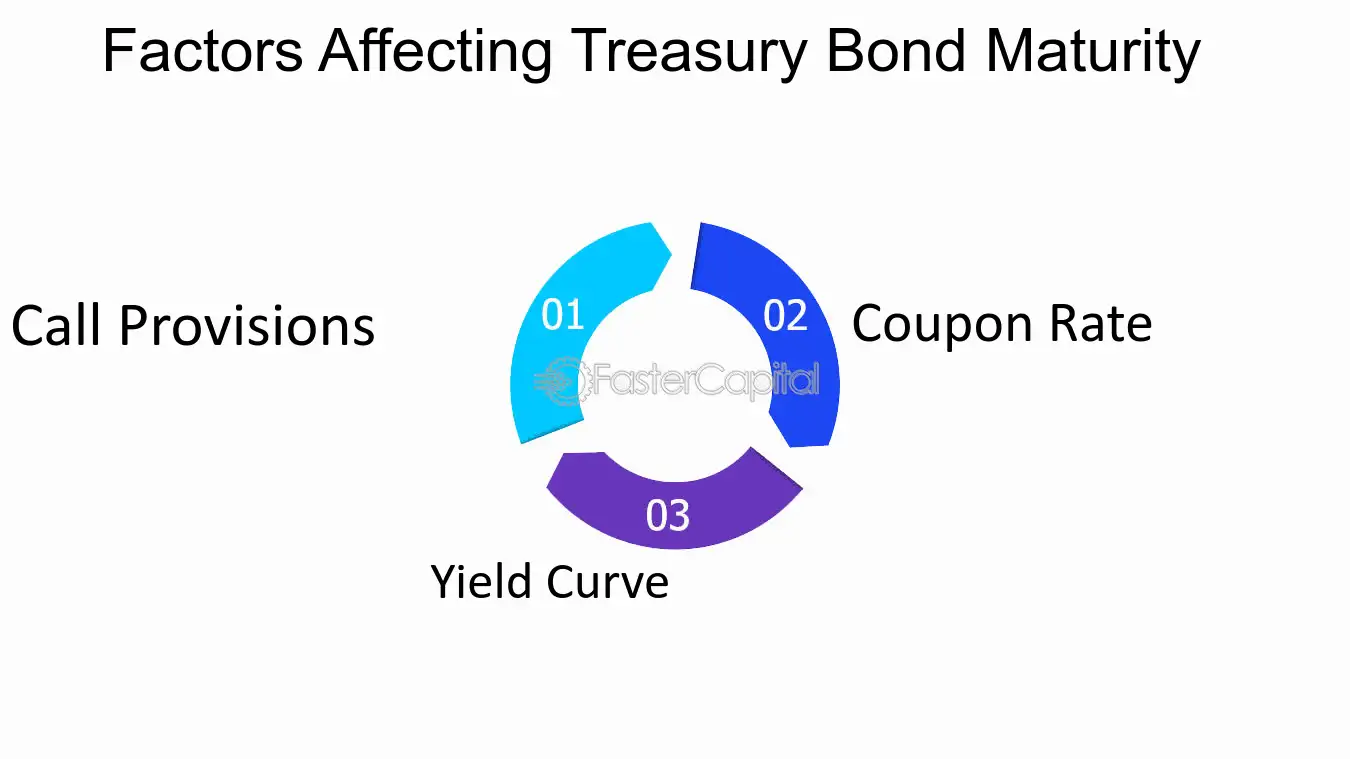
Factors Affecting Treasury Bond Maturity - Maturity Date: Planning Your Financial Future with Treasury Bond Maturity
40. Introduction to Bond Maturity and Debt Tender Offers
Bond maturity is a significant aspect of the bond market that every bond investor should be aware of. It refers to the date when the bond issuer needs to repay the principal amount to the bondholders. The bond maturity period can range from a few months to several decades, depending on the bond's type and issuer. Investors need to be aware of the bond maturity period as it helps them plan their investment strategy and manage their cash flows. If the bond matures, investors can reinvest their money in other investment options, but if the bond issuer defaults, it can lead to significant losses.
One of the ways investors can manage their bond maturity is through debt tender offers. A debt tender offer is a process where the bond issuer invites the bondholders to sell their bonds back to the issuer at a premium or discount to the face value. The bond issuer uses the money to reduce its debt burden or to restructure its outstanding debt. If the bondholder accepts the offer, they receive cash for their bonds and can reinvest in other securities.
To understand debt tender offers better, let's look at some of the key aspects of this process:
1. Tender Offer Price: The tender offer price is the price at which the bond issuer is willing to buy back the bonds. It can be at a premium or discount to the bond's face value, depending on market conditions and the issuer's financial position.
2. Tender Offer Period: The tender offer period is the duration during which the bondholders can accept the offer. The issuer sets a deadline, and bondholders who want to participate must sell their bonds within this period.
3. Minimum and Maximum Tender Amount: The issuer can set a minimum and maximum tender amount to limit the number of bonds it wants to buy back. If the bondholder offers more than the maximum amount, the issuer can prorate the amount to buy back the bonds.
4. Bondholders' Decision: Bondholders need to decide whether to participate in the debt tender offer or not. They need to consider the tender offer price, their investment strategy, and their future cash flows before making a decision.
For example, suppose ABC Corporation issues bonds worth $100 million with a maturity period of ten years. After five years, ABC Corporation wants to reduce its debt burden and offers a debt tender offer to bondholders. It offers a tender price of $105 for every $100 bond and sets a maximum tender amount of $20 million. The tender offer period is three weeks, and bondholders need to decide whether to participate or not. If a bondholder accepts the offer, they will receive $105 for every $100 bond and can reinvest in other securities.
Debt tender offers are an effective way for bond issuers to manage their debt burden and for bondholders to manage their bond maturity. Bondholders need to evaluate the tender offer price, their investment strategy, and their future cash flows before making a decision.
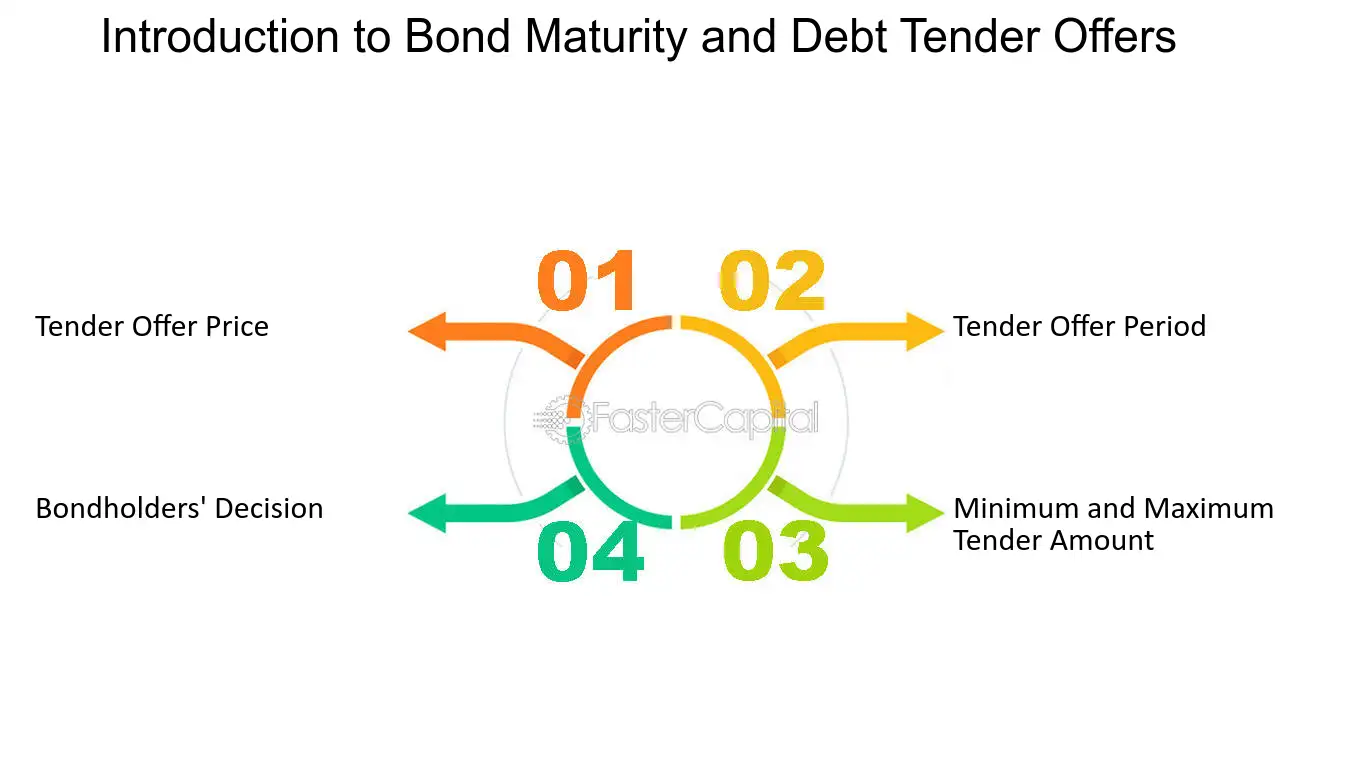
Introduction to Bond Maturity and Debt Tender Offers - Planning Ahead: Managing Bond Maturity through Debt Tender Offers
41. Benefits of Managing Bond Maturity through Debt Tender Offers
Managing bond maturity through debt tender offers is an excellent strategy for investors who want to maximize their returns while minimizing their risks. This approach can benefit both bond issuers and investors in several ways. For issuers, debt tender offers can help reduce their debt burden by repurchasing outstanding bonds at a lower price. This, in turn, can help improve their credit ratings and lower their borrowing costs. For investors, debt tender offers can provide a way to earn higher returns on their investments by selling their bonds back to the issuer at a premium. Additionally, this can help investors avoid the risks associated with holding bonds to maturity, such as interest rate fluctuations and credit risk.
Here are some of the key benefits of managing bond maturity through debt tender offers:
1. Higher returns: Debt tender offers can provide investors with an opportunity to earn higher returns on their investments. When a bond issuer offers to repurchase bonds at a premium, investors can sell their bonds back to the issuer and realize a profit. This can be especially beneficial for investors who bought their bonds at a discount or are holding bonds with high coupon rates.
2. Reduced risk: Holding bonds to maturity can be risky, as interest rates can fluctuate and credit risk can increase. By participating in a debt tender offer, investors can reduce their exposure to these risks by selling their bonds back to the issuer at a premium. This can help investors avoid potential losses and preserve their capital.
3. Improved liquidity: Debt tender offers can provide investors with greater liquidity by allowing them to sell their bonds back to the issuer. This can be especially important for investors who need to raise cash quickly or want to reallocate their investments.
4. Greater flexibility: Debt tender offers can provide investors with greater flexibility by allowing them to choose whether or not to sell their bonds back to the issuer. This can be especially beneficial for investors who want to take advantage of market conditions or have changing investment objectives.
5. improved credit ratings: By repurchasing outstanding bonds at a lower price, issuers can reduce their debt burden and improve their credit ratings. This, in turn, can help lower their borrowing costs and improve their financial stability.
Overall, managing bond maturity through debt tender offers can be an effective strategy for both issuers and investors. By understanding the benefits of this approach and how it works, investors can make informed decisions about their bond investments and maximize their returns while minimizing their risks. For example, a bond investor might consider participating in a debt tender offer if they believe that interest rates will rise in the future and they want to avoid potential losses. Alternatively, an issuer might consider a debt tender offer if they want to improve their credit ratings and lower their borrowing costs.

Benefits of Managing Bond Maturity through Debt Tender Offers - Planning Ahead: Managing Bond Maturity through Debt Tender Offers
42. Best Practices for Managing Bond Maturity through Debt Tender Offers
Bond maturity management can be a daunting task for many investors, especially when it comes to managing bond maturities through debt tender offers. However, by understanding the best practices for managing bond maturity through debt tender offers, investors can ensure that they are maximizing their returns and minimizing their risk.
One of the best practices for managing bond maturity through debt tender offers is to stay informed about market conditions and trends. This means keeping up to date on interest rate movements, as well as any changes in the creditworthiness of the issuer. By staying informed, investors can make informed decisions about whether to accept a debt tender offer or to hold onto their bonds until maturity.
Another best practice is to carefully review the terms of the debt tender offer. This includes evaluating the price being offered, as well as any fees or expenses associated with the tender offer. Investors should also consider the impact that accepting the offer will have on their overall portfolio, including any tax implications.
A third best practice is to diversify your bond portfolio. This means investing in bonds issued by a variety of different issuers, with varying maturities and credit ratings. By diversifying, investors can reduce their overall risk and ensure that they are not overly exposed to any one issuer.
Additionally, investors should be aware of any call provisions that may be included in the bond's indenture. Call provisions allow the issuer to redeem the bonds prior to maturity, which can impact an investor's ability to manage bond maturity through debt tender offers. However, investors can use this to their advantage by carefully monitoring call dates and terms, and potentially selling their bonds prior to the call date to maximize their returns.
Managing bond maturity through debt tender offers is an important part of any investor's strategy. By staying informed, carefully reviewing the terms of tender offers, diversifying their bond portfolio, and being aware of call provisions, investors can ensure that they are making the best decisions for their portfolio.
43. Factors to Consider for Bond Maturity Dates
Bond Maturity Dates: Key Considerations
When it comes to investing in bonds, there's more to it than simply purchasing them and waiting for the maturity date. The intricacies of bond investments can be challenging to navigate, especially if you're new to the world of fixed-income securities. Maturity dates play a pivotal role in the bond market, as they determine when you'll receive your principal investment back along with any accrued interest. However, the path to a successful bond investment strategy is far from straightforward. It involves a careful evaluation of various factors, each contributing to the overall effectiveness of your bond portfolio. In this section, we'll delve into the critical considerations regarding bond maturity dates, providing insights from multiple perspectives to help you make informed decisions.
1. Investment Goals and Time Horizon
Before you even begin to consider specific bond maturities, it's essential to define your investment goals and time horizon. Are you investing for short-term gains or long-term stability? Different bonds suit different objectives. For instance, if you're planning for retirement in 20 years, long-term bonds with extended maturity dates might be suitable. On the other hand, if you're looking for a safe parking spot for cash that you'll need in the near future, shorter-term bonds may be a better choice.
2. Risk Tolerance
Assess your risk tolerance and align it with the bond maturities you're considering. Generally, longer-maturity bonds tend to offer higher yields but come with increased interest rate risk. If you're risk-averse, you may opt for shorter-maturity bonds to minimize the impact of interest rate fluctuations on your investment. For example, if you buy a 30-year bond and interest rates rise significantly, the bond's value may drop substantially. However, if you hold a 5-year bond, the impact of interest rate changes will be less severe.
3. Interest Rate Environment
Keeping a close eye on the current interest rate environment is crucial. bond prices and yields move inversely, meaning when interest rates rise, bond prices tend to fall, and vice versa. This has a significant impact on the market value of your bonds. If you believe that interest rates are likely to rise, you might want to consider bonds with shorter maturities to reduce the risk of capital loss.
4. Diversification
Diversification is a fundamental principle of investment. Spreading your investments across bonds with different maturity dates can help manage risk. By holding bonds with various maturities, you can mitigate the impact of interest rate fluctuations on your overall portfolio. For instance, a mix of short, intermediate, and long-term bonds can help balance risk and return.
5. Income Needs
Your income needs play a crucial role in determining the suitable bond maturity dates. If you depend on the income generated from your bond investments, you may prefer bonds with staggered maturities. This ensures a regular cash flow as bonds mature over time, rather than having all your investments tied up in bonds with the same maturity date.
6. Tax Considerations
Take into account the tax implications of your bond investments. The interest income from some bonds may be tax-exempt or subject to preferential tax treatment. Understanding how bond maturities affect your tax liability can help optimize your after-tax returns.
7. Laddering Strategy
A laddering strategy involves building a portfolio of bonds with different maturities. For example, you might buy bonds with maturities of 1, 5, 10, and 20 years. As each bond matures, you reinvest the proceeds in a new bond with the longest maturity. This strategy provides a continuous stream of income and helps manage interest rate risk.
8. Inflation Expectations
Inflation erodes the purchasing power of your fixed income investments. To hedge against inflation, you may consider Treasury Inflation-Protected Securities (TIPS) or bonds with inflation-adjusted interest rates. The maturity dates of these bonds should align with your inflation outlook.
In summary, bond maturity dates are not one-size-fits-all. They require a thoughtful assessment of your financial goals, risk tolerance, and the prevailing economic conditions. By carefully considering these factors and tailoring your bond investments to your unique circumstances, you can navigate the complexities of bond maturities and work towards a more secure financial future.
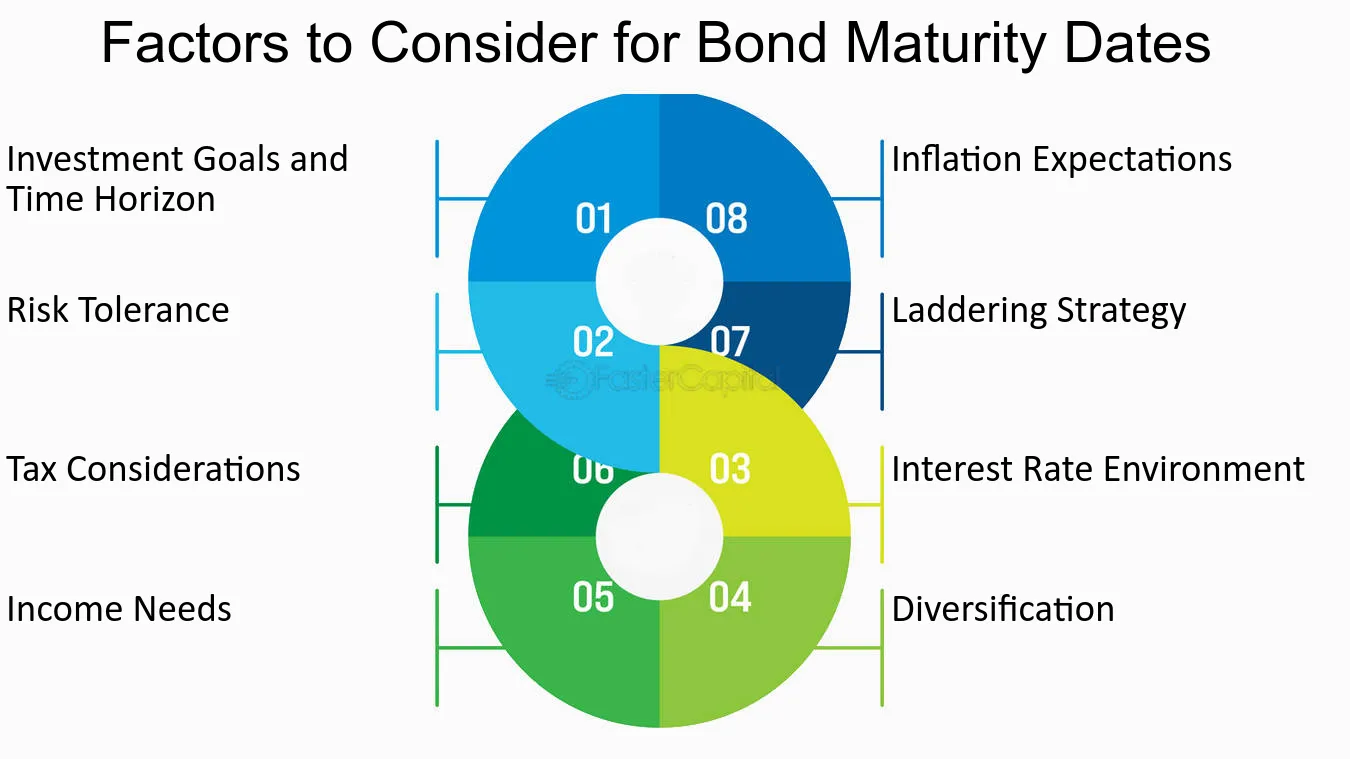
Factors to Consider for Bond Maturity Dates - Planning Ahead: Navigating Amortized Bond Maturity Dates
44. Strategies for Navigating Amortized Bond Maturity Dates
Navigating amortized bond maturity dates can be a complex endeavor, especially for investors seeking predictable income streams or those managing a portfolio of bonds with varying maturities. Bond investments, although considered relatively stable, require a thoughtful approach to maximize returns and minimize risks. In this section, we will explore strategies that can help you effectively manage your amortized bond investments, whether you're an individual investor or part of an institutional portfolio management team.
1. Diversify Maturity Dates: One key strategy is to diversify the maturity dates of the bonds in your portfolio. By holding bonds with varying maturity dates, you can ensure a steady cash flow while reducing the risk associated with a sudden influx of cash at a specific point in time. For instance, if you have a bond portfolio with only short-term maturities, reinvesting all the proceeds upon maturity might be challenging, given potentially lower interest rates. By having a mix of short, medium, and long-term bonds, you can better align your cash flow needs with market conditions.
2. Laddering: Laddering is a popular technique that involves spreading bond maturities evenly over a specific time frame. For example, a 5-year ladder could consist of bonds maturing annually over five years. This approach provides a regular stream of cash flow, offering both liquidity and the opportunity to reinvest at potentially higher rates if interest rates rise. It's a strategy that balances income with reinvestment options.
3. Yield Curve Analysis: Monitoring the yield curve is essential in managing amortized bond maturities. Understanding the shape of the yield curve can provide insights into market expectations. For instance, if the yield curve is steep, it may indicate expectations of rising interest rates. In such a scenario, you might consider shorter-term bonds to take advantage of higher yields when they mature.
4. Callable Bonds: Some bonds are callable, meaning the issuer can redeem them before their stated maturity date. As an investor, you should be aware of the call provisions in your bonds. If interest rates fall, the issuer is more likely to call the bonds to refinance at a lower rate. Consider this when choosing bonds for your portfolio, as early redemptions can impact your cash flow and reinvestment options.
5. Use Bond Funds: bond mutual funds and exchange-traded funds (ETFs) can be a convenient way to navigate amortized bond maturity dates. These funds typically hold a diversified portfolio of bonds with various maturities. They offer professional management and can simplify the process of reinvestment. However, it's important to carefully choose funds that align with your investment objectives and risk tolerance.
6. Reinvestment Plans: When a bond matures, you'll need a plan for reinvesting the proceeds. Reinvestment plans can be tailored to your specific goals. If you need a stable income stream, you might reinvest in bonds with similar maturities. If you're seeking higher returns, you can consider bonds with longer maturities or other investment vehicles.
7. Tax Considerations: Different bonds have different tax implications. For instance, municipal bonds may offer tax advantages, while interest from corporate bonds is typically taxable. understanding the tax consequences of your investments can help you optimize your after-tax returns.
8. Stay Informed: Finally, staying informed about economic conditions, central bank policies, and market trends is crucial in navigating amortized bond maturity dates. Being aware of potential interest rate changes, inflation expectations, and other macroeconomic factors can guide your investment decisions.
By employing these strategies and adapting them to your unique financial goals and risk tolerance, you can effectively manage the challenges associated with navigating amortized bond maturity dates. Remember that bond investments require careful planning, and a well-thought-out strategy can help you achieve your investment objectives while minimizing potential pitfalls.
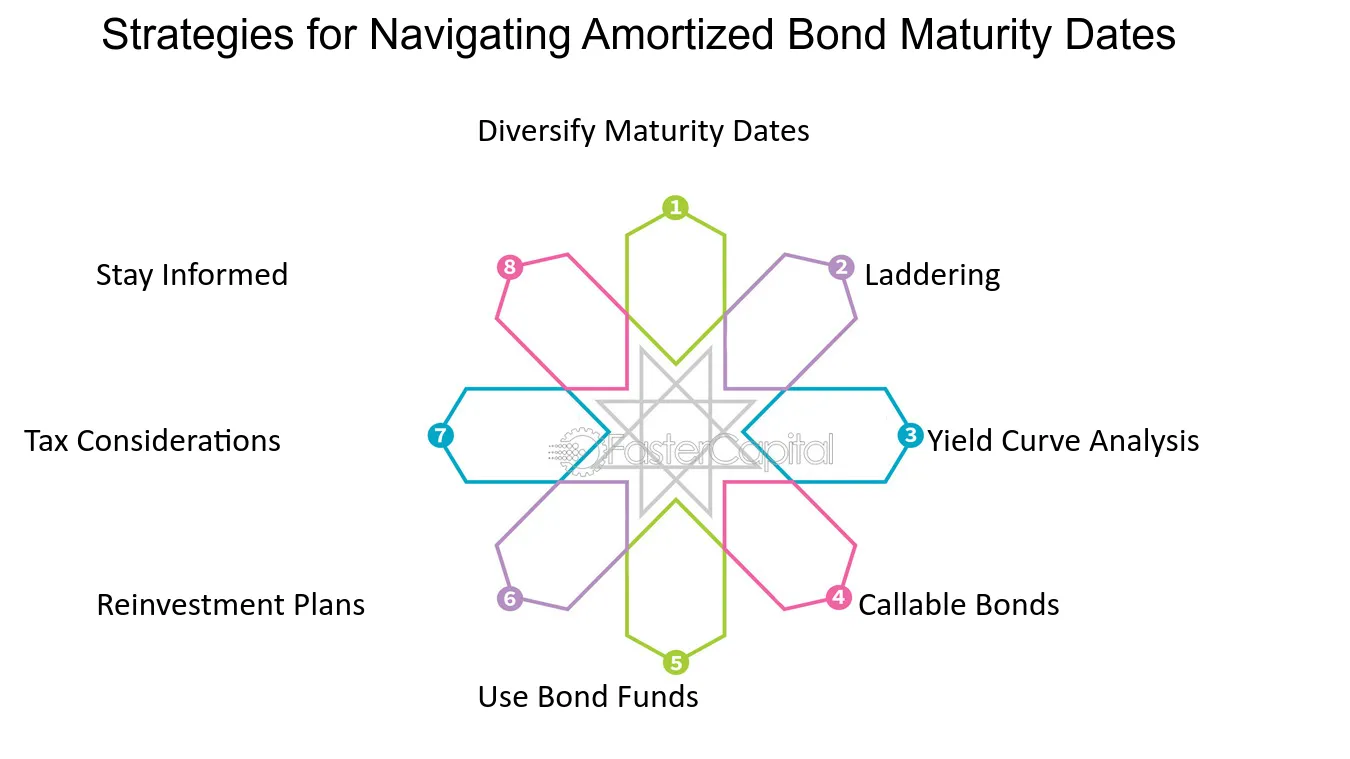
Strategies for Navigating Amortized Bond Maturity Dates - Planning Ahead: Navigating Amortized Bond Maturity Dates
45. Benefits of Diversifying Bond Maturity Dates
Diversifying bond maturity dates within your investment portfolio is a prudent strategy that holds the potential to enhance your financial security and optimize returns. Bonds are a cornerstone of a balanced investment portfolio, known for their stability and fixed-income characteristics. However, the timing of when bonds mature can significantly impact your investment goals and risk tolerance. This timing diversification strategy involves spreading your bond investments across various maturity dates. Instead of concentrating on bonds with a single maturity date, investors disperse their holdings across short-term, intermediate-term, and long-term maturities, creating a spectrum of cash flows over time.
From a risk management perspective, diversifying bond maturity dates can mitigate interest rate risk. Interest rates and bond prices have an inverse relationship: when interest rates rise, bond prices fall, and vice versa. By owning bonds with different maturities, you can navigate this relationship more effectively. Here's a closer look at the benefits of diversifying bond maturity dates:
1. Risk Mitigation: Owning bonds with varying maturities helps spread the risk associated with changes in interest rates. Short-term bonds typically have lower interest rate risk compared to long-term bonds. If interest rates rise, the impact on your portfolio is cushioned by the shorter maturity bonds that can be reinvested at higher rates when they mature.
2. Enhanced Liquidity and Cash Flow Management: Diversifying bond maturity dates ensures a steady and predictable stream of cash flows. Short-term bonds mature sooner, providing the opportunity to reinvest or access funds more frequently, allowing for better cash flow management to meet immediate financial needs or seize new investment opportunities.
3. Flexibility in Reinvestment: Multiple maturities grant investors the flexibility to reinvest their funds at various interest rate environments. For instance, if short-term rates are favorable, funds from maturing short-term bonds can be reinvested at these higher rates, potentially increasing overall returns.
4. Matching Liabilities or Financial Goals: Diversifying maturities enables investors to align their bond portfolio with their financial goals or liabilities. If you have a major expense, like funding a child's education in a few years, having a portion of bonds maturing around that time ensures you have the necessary funds without relying on volatile market conditions.
By adopting a diversified approach to bond maturities, investors can optimize their portfolios to align with their financial objectives while effectively managing risk and seizing opportunities for growth. It's a strategic step towards securing a stable financial future.
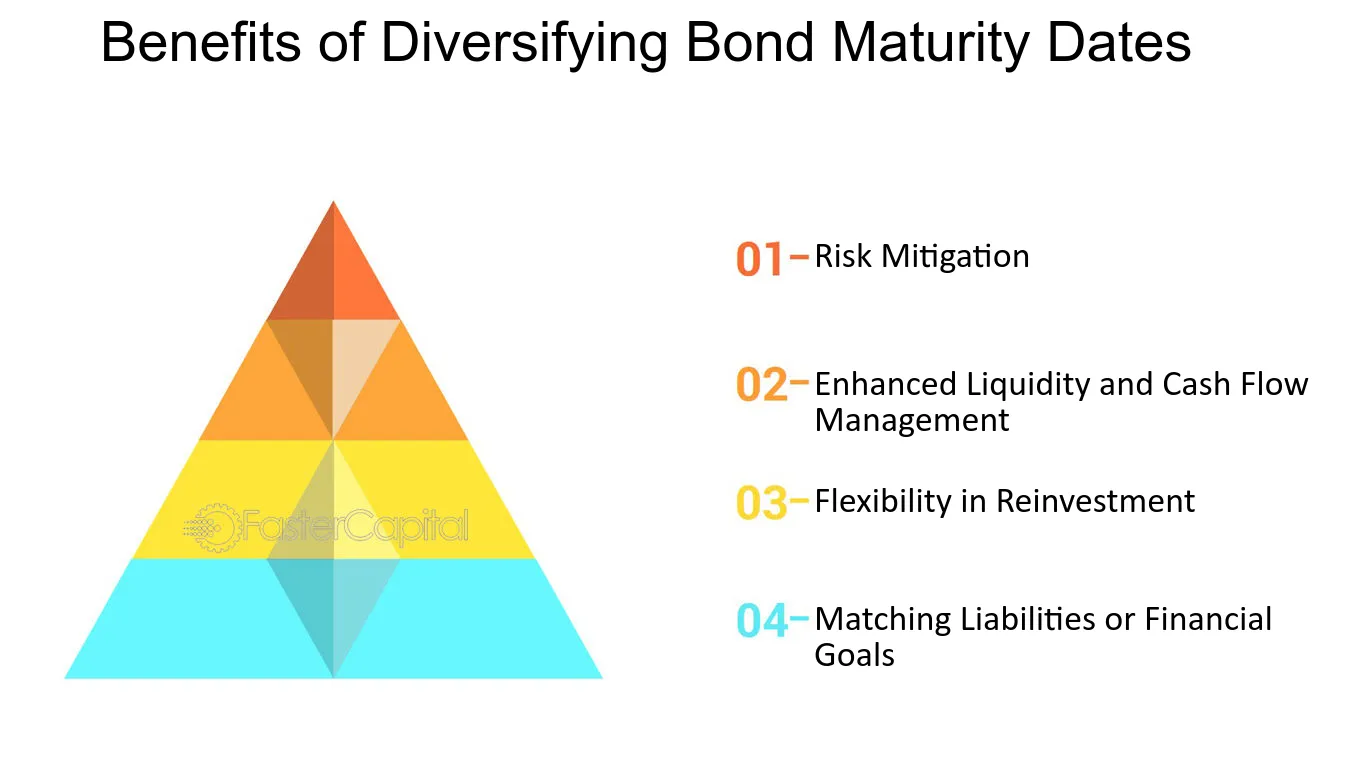
Benefits of Diversifying Bond Maturity Dates - Planning Ahead: Navigating Amortized Bond Maturity Dates
46. Risks and Challenges in Managing Bond Maturity Dates
Managing bond maturity dates is a critical aspect of any investment strategy, and it comes with a set of risks and challenges that investors must navigate. Whether you're an individual investor or a financial professional, understanding these intricacies is essential to make informed decisions. The maturity date represents the endpoint of a bond's life cycle, indicating when the principal amount will be repaid to the bondholder. It's a crucial date because it's the moment at which you can expect to receive your initial investment back, along with any accrued interest. This section delves into the potential pitfalls and complexities that can arise when dealing with bond maturity dates from multiple perspectives.
1. Interest Rate Risk: Bond prices are inversely related to interest rates. When interest rates rise, bond prices tend to fall, and when rates fall, bond prices tend to rise. This poses a risk for investors who plan to hold bonds until maturity. If market interest rates increase significantly before a bond's maturity, the bondholder may experience a loss when selling it before maturity.
2. Reinvestment Risk: When bonds mature, you receive your principal back. The challenge here is reinvesting that money, especially when interest rates have declined. You might have difficulty finding investments that offer similar yields, potentially affecting your overall portfolio's returns.
3. Default Risk: Bonds can default, which means the issuer fails to make the promised interest payments or return the principal. It's essential to assess the creditworthiness of the issuer to avoid potential losses. For example, corporate bonds from companies with a poor financial standing carry a higher risk of default.
4. Liquidity Risk: Selling a bond before its maturity can be challenging, especially for less liquid bonds or during times of market turmoil. Investors may have to accept a lower price or find it difficult to sell their bonds promptly, impacting their ability to access funds when needed.
5. Yield Curve Considerations: The yield curve reflects the relationship between interest rates and bond maturities. It can be steep, flat, or inverted. understanding the yield curve is crucial when managing bond maturities. For instance, an inverted yield curve may signal an impending economic recession, affecting your investment strategy.
6. Tax Implications: Different bonds have varying tax treatments. Interest income from government bonds may be tax-free at the federal level, while corporate bond interest is generally taxable. understanding the tax implications of your bonds is essential to optimize your after-tax returns.
7. Duration Management: Duration measures a bond's sensitivity to interest rate changes. Managing duration is vital for controlling interest rate risk. For example, if you want to reduce interest rate risk, you may consider shorter-duration bonds, which are less sensitive to rate fluctuations.
8. Call Provisions: Some bonds have call provisions that allow the issuer to redeem the bonds before maturity. Investors need to consider the potential impact of these provisions on their investment strategy, as they can affect the expected cash flows.
9. Diversification: Building a diversified bond portfolio can help mitigate risks associated with individual bond issues. Diversifying across different issuers, sectors, and maturities can enhance the resilience of your bond investments.
10. Monitoring Market Conditions: Staying informed about economic conditions and market trends is crucial when managing bond maturities. Economic indicators and central bank policies can influence interest rates, affecting the performance of your bond portfolio.
Managing bond maturity dates requires a comprehensive understanding of various risks and challenges. Investors should carefully assess their risk tolerance, investment objectives, and time horizon when creating a bond portfolio. Being aware of these potential pitfalls and adopting strategies to mitigate them can help investors navigate the complexities of bond maturity dates and make more informed investment decisions.
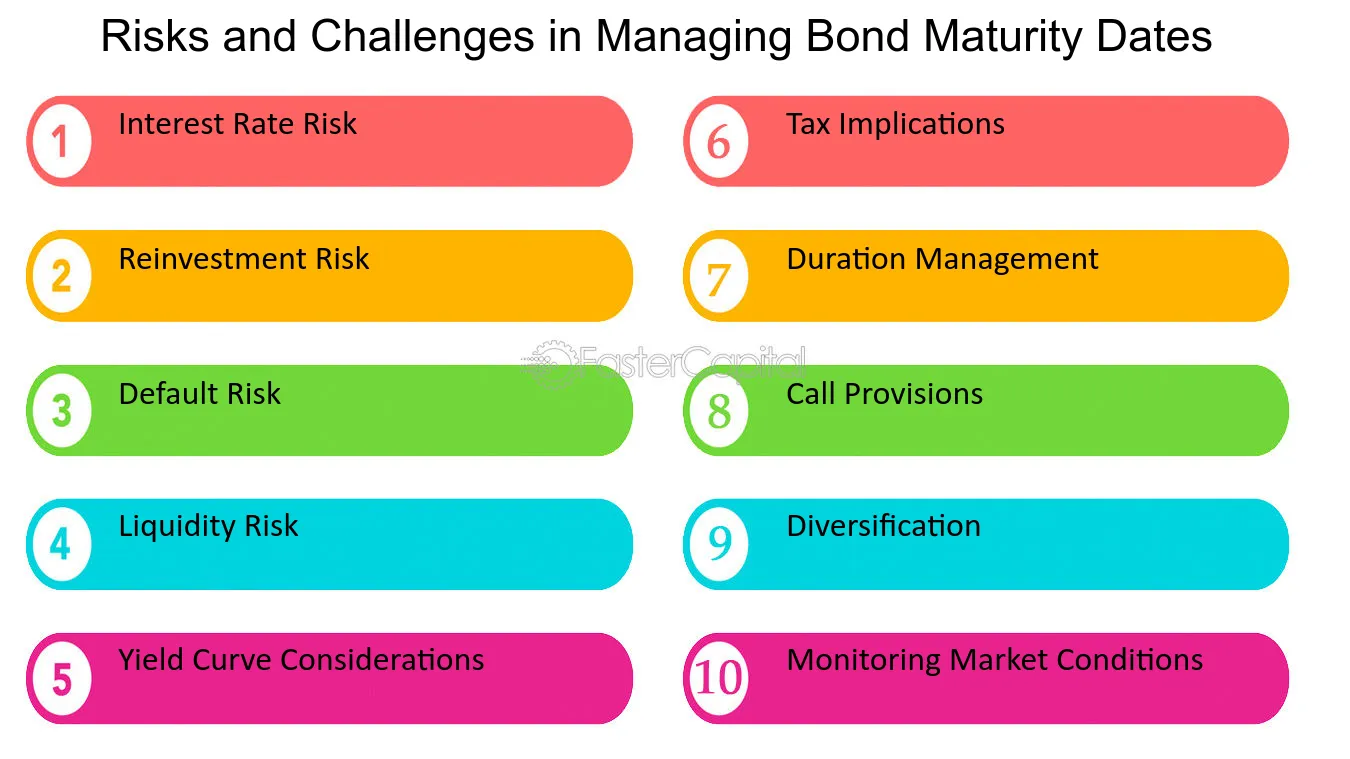
Risks and Challenges in Managing Bond Maturity Dates - Planning Ahead: Navigating Amortized Bond Maturity Dates
47. Strategies for Managing Convertible Bond Maturity Dates
Convertible bonds can be a valuable investment option for those seeking a blend of fixed income and equity exposure. These unique financial instruments offer the holder the ability to convert the bond into a predetermined number of common shares of the issuing company. However, like any investment, convertible bonds come with their own set of risks and challenges. One crucial aspect of managing convertible bond investments is navigating their maturity dates. In this section, we will explore strategies for effectively managing convertible bond maturity dates.
1. Diversify Maturity Dates: One key strategy for managing convertible bond maturity dates is to diversify holdings across various maturities. By spreading out the maturity dates, investors can avoid being exposed to a significant number of bonds maturing at the same time. This approach helps mitigate the risk of having to sell a large number of bonds during unfavorable market conditions, potentially resulting in losses. For example, an investor may hold convertible bonds with maturities ranging from one to five years, ensuring a staggered stream of maturing bonds over time.
2. Monitor Conversion Ratios: Convertible bonds come with a predetermined conversion ratio, which specifies the number of common shares the bond can be converted into. Monitoring the conversion ratio is essential, as it can impact the decision to convert or hold the bond until maturity. If the conversion ratio is favorable and the underlying stock price is expected to rise significantly, conversion may be a wise move. Conversely, if the conversion ratio is unfavorable or the stock price is expected to decline, it may be more advantageous to hold the bond until maturity. Regularly reviewing and analyzing the conversion ratios can help investors make informed decisions.
3. Assess Market Conditions: Understanding market conditions is crucial when managing convertible bond maturity dates. Evaluating factors such as interest rates, credit spreads, and equity market trends can provide insights into whether it is favorable to hold or sell a convertible bond nearing maturity. For example, if interest rates are expected to rise, it may be prudent to sell the bond before maturity to avoid potential
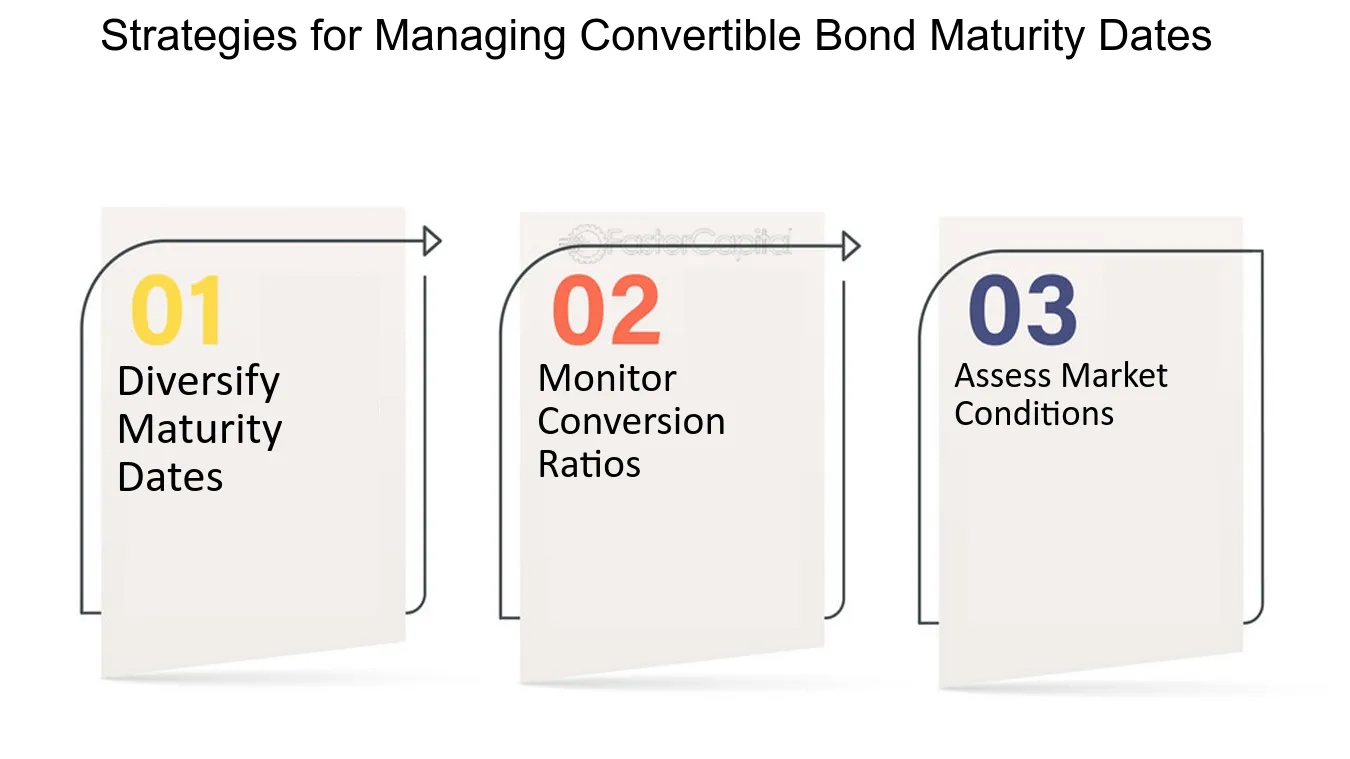
Strategies for Managing Convertible Bond Maturity Dates - Planning for the Future: Exploring Convertible Bond Maturity Dates
48. Understanding Bond Maturity and its Importance
1. understanding Bond maturity and its Importance
When it comes to investing in bonds, understanding the concept of bond maturity is crucial. Bond maturity refers to the date on which the issuer of the bond agrees to repay the principal amount to the bondholder. It is a vital aspect to consider as it directly impacts the investment's potential returns and the investor's overall financial strategy.
From the perspective of the issuer, bond maturity plays a significant role in their financial planning. By setting a specific maturity date, the issuer can determine the timeline for repaying the principal amount and adjust their cash flows accordingly. This allows them to manage their debt obligations and make informed decisions about future investments.
On the other hand, from an investor's point of view, bond maturity is equally important. It helps determine the length of time that the investor's funds will be tied up in the investment. Longer maturity periods often come with higher interest rates, providing investors with the opportunity to earn higher returns over time. However, longer maturity periods also entail higher risks as they are more susceptible to changes in interest rates and market conditions.
To gain a deeper understanding of bond maturity and its importance, let's delve into the following key points:
1.1 Types of Bond Maturity:
- Short-term Maturity: Bonds with a maturity period of one year or less are considered short-term. These bonds offer lower interest rates but are generally less risky due to their shorter duration. They are suitable for investors looking for quick returns or those with a low-risk tolerance.
- Medium-term Maturity: Bonds with a maturity period between one and ten years fall into the medium-term category. These bonds strike a balance between risk and return, offering moderate interest rates and a reasonable investment horizon. They are suitable for investors with a moderate risk appetite and a desire for stable returns.
- Long-term Maturity: Bonds with a maturity period exceeding ten years are categorized as long-term. These bonds typically offer higher interest rates to compensate for the longer duration. They are suitable for investors with a long-term investment horizon and a higher risk tolerance.
1.2 Evaluating Bond Maturity:
When evaluating bond maturity, it is essential to consider various factors to make an informed investment decision. Here are some key considerations:
- Investment Goals: Assess your investment goals and time horizon. If you have short-term financial goals, investing in bonds with shorter maturities may be more appropriate. Conversely, if you have long-term goals, longer-maturity bonds might align better with your objectives.
- Risk Tolerance: Evaluate your risk tolerance. Longer-maturity bonds are generally exposed to higher interest rate risk and market fluctuations. If you have a low risk tolerance, it may be prudent to opt for shorter-maturity bonds to minimize potential losses.
- Yield Curve: Examine the shape of the yield curve. A yield curve represents the relationship between bond yields and their respective maturities. If the yield curve is upward sloping, longer-maturity bonds may offer higher yields. Conversely, if the yield curve is inverted, shorter-maturity bonds might be more attractive.
- Diversification: Consider diversifying your bond portfolio by including bonds with different maturities. This can help mitigate risk and optimize returns by balancing the impact of interest rate fluctuations.
To illustrate the importance of bond maturity, let's consider an example. Suppose an investor has $10,000 to invest and is deciding between a short-term bond with a maturity of one year and a long-term bond with a maturity of ten years. The short-term bond offers an annual interest rate of 2%, while the long-term bond offers 4%.
In this scenario, the investor's decision would depend on their investment goals and risk tolerance. If they have short-term financial goals and a low risk tolerance, they may opt for the short-term bond to ensure liquidity and minimize potential losses. However, if they have a long-term investment horizon and a higher risk tolerance, the long-term bond may be more appealing due to its higher interest rate and potential for greater returns over time.
Understanding bond maturity and its significance is crucial for both issuers and investors. By carefully considering the various factors discussed above, investors can make informed decisions about bond maturity that align with their financial goals and risk tolerance. Whether opting for short, medium, or long-term bonds, striking the right balance is key to maximizing returns while managing risk effectively.
49. Evaluating Bond Maturity through Principal Market Discount
1. Bond Maturity and Principal Market Discount
When evaluating bond maturity, one important factor to consider is the principal market discount. This refers to the difference between the face value of a bond and its market price at a given point in time. Understanding how bond maturity affects the principal market discount can provide valuable insights for investors.
From the perspective of bond issuers, a longer maturity period may lead to a higher principal market discount. This is because as time passes, the risk associated with the bond increases. Bond issuers compensate for this risk by offering a lower market price, resulting in a higher discount. On the other hand, from the viewpoint of bond investors, a higher principal market discount may present an attractive opportunity to purchase bonds at a lower price, potentially leading to higher returns in the future.
2. Evaluating Bond Maturity Options
To evaluate bond maturity through principal market discount, it is essential to consider various options and their implications. Here, we will compare two bond options with different maturities to illustrate the concept.
Example 1: Bond A has a face value of $1,000 and a maturity period of 5 years. At the current market price, the bond is trading at a principal market discount of 10%. This means that investors can purchase the bond for $900, representing a $100 discount from its face value.
Example 2: Bond B, on the other hand, has the same face value of $1,000 but a shorter maturity period of 2 years. The bond is trading at a principal market discount of 5%, resulting in a market price of $950.
3. Comparing Options and Determining the Best Choice
When comparing Bond A and Bond B, it becomes evident that Bond A offers a higher principal market discount of 10% compared to Bond B's 5%. This means that investors have the potential to enjoy a larger discount and potentially higher future returns with Bond A.
However, it is important to consider the trade-off between the principal market discount and the time value of money. Bond A has a longer maturity period of 5 years, meaning investors will have to wait longer to receive the bond's face value. On the other hand, Bond B has a shorter maturity period of 2 years, allowing investors to receive their principal amount sooner.
Investors should carefully weigh their investment goals and risk tolerance when evaluating bond maturity through principal market discount. While a higher discount may be enticing, it is crucial to consider the time horizon and the potential impact of the discount on overall returns.
Evaluating bond maturity through principal market discount requires a comprehensive analysis of various factors. While a higher principal market discount may present an attractive opportunity for investors, it is essential to consider the trade-offs and align investment goals with the chosen maturity period. By understanding the relationship between bond maturity and principal market discount, investors can make informed decisions to optimize their investment portfolios.
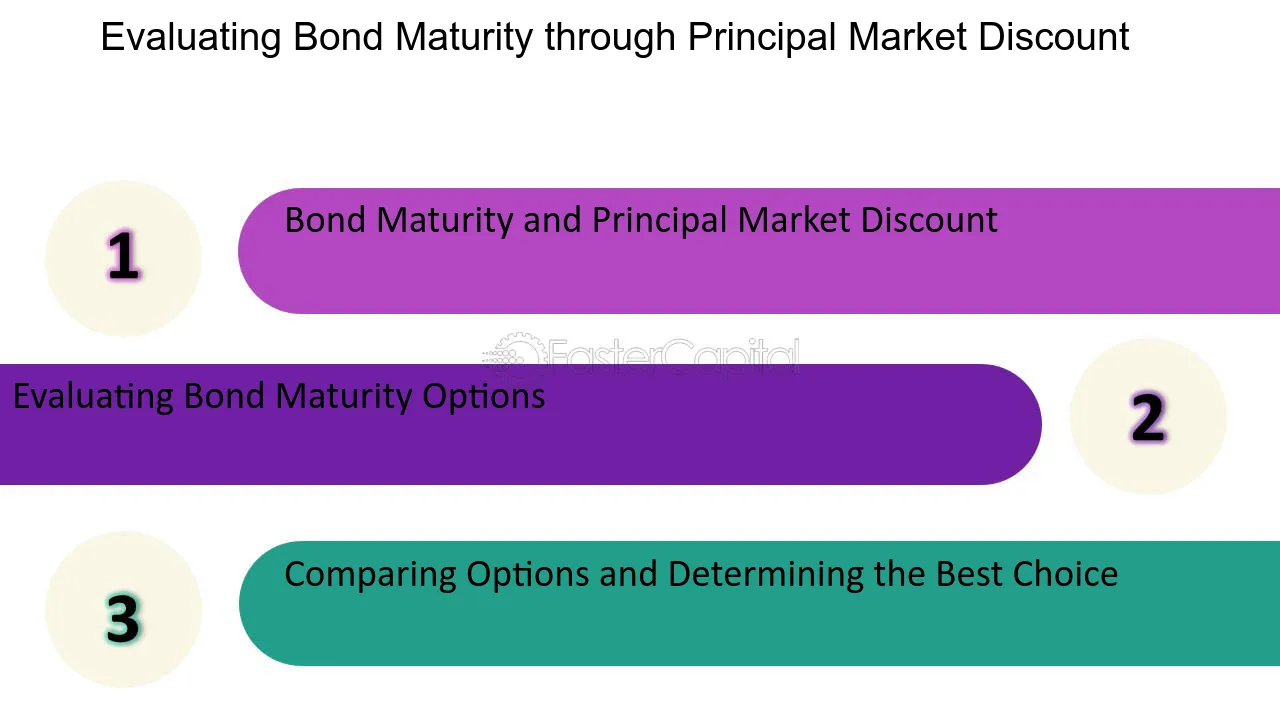
Evaluating Bond Maturity through Principal Market Discount - Principal and Accrued Market Discount: Evaluating Bond Maturity
50. Analyzing Bond Maturity through Accrued Market Discount
1. In the world of bond investing, understanding bond maturity is crucial for evaluating the potential returns and risks associated with a particular investment. While the maturity date represents the point at which the issuer repays the principal amount to the bondholder, it is equally important to consider the concept of accrued market discount. Accrued market discount refers to the difference between the purchase price of a bond and its face value at any given point in time. This discount, which accumulates over the life of the bond, can have a significant impact on an investor's overall return.
2. From the perspective of a bondholder, the accrued market discount provides an opportunity to potentially enhance the total return on an investment. As the bond approaches maturity, the market discount gradually decreases, eventually converging with the face value of the bond. This implies that an investor who purchases a bond at a discount will not only receive the principal amount at maturity but also benefit from the gradual reduction in the discount. Consequently, the investor may realize a higher yield than initially anticipated.
3. On the other hand, from the issuer's standpoint, accrued market discount poses a liability that needs to be accounted for. As the discount accumulates over time, the issuer must allocate a portion of the interest payments towards reducing this discount. Failure to do so may result in a higher cost of borrowing for the issuer, as investors may demand a higher yield to compensate for the perceived credit risk associated with an accumulating discount.
4. To gain a better understanding of the impact of accrued market discount on bond maturity, let's consider an example. Suppose an investor purchases a bond with a face value of $1,000 at a discount of $100. Over the course of five years, the bondholder would receive annual interest payments of $50. However, a portion of this interest payment would be allocated towards reducing the accrued market discount. As a result, the bondholder would receive a gradually increasing amount of interest each year, until the discount is fully depleted by the time the bond matures.
5. When evaluating bond maturity, it is important to consider various options and compare their potential benefits. One option for investors is to purchase bonds with longer maturities, as this allows for a longer period to benefit from the reduction in accrued market discount. However, this approach also entails a higher degree of interest rate risk, as longer-term bonds are more sensitive to changes in interest rates. Alternatively, investors may choose to focus on bonds with shorter maturities, sacrificing potential discount reductions for greater liquidity and lower interest rate risk.
6. In conclusion, analyzing bond maturity through accrued market discount provides valuable insights for both bondholders and issuers. Bondholders can potentially enhance their total return by purchasing bonds at a discount and benefiting from the reduction in accrued market discount over time. However, issuers must account for the liability posed by accrued market discount and allocate a portion of interest payments towards reducing this discount. Ultimately, the choice of bond maturity should be carefully considered, weighing the potential benefits of discount reduction against the associated risks.
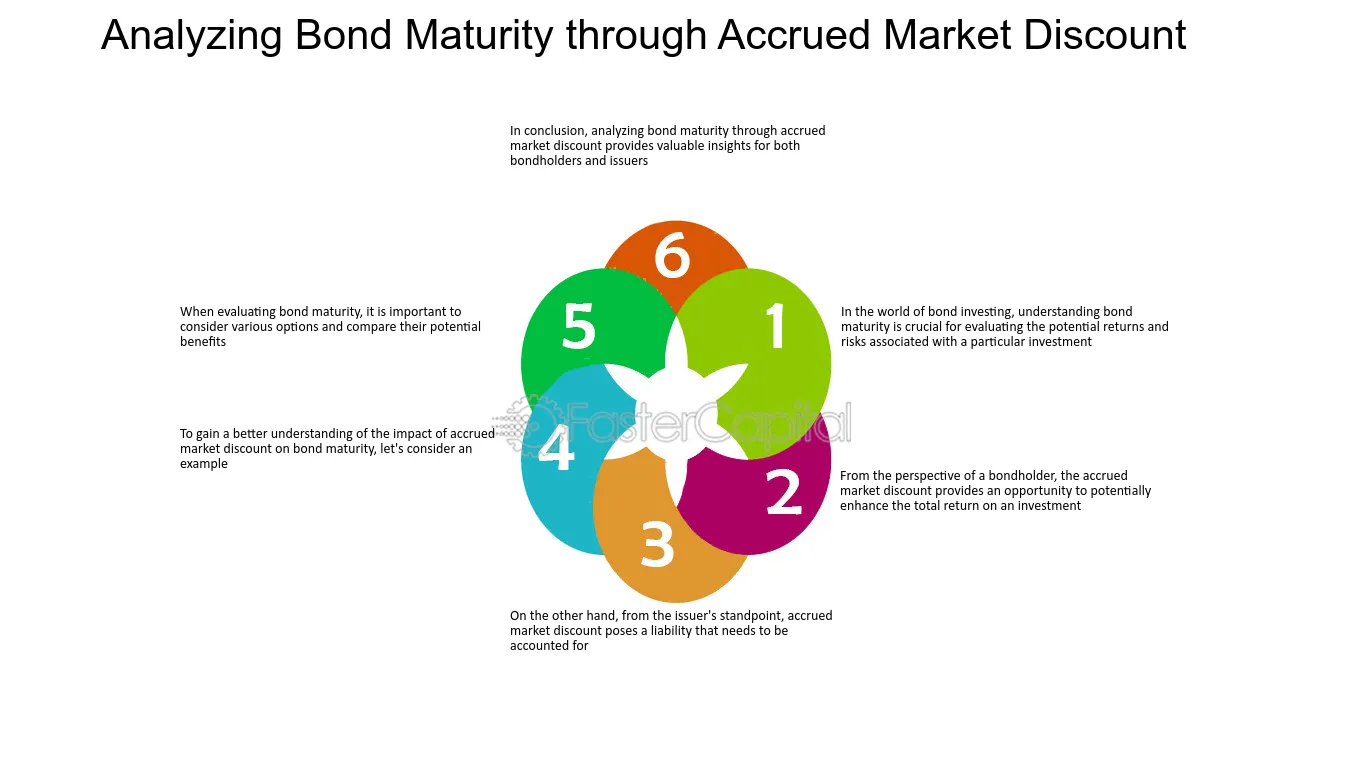
Analyzing Bond Maturity through Accrued Market Discount - Principal and Accrued Market Discount: Evaluating Bond Maturity
51. Introduction to Serial Bond Maturity
When it comes to investing, there are several options available to investors. One such option is serial bonds, which are issued in a series, with each series having a different maturity date. Serial bond maturity can be a useful tool for balancing risks and rewards, as it allows investors to adjust their portfolio and investment strategy over time. However, before investing in serial bonds, it's important to understand how they work and the various factors that can impact their value.
To help you better understand serial bond maturity, here are some key insights to keep in mind:
1. Series Structure - Serial bonds are typically issued in a series, with each series having a different maturity date. For example, a company may issue a series of bonds that mature in 3 years, followed by another series that matures in 5 years, and so on. This allows investors to choose the series that best fits their investment goals and time horizon.
2. Risk vs. Reward - One of the benefits of serial bond maturity is that it can help investors balance their risks and rewards. For example, if an investor wants to minimize risk, they may choose to invest in a series of bonds that have a shorter maturity date. On the other hand, if they are willing to take on more risk in exchange for higher potential returns, they may choose a series with a longer maturity date.
3. interest Rates - The interest rate on a bond is a key factor that can impact its value. Generally speaking, bonds with longer maturities will have higher interest rates to compensate investors for the additional risk they are taking on. However, this isn't always the case, and interest rates can fluctuate over time.
4. Creditworthiness - The creditworthiness of the issuer is also an important consideration when investing in serial bonds. If the issuer has a strong credit rating, the risk of default is lower, which can make the bonds more attractive to investors. However, if the issuer's credit rating is lower, the risk of default is higher, which can make the bonds less attractive.
In summary, serial bond maturity can be a useful tool for investors looking to balance risks and rewards. By understanding the various factors that can impact the value of serial bonds, investors can make informed decisions about their investment strategy and portfolio allocation.
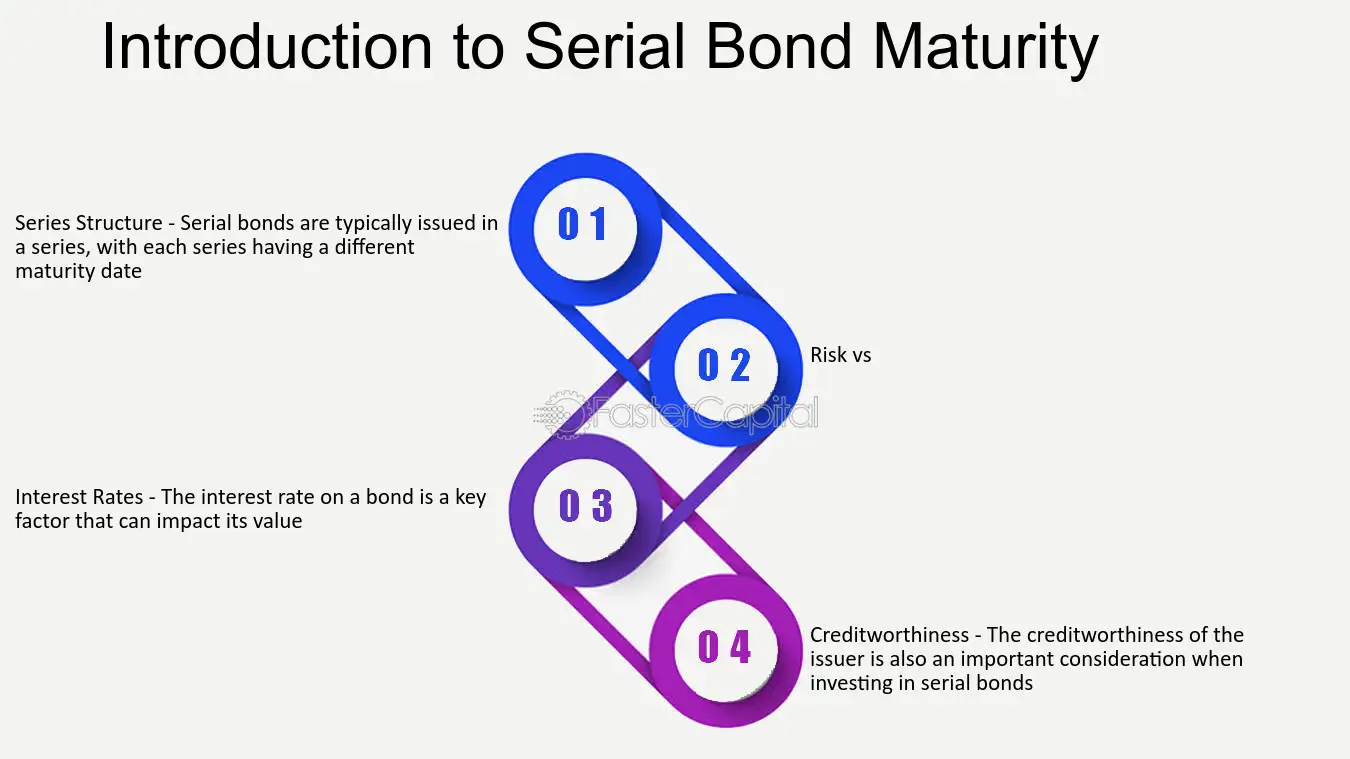
Introduction to Serial Bond Maturity - Serial bond maturity: Balancing risks and rewards